Choose Trek
Customise Trek
Suggest me a trek
Rent a gear
Volunteer Program
Blogs & Articles
Discounts & Offers


Chadar Trek Frozen River
Max Altitude
Trekking KM.
26,500 /Person
- +5% GST (Goods and Services Tax)
- Hotel to Hotel
- Centrally heated room & Hot water included
Help & Support
- +91 991 772 4737
- 10:00 hrs to 18:00 hrs Monday - Saturday GMT +5:30 Sunday Closed
- [email protected]
- Cost & Cancellation Terms
- Risk & Respond
How To Reach
Trek essential, important links.
- Trail Type One way trail, The trek starts and ends at Shingra Koma.
- Rail Head No Rail Head
- Airport Leh (Kushok Bakula Rimpochee) Airport
- Base Camp Leh
- Winter Treks (Mid Nov - Mid Feb)
- Snow January & February
- Services from Hotel to Hotel
- Meals Meals while on trek (Veg + Egg)
- Stay Centrally Heated Hotel with hot water & Camping (2 in one tent)
- Region - Ladakh
- Duration - 8 Days
- Grade - Difficult
- Max Altitude - 11100 Ft.
- Approx Trekking Km - 62 Kms.
WHY IS IT A MUST-DO TREK?
The Chadar Frozen Trek , located in the northernmost part of India in the region of Ladakh, is one of the worlds most iconic and challenging treks. The trek takes adventurers on an extraordinary journey along the frozen Zanskar River offering a unique opportunity to explore the starkly beautiful and remote landscapes of Ladakh, complete with breathtaking ice formations and an incredible cultural experience.
The Chadar Trek takes place in the Zanskar region of Ladakh, India. The trek begins near the village of Chilling and extends through the frozen Zanskar River. The Chadar Frozen Trek occurs during the coldest months of the year, typically from January to February when the Zanskar River freezes over. This is the only time when its possible to undertake this unique adventure. Winter temperatures in the Zanskar region can plummet well below freezing, often reaching as low as -30°C (-22°F) during the night.
For those seeking a rare and challenging experience in the Himalayas, Chadar Trek is the ultimate choice.
Frozen Landscape
The trek takes you through a surreal frozen wonderland, where the Zanskar River transforms into a solid ice sheet. Trekking on the Chadar , or frozen riverbed, is a remarkable experience.
Nerak Waterfall
Nerak Waterfall, often referred to as Nerak Waterfall Camp, is a significant milestone on the Chadar Frozen Trek . This awe-inspiring site is a cascade of frozen ice that has formed as a result of the chilling temperatures in the Zanskar region.
Tibb Cave is another remarkable feature along the Chadar Trek . It s a naturally formed overhang in the rocky cliffs along the frozen river. This natural shelter provides trekkers with a respite from the biting cold and wind, offering a place to rest, warm up, and even prepare meals.
Who can participate
- Age; 15 years.
- Experience of any high altitude trek, at least 1 treks of 4,000m/13,100ft.
- The climber must be fit and have sufficient stamina to cover 5 km of distance in 30 minutes without a stress.
- The climber should be able to carry a 12-16 kg backpack.
Health Awareness
- Pulse rate at rest must be in between (60 to 90 beats per minute)
- Blood Pressure Reading must be in between (DIASTOLIC 75 – 85, SYSTOLIC 100 - 130 mm Hg)
- Respiratory rate at rest must be in between (12 to 20 breaths per minute)
- Should not have Liver and kidney issues
- Should not have Diabetes Mellitus, Bronchial Asthma, Epilepsy, Heart problems, Hypertension etc
- No pacemaker implant
- People with the Sinus issues please contact to trek coordinator before booking the trek
- If your BMI is not normal, Please contact our Trek coordinator before Trek booking.
Government Employees {SCL}
Government Employees can avail the benefit of Special Casual Leave (SCL) when you join us for a trekking expedition. As per the rules of the Pay Commission, Special Casual Leave can be availed for up to 30 days in a calendar year for trekking/mountaineering expeditions through a registered organization. Trek The Himalayas is a registered adventure tour operator by Indian Mountaineering Foundation (IMF) and Ministry Of Tourism (MOT) Trekkers have to apply for leave at least 20 days before trek departure date.
- Junior trekkers (below 15 years) should have a company of parent/guardian.
- Trekkers between 15 to 18 years can come solo with the disclaimer form signed by parent/guardian.
- Medical & Disclaimer Form (Mandatory Documents) Click here
- Altitude: Leh 3,500m/11,450 ft.
- Keep your woolen cap and gloves handy at Airport.
- Airport pickup is not included in the cost.
- Orientation & Briefing of the trek at 12:00 noon (Mandatory).
- Check in Hotel (10:00 am | centrally heated room |attached washroom in running condition | hot water in buckets.
- Bring a copy of your ID proof and 2 photographs. Foreigner, a copy of passport and visa.
- Keep the boarding pass with you, it will be needed for permission on the third day.
- The network is available (only post-paid).
- ATM is available.
- Visiting any very high-altitude place or pass is not advisable.
- Consumption of alcohol and smoking is strictly prohibited.
- Spend the day in the room itself to acclimatize.
You will be landing at the Leh airport which is one of the most picturesque airports that you would come across. Just before touchdown time, you’ll be greeted with the entire range of snow-capped peaks that will surely get you wonderstruck. It’s important to keep your warm clothes handy as you’ll feel the sudden drop in temperature as soon as you arrive at the Leh airport. A jacket, woollen gloves, and a woollen cap are a necessity. After reaching the guesthouse you will be given enough time to relax and acclimatize to the conditions. Later in the evening, you can spend some time at the Leh market for any last-minute shopping. It is very important that you get used to the cold temperature in Leh because the temperature will only tend to fall as you start walking on the frozen Zanskar. From the end of January to mid-February, the temperature can be anything between -10 to -15 degrees during the day. It is also important to keep your body hydrated by increasing the intake of fluids that will help to maintain your body temperature.
- Rest + Acclimatization day
- Sightseeing included in the cost ( Hall of Fame, Shey Monastery, Thiskesy Monastery )
- A visit to any very high-altitude place or pass is not advisable
- Consumption of alcohol and smoking is strictly prohibited
- Stay in hotel | centrally heated room | attached washroom in running condition | hot water in buckets
Keeping in mind the health problems that trekkers are facing (AMS), as per the new regulations applied, anyone doing the Chadar Trek should spend at least two days in Leh to get their body fully acclimatized to the weather conditions. It is irrevocable and it is important that it is strictly followed by every trekker. You can spend the day visiting the places around the city. You can also join us while we conduct a small sightseeing session (included in the cost). It is only for 3-4 hours, covering all the major spots of Leh. It is advisable that you avoid visiting places that are at a higher altitude. Crosscheck your essentials before going to bed.
- Wake up early and get ready for medical tests | height & weight, blood pressure and oxygen level.
- Drive/Walk to the Government Medical camp.
- Get your Oxygen and BP reading (There is a long queue due to rush of tourists. It may take 3-4 hours depending on the rush).
- Late afternoon insurance formalities.
- Enjoy evening in Leh.
- Stay in Hotel | centrally heated room |attached wash room in running condition | hot water in buckets.
Today is the big day. This day decides whether you continue further or not. Wake up early and reach the Medical Camp as early as possible. Even though tests take less time, due to tourists rush it gets delayed. In the late afternoon, we shall finish insurance formalities, if any. Your test results are your green card as to whether you will do the Chadar Trek or not so, in case the tests declare you are not fit to go for the Chadar Trek , you will not be allowed. For refund policies please contact our trek coordinator.
- Altitude: Tsomo Paldar 3,200m/10,500 ft.
- Altitude: Shingra Koma 3,150m/10,300
- Breakfast at hotel included in the cost.
- Drive: Shingra Koma 75 km, 3-4 hrs.
- Trek: 3km | 2 hr.
- Gumboots are mandatory.
- Carry two thermos flask of 1 litre each.
- Hot lunch on the way.
- Stay in tents | twin sharing.
- Drive through Gurudwara Pathar Sahib (3,500m/11,500ft), Magnetic Hill (3,350m/11,000ft) and the confluence of the Zanskar and Indus (3,100m/10,200ft).
Note: Walking in gumboots will take a while, so be prepared for some slips and falls! It’s advisable to carry a small backpack which will protect your back at the time of falls.
On this day, you’ll be headed to the first campsite which is Tsomo Paldar via Chilling & Shingra Koma. Shingra Koma is one of the most unique places in Chadar for it is placed at the U bend of Zanskar, forming a wonderful place with lots of views. Today will be one of the most scenic drives which let you witness some of the top spots in Ladakh. Gurudwara Pathar Sahib, Magnetic Hill, and the confluence of the Zanskar and Indus are some of the places where you can make a pit stop for clicking pictures 3-4 hours drive along the Zanskar will get you to Shingra Koma. The car will drop you right where the road ends, this will be your starting point of walking on the Zanskar.
The layer of Chadar may seem thin here, you can also see various rock formations. Walking with gumboots on will definitely be a challenge in the initial stage. Understanding the ice patterns will take time, slowly but steadily you will know which surface is fragile and which is trustworthy. There are multiple ice surfaces that you would come across while walking on the mighty Zanskar. Planting your foot will be important in most cases, you can check for the ice for its steadiness with your walking stick before stepping on it completely. A small and light backpack will help you to manage your body weight in an effective manner. After an hour and a half of walking on the icy surface maintaining your balance you’ll be reaching your first campsite at Tsomo Paldar. This will be your first experience of camping under sub-zero temperatures.
- Altitude: 3,350m/ 10,950 ft.
- Trek 14km | 6-7hr.
- Make sure you fill your thermos with warm water before you leave.
- Pass through a waterfall which never freeze.
- It will be sunny only around 9-10 in the morning.
- Hot Lunch on the way.
- Visit small cave, in that cave the local porters rest for the night.
Chadar is one such trek where you do not gain altitude in quick succession. Slowly but gradually from Tsomo Paldar to Tibb Cave (6-7 hours), you will be gaining an altitude of 400ft. (Tsomo Paldar: 11,400 to Tibb Cave: 11,800). After spending a cold night in the tent at Tsomo Paldar get done with your breakfast that will re-energize your senses in the morning. The much-needed hot cup of tea will be special in such frosty conditions. As you start heading to the next campsite which is Tibb Cave, you’ll see some of the most eye-catching frozen waterfalls. Waterfalls that stand frozen in time. The source of some of these frozen waterfalls is still unknown and there are a lot of myths amongst the villagers. The mighty Zanskar will be flowing all along with you on the trail and the emerald green water will have a soothing effect. You will be served lunch midway to Tibb Cave. After walking for a couple of hours you’ll come across different rock patterns along the way which look like art when the sun rays fall on them making their way from behind the clouds. You will be camping near the Tibb cave which is surrounded by dry sand.
- Altitude: 3,400m/11,100 ft.
- Trek 13 km / 6-7 hrs.
- Attraction Frozen waterfall.
- Nerak is the first village of Zanskar region.
- If we reach Nerak Camp on time, we can go to Nerak village.
- Stay in tent.
As you move on to the most awaited campsite of the trek which is Nerak, the 13 km long trail will take you to the most iconic landmark of the Chadar trek . i.e. the frozen waterfall. The frozen waterfall is a nature’s masterpiece that attracts trekkers from around the world. Hot lunch will be served on your way to Nerak. By far, Nerak will be the coldest of all the campsites on the trek where the temperature goes down to as low as -30 degrees during the night. It will be important that you wear proper clothing in layers to stay safe from the biting cold. If you manage to reach the waterfall on time, there are chances of paying a visit to the Nerak Village as well. You will be camping at a distance of 15-20 minutes from the waterfall.
- Altitude 3,400m/11,100 ft to 3,350m/10,950 ft
- Trek 13 km / 5-6 hrs.
You might have heard stories of how unpredictable the weather patterns can get here on the Chadar trek . There are instances where the formation of Chadar no longer exists on your way back from Nerak. In the same way, you will witness a new layer of Chadar formed in some places. Even though it’s the same route, you’ll be amazed to see how different it appears while coming back. Chadar Trek is the experience of a lifetime that every trekking enthusiast should witness. And then, what if we told you that these eight days of your life are going to be some of the best days you’ve l ived so far and that you’ll cherish these moments till the very end.
Today retrace your steps back to Tibb Cave. You get another last chance to cherish, relive and gather the memories. Wave goodbye to all the locals while you make your way back. Be careful and enjoy your last stay in tents.
- Altitude 3,350m/10,950ft to 3,150m/10,300 ft.
- Trek to Shingra Koma 17 km/ 5-6 hours.
- Drive to Leh 70 km/ 3-4 hours.
- You will reach Leh by the evening.
- Stay in hotel (Centrally heated room) (Running hot water in taps).
Note: Distance, Altitude and Trekking hours are approximate and round off.
Again wake up early for a long walk back. It is not really retracing steps because you may observe a lot has changed. Chadar may have melted, a layer of Chadar may have gotten thin, and wonderful rocks are visible now. Well, that’s the beauty of nature and the Chadar trek. Reach Shingra Koma and get ready to board vehicles. Another bumpy ride and you will arrive in Leh.
- Pick Up Place
The only way to travel is to fly to Kushok Bakula Rimpochi Airport located in Leh. It is just 4 km away from the main city. The airport is well connected to Delhi and also receives flights from Mumbai, Srinagar, Jammu, Chandigarh and other general destinations in India. Even international travellers can fly directly from major cities like Kolkata, Mumbai and Delhi.
Travelling by both the road routes, the Manali-Leh Highway and Srinagar-Leh Highway, is not possible since they are not open in the snowy winters of Ladakh.
The Manali-Leh and Srinagar-Leh highways are generally closed by October-November
Pick up will be done according to flight timings
We will drop you at Leh Airport, Please check out early in the morning because all flights fly in the morning only.
- Cancellation Policy
Inclusion 1. Accommodation : (as per the itinerary). • Guest house (centrally heated room)(attached washroom) in Leh on Day 1, Day 2, Day 3 & Day 8 (twin sharing basis, triple in very rare cases). • Camping during the trek (Day 4 to Day 7). 2. Meals (Veg + Egg): • Day 4 breakfast to day 8 lunch. 3. Trek equipment: • Hight Quality High Altitude Sleeping bag, Mattress, Utensils. • Trekkers tent (twin sharing), Kitchen & Dinning tent, Toilet tent, Ropes. 4. First aid: • Medical kit. • Stretcher. • Oxygen cylinder. 5. Support: • 1 Mountaineering qualified & professional trek Leader. • Guide (Number of guides depending on the group size). • 1 High Altitude chef. • Support staff. 6. Transportation: (as per the itinerary) • Leh (Guest house) to trekking point (Day 4). • Trekking point to Leh (guest house) (Day 8). 7. Hot water • Hot water in buckets on Day 1, Day 2, Day 3 . • Running hot water in taps on Day 8 . 8. Leh Sightseeing is included in the cost (Hall of Fame, Shey Monastery, Thiksey Monastery). 9. Facility of keeping extra luggage at Leh when leaving for the trek. 10. Porters to carry the central luggage. 11. Services from Leh and Leh.
Exclusion: 1. Food in Leh. 2. Any kind of personal expenses. 3. Porter to carry personal luggage. 4. Pre Medical Check-up and Rescue fee, Wildlife/environmental charges, ALTOA NOC, and entry fees upto 6K to 8 K paid to the authority on the spot 5. Pickup and drop from Leh airport 6. Any kind of emergency evacuation charge, hospitalization fee or etc. 7. Any additional cost due to the final decision incurred by the Administrative 8. Insurance: It is mandatory to take high altitude risk insurance before joining this Expedition (as per the ALTOA guidelines) 9. Anything not specifically mentioned under the head.
Things can be provided on demand and availability (participant has to pay extra for these things)
1- Satellite phone/setphone - a type of mobile phone that connects via radio links via satellites orbiting the Earth instead of terrestrial cell sites like cell phones. Therefore, they can operate in most geographic locations on the Earth's surface.
2- Gamow/PAC HAPO Bag (Portable Hyperbaric Bag) - is a unique, portable hyperbaric chamber for the treatment of acute mountain sickness (AMS), also known as altitude sickness.
3- AEDs (Automated External Defibrillators) - are portable life-saving devices designed to treat people experiencing sudden cardiac arrest, a medical condition in which the heart stops beating suddenly and unexpectedly
Insurance is mandatory and can be obtained through TTH or other providers. Non-Indian rates are slightly higher, trek coordinator will share the balance payment link after booking. If you choose not to book through us, we will refund your insurance fee; email us immediately after booking for the refund.
Porter Service Charges: Normally TTH expects to carry your personal luggage on your own, if you don't want to carry your backpack so you can give it to the porter, but you have to inform us in advance and have to pay approx Rs. 5000 for the entire trip (subject to change)/- extra per bag.
The fee can be paid by online transfer/Check deposit/Cash deposit/Demand draft. Instruction for payment will be forwarded along with your confirmation email. When your transfer is done, please e-mail us a confirmation mail with your transfer details, so that we can follow up your reservation efficiently.
Cancellation terms:
For the cancellation of services due to any avoidable/unavoidable reasons, Trek The Himalayas must be notified of the same in writing at [email protected] At the time we receive your written cancellation, refunds based on the total fare are as follows.
Cancellations prior to 25 days from the start of the Trip
Refund options
- 5% deduction of trek fee
- 100% cash voucher for any trip till one year
Cancellation between 24 days and 15 days to the start of the Trip
- 30% deduction of trek fee
- 100% cash voucher for same trip till one year
- 85% cash voucher for any trip till one year
Cancellation between 14 days and 10 days to the start of the Trip
- Book the same trek, in the same season, with any other batch
- 50% deduction of trek fee
- 80% cash voucher for same trip till one year
- 70% cash voucher for any trip till one year
Cancellation less than 9 days to the start of the trek
- Transfer your trek (same trek, same batch) to your friend
- No cash refund
- 20% cash voucher for the same trip till one year
- 10% cash voucher for any trip till one year
In the unlikely event that TTH cancels a trek prior to the scheduled departure date:
While it is extremely rare for TTH to cancel a trek, we understand that unforeseen circumstances or natural disasters may occasionally require us to do so before the scheduled departure. These circumstances could include continuous rain or snow, thunderstorms, snowstorms, landslides, floods, earthquakes, or any other natural calamity that poses a risk to the safety of our trekkers. Additionally, unforeseeable events such as local riots, curfews, pandemics, lockdowns, government orders, or any similar situations that compromise the safety of the trekking experience may also necessitate a cancellation.
In the event of such a cancellation, TTH will provide you with a voucher equivalent to the amount you paid for the trek. This voucher can be redeemed for any of our treks within the next year, allowing you to still enjoy an adventure with us at a later date.
- The issuance of a voucher is not applicable in situations where you are required to descend from the trek for any reason. The trek leader may make the decision to send you down from the trek due to factors such as insufficient fitness level, symptoms of Acute Mountain Sickness (AMS), high blood pressure, exceeding the designated turn-around-time, health concerns, or if you are found smoking, drinking, or violating the rules set for the trek. In such cases, the provision of a voucher does not apply.
In the rare event that TTH shifts a trek:
We would like to emphasize that weather conditions in high-altitude areas are highly unpredictable and can undergo sudden changes at any time, irrespective of the day. Additionally, circumstances beyond our control, such as natural disasters, political unrest, pandemics, and lockdowns, may impact the feasibility of conducting a trek. In cases where we are unable to proceed with an event due to such circumstances that are beyond our direct control, we will make every effort to provide you with an alternative trek that is safer and more suitable.
In such situations, we will issue a voucher to offset the cost difference between the originally scheduled trek and the alternative trek. This voucher can be redeemed at any time within one year from the date of issue. Please note that a refund fee or reimbursement of the cost difference is not applicable in these cases.
- Change of trek batch is dependent on the availability of seats in the batch
- In case of transferring a trek to a friend, he/she should satisfy all the mandatory requirements put forward by TTH
- TTH holds the right to change/cancel the policies, without prior notice
- Cash refund is applicable only in case of bookings made without using any promotional offer code or vouchers
Cash Voucher Terms:
- This is a non-transferable voucher
- The voucher cannot be merged with any other offer of Trek The Himalayas
- The voucher is valid for Trek booked directly with Trek The Himalayas in India
- To avail the voucher please use your register phone number or e-mail id
- All the other Terms of booking a trek with Trek The Himalayas are applicable to the voucher
- Trek The Himalayas holds rights to add/remove any of the Terms and Conditions without prior notice
Itineraries are based on information available at the time of planning and are subject to change. "Trek The Himalayas" reserves the right to change expedition dates, people or itineraries as conditions warrant. If a trip must be delayed or the itinerary changed due to bad weather, road conditions, transportation delays, government intervention, airline schedules, sickness, or other contingency for which TTH or its agents cannot make provision, the cost of delays and/or other changes are the responsibility of the participant. TTH reserves the right to decline, or accept, any individual as a trip member for any reason whatsoever.
- Personal Utilities
- Medical & Disclaimer Form (Mandatory Documents) Read more
- Health Awareness for Trekking in the Himalayas Read more
- Mandatory Documents to bring on a trek Read more
Fitness regime for:
Calculate Your BMI :
Your BMI value is
Congratulations, your body is in good conditions!
- If your BMI is normal, you can plan your fitness regime as mentioned.
- If your BMI is not normal, consult your trusted physician before you plan your fitness regime.
- If you're suffering from any chronic illnesses consult a medical practitioner.

Similar Treks
Audens Col Expedition
Uttarakhand
Bali Pass Trek
Deo tibba peak expedition.
Himachal Pradesh
Dzo Jongo Peak Trek Expedition
Friendship peak expedition, everest base camp trek, kanamo peak trek expedition, kang yatse ii peak trek expedition, manali to leh (khardungla) cycling expedition, pin parvati pass trek, rudragaira peak expedition, rupin pass trek, stok kangri peak trek expedition, yunam peak trek expedition, twin peak - kang yatse ii, dzo jongo, markha valley trek, frequently asked questions.
The Chadar Frozen River Trek is a popular winter trek in the Indian state of Jammu and Kashmir. It involves walking on a frozen river, the Zanskar River, which is transformed into a thick sheet of ice during the winter months. The trek is known for its scenic beauty and challenging terrain, as well as the unique experience of walking on a frozen river.
The best time to do Chadar Frozen River Trek is during the months of January and February when the river is frozen enough to support the weight of trekkers.
Chadar Trek Frozen River is a Difficult Grade Trek.
It is an 8 days long trek.
Yes, altitude-related concerns can be a factor on the Chadar Frozen River Trek . The trek starts at an altitude of around 3,300 meters and reaches a maximum altitude of approximately 3,850 meters . While this may not be extremely high, it is still significant enough to cause altitude-related issues for some trekkers. Altitude sickness, also known as acute mountain sickness (AMS), is a common concern on the Chadar Trek . Symptoms of AMS can include headache, nausea, dizziness, and shortness of breath. Trekkers can take several precautions to avoid AMS, such as acclimatizing properly, drinking plenty of fluids, and taking necessary medications. It is also essential to be aware of frostbite and hypothermia, which can occur due to exposure to cold temperatures and wind on the trek. Trekkers should dress in layers, wear proper gear, and stay warm to prevent these conditions. Overall, while altitude-related concerns are something to keep in mind, with proper preparation and caution, many trekkers are able to successfully complete the Chadar Frozen River Trek without any significant issues.
The Chadar Frozen River Trek is a challenging winter trek that requires specialized gear to ensure the safety and comfort of trekkers in extreme cold and icy conditions. Here are some essential gear items needed for the trek: 1. quality trekking boots with sturdy soles and good traction to provide adequate grip on slippery ice. 2. Warm and waterproof clothing, including thermal layers, fleece jackets, and down jackets, to keep you warm in sub-zero temperatures. 3. Waterproof gloves or mittens and socks to keep your hands and feet dry and warm. 4. A warm hat and a balaclava or a face mask to protect your face from the cold winds. 5. Sunglasses to protect your eyes from the glare of snow and ice. 6. Trekking poles to help maintain balance and stability on the icy terrain. 7. Sleeping bags are rated for sub-zero temperatures to ensure a good night's sleep in the extreme cold. 8. Headlamp or flashlight with extra batteries to navigate in the dark. 9. First aid kit including altitude sickness medication, pain relievers, and basic medical supplies. 10. Backpack with at least 60 liters capacity to carry all your gear and supplies.
During the Chadar Trek , TTH provides all meals, including breakfast, lunch, and dinner. The meals are prepared by a team of experienced cooks, who use fresh and locally sourced ingredients to provide nutritious and tasty food to the trekkers.
While prior trekking experience is not strictly necessary for the Chadar Frozen River Trek , it is highly recommended that trekkers have some level of physical fitness and experience with hiking or trekking in challenging terrain. The trek is considered to be a moderately difficult trek, and the icy conditions can make it even more challenging. It is important to note that the Chadar Trek requires trekkers to walk on a frozen river, which can be slippery and unstable. Trekkers must also navigate through narrow gorges, steep canyons, and frozen waterfalls, which can be physically demanding. Therefore, it is recommended that trekkers engage in regular physical exercise and prepare themselves mentally and physically for the trek. Additionally, trekkers need to be prepared to face extremely cold temperatures, which can drop to as low as -25 degrees Celsius at night. Therefore, it is essential to have appropriate gear and clothing to keep warm and protect against frostbite and hypothermia.
It is recommended that trekkers engage in regular physical exercise and prepare themselves mentally and physically for the trek. Here are some specific physical fitness requirements for the Chadar Frozen River Trek: 1. Cardiovascular endurance: Trekkers need to have good cardiovascular endurance to tackle challenging terrain and high altitude. Regular cardio exercises such as running, cycling, or swimming can help improve endurance. 2. Strength training: Trekkers need to have strong leg and core muscles to maintain balance and stability on the icy terrain. Strength training exercises such as squats, lunges, and planks can help build these muscles. 3. Flexibility: Trekkers need to have good flexibility to prevent muscle strain and injuries. Regular stretching exercises such as yoga or Pilates can help improve flexibility. 4. Mental toughness: The Chadar Trek can be mentally challenging due to the extremely cold temperatures, long hours of walking, and unpredictable weather conditions. Trekkers need to be mentally prepared to face these challenges and stay motivated. It is important to note that the physical fitness requirements for the Chadar Trek can vary depending on the individual's age, health, and fitness level. It is recommended that trekkers consult with a doctor or a fitness trainer before embarking on the trek to assess their physical fitness and determine any necessary precautions or preparations.
It is highly recommended. The Chadar Trek is a challenging trek that requires specialized gear, experienced guides, and support staff to ensure the safety and well-being of trekkers. Hiring an expert trekking organization can provide many benefits, including safety, specialized gear and equipment, and logistics and support.

RoamingIndian
Where Travellers Connect
Chadar Trek
Chadar trek distance, chadar trek height, trek difficulty, why choose chadar trek.
Chadar Trek: “Winter Trail on Frozen Zanskar River”
Chadar,” a term that translates to “sheet of ice,” marvelously captures the transformation of the Zanskar River during winter. This natural wonder sees the swift river turning into a pristine white expanse, resembling a glassy quilt ranging from shades of bluish tinge to golden yellow under the sunlight, and a serene milky white in the moon’s gentle glow. This trekking adventure is truly unparalleled.
The Chadar trek forms a vital lifeline, connecting remote villages nestled deep within the Zanskar mountains with Chilling, situated along the frozen Zanskar River . This age-old route, historically employed for trade and transportation, is at its most reliable in February when the ice attains optimal stability.
Embarking on the Chadar trek is not just a journey; it’s an odyssey into the heart of nature’s frozen wonders. The frozen riverbed serves as a canvas for an unforgettable experience, offering trekkers a unique blend of challenge and awe-inspiring beauty. Witnessing the Zanskar River’s metamorphosis into a surreal ice sheet is an adventure that leaves an indelible mark on the soul, making it a must-experience trek for every avid adventurer.
- Certified Trek Leader
- Transparent Pricing, Zero Surprises - ( No hidden costs )
- Our mission is your memorable journey
Highlights of Chadar Trek
- Experience the Zanskar River transforming into a captivating sheet of ice, creating a surreal landscape.
- Trek on the frozen riverbed, navigating through icy terrains and breathtaking gorges, offering an unatched challenge.
- Explore remote villages along the route, interacting with the warm-hearted locals and understanding their traditional way of life.
- Follow the ancient trade route used for centuries, connecting isolated mountain villages with the outside world.
- Overcome the challenges of trekking on icy surfaces, making the journey immensely rewarding and memorable.
Chadar Trek Available Dates
Fixed Departures Every Week.
Call 8090993036 for more information for group treks.
Chadar Trek Itinerary
Arrival in Leh, nestled at an altitude of 3500 meters (11,400 ft), where you will be accommodated in a comfortable Guest House.
Acclimatization stroll in Leh at an altitude of 11,400 ft, followed by a relaxing stay in a cozy Guest House.
Undergoing a medical examination at SNM Hospital, located at an altitude of 11,400 ft, followed by a comfortable stay in a nearby Guest House.
Descending from Lower Shingra to Somo Paldar, transitioning from 11,400 ft to 10,390 ft. The journey includes a 75 km drive and an 8 km trek, culminating in a night's stay in tents.
Trekking to Dib Cave/Tibb, navigating an altitude range from 10,550 ft to 10,760 ft. Covering a distance of 15 km on foot, the trek concludes with an overnight stay in tents.
Continuing the journey from Dib Cave/Tibb to the Camp at Naerak, the trek spans an altitude from 10,760 ft to 11,150 ft, covering a distance of 12.5 km. Experience the mesmerizing surroundings before resting for the night in tents.
Trekking from Naerak to Tibb/Gaylpo, the route covers an altitude range from 11,150 ft to 10,760 ft, spanning a distance of 14.5 km. Rest for the night in comfortable tents amidst the serene wilderness.
Embarking on the final leg of the journey, trek from Tibb to Shingra Koma, covering altitudes ranging from 10,390 ft to 11,400 ft, spanning 8.5 km. After the trek, enjoy a scenic 75 km drive back to Leh. Rest and unwind in the comforts of a guest house.
Check-out from the guesthouse in the morning and depart from Leh airport.
Trek Inclusions
- Accommodation in tents during the trek and in a hotel in Leh on days 1, 2, 3, and 8 as per the itinerary.
- Vegetarian meals during the trek.
- Trekking equipment.
- First aid medical kits and oxygen cylinder.
- Expert trek leader, guide, and support staff for assistance.
- Transportation from Leh to the road head and back.
- Transportation from Base Camp Leh to Leh as per the provided itinerary.
Trek Exclusions
- Meals in Leh, available at Leh Hotel/Guest House at Rs.250/- per meal.
- Personal expenses of any kind.
- Local fees such as Environmental Fee, Wildlife Fee, ALTOA, LAHDC, etc., ranging between Rs.300/- to Rs.2500/-* (subject to variation).
- Porter service for personal luggage, available at Rs.3750/- per day (5 days) for up to 10kg baggage.
- Anything not explicitly mentioned under 'Inclusions'.
Photo Gallery
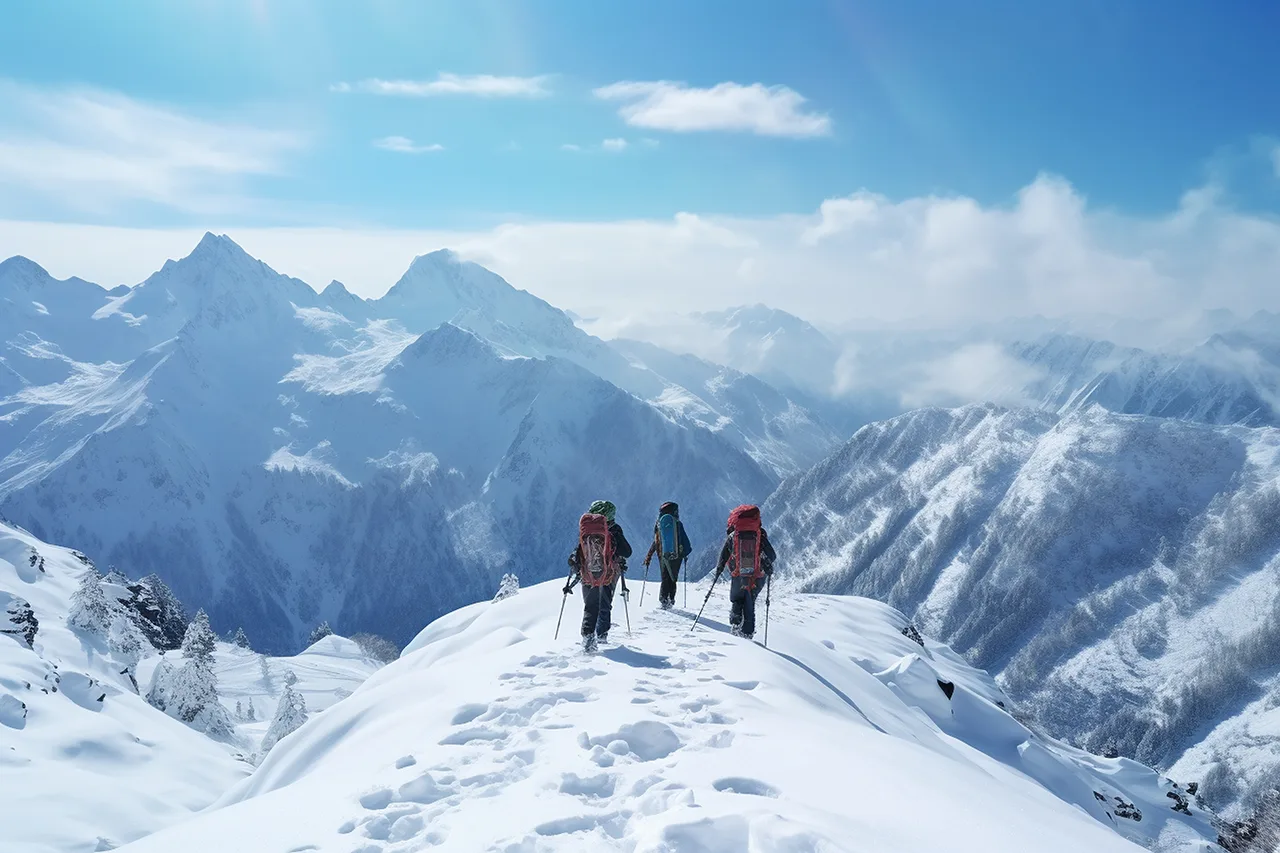
Chadar Trek Detailed Itinerary
Arrival in Leh (3500 m) Leh, situated over 3500 meters above sea level, ranks as the second-largest district in the country. During winter, when most passes leading to Leh are inaccessible, you’ll be flown to the Leh airport, the world’s highest airport. As you touch down, the dry, cold air welcomes you, but the breathtaking sight of snow-capped mountains steals the show. Complete arrival formalities, grab your luggage, and head to the pre-arranged hotel. Enjoy an overnight stay.
Acclimatization Walk in Leh Rise early for an acclimatization walk at high altitude. Head to Shanti Stupa, a sacred Buddhist stupa, offering a stunning sunrise view and a panoramic sight of Leh. Stay hydrated as you acclimate to the altitude on your first day in Leh.
Medical Check-up at SNM Hospital Due to the trek’s challenging nature, a medical certification is mandatory. Undergo a medical check-up at Sonam Narbu Hospital to obtain a clearance certificate, ensuring fitness and acclimatization for the trek.
Shingra Koma and Somo Paldar Enjoy breakfast and embark on a journey to Shingra Koma. The thrilling drive involves bumpy roads and hairpin bends, offering awe-inspiring views of the surrounding high mountains. Disembark and trek to the Somo Paldar campsite, marking the start of your Chadar trek.
Trek to Dib Cave/Tibb Embark on a trek to Dib Cave/Tibb, surrounded by breathtaking ravines and gorges. The steep cliffs limit sunlight, creating a unique atmosphere. Reach Dib, a large cave, where you’ll halt for the night. Experience butter tea and relish an overnight stay.
Dib Cave/Tibb to Camp at Naerak Trek through the scenic region, witnessing the largest frozen waterfall and prayer flags. Visit the village of Naerak, interacting with locals and immersing yourself in their way of life. Enjoy a comfortable overnight stay in the village camp.
Naerak to Tibb Embark on the return trip, trekking towards Tibb. Admire the changing beauty of the frozen river and interact with locals along the way. Relax at Dib Cave and stay overnight at the campsite.
Tibb to Shingra Koma & Back To Leh Depart Tibb for Shingra Koma, crossing Gyalpo. Witness high mountains and wildlife pugmarks, possibly spotting snow leopards and ibex. Return to Leh in the evening, staying overnight at the hotel.
Departure from Leh Your remarkable journey through this scenic destination concludes. Check-out from the guesthouse in the morning and depart from Leh airport, carrying the unforgettable experiences of this adventure.
What Mountains Teach Us About Life
In the embrace of the mountains, we discover not just the peaks and valleys of nature but also the heights within ourselves. Our journeys, whether planned or spontaneous, trek us through uncharted terrains and unpredictable weather, mirroring the challenges and triumphs of life itself.
Packing Essentials for Chadar Trek
- 2 pairs of synthetic track pants (wear one over the other for added warmth)
- 2 full-sleeve tees with collar
- Fleece jacket (avoid sweaters)
- Full-sleeve thick jacket
- 4 pairs of undergarments
- 2 pairs of thermal inners
- 2 pairs of sports socks and 2 pairs of woolen socks
- Woolen monkey cap/balaclava
- Woolen hand gloves + synthetic gloves (waterproof)
- Hot water bottle/bag (available at medical stores)
- Sunglasses with 100% UV protection
- Gumboot (if not purchased from Leh)
- Backpack (55 – 65 L) with sturdy straps and supporting frame
- Daypack (20 L) if offloading your backpack (inform in advance)
- Trekking shoes (good standard trekking shoes or gumboot recommended)
- Trekking pole (mandatory)
- Woolen head-scarf or muffler
- Light towel (thin, quick-drying)
- Chapstick or lip balm
- Cold cream and sunscreen lotion (SPF 40+)
- 2 water bottles (1 L each)
- Personal medicine kit
- Personal toilet kit and toilet paper
- LED torch with extra set of cells (headlamps preferred)
- Small repair kit (safety pins, needle, thread, and string)
- Camera, memory cards, batteries
- Plastic bags for compartmentalizing and carrying wet clothes
The Big NO:
- No denim or jeans
- No snacks, colas, alcohol, or personal food
- Keep the weight of your gear in the range of 8-10 kg
- Avoid carrying non-biodegradable materials
Mandatory Documents:
- Govt. Identity Card
- Medical Certificate
- Self Declaration
- Passport Size Photograph
Please click here to download the forms
Submit your inquiry using the form below
Cancellation policy.
In case, you are unable to travel or willing to cancel the trip, you can transfer the trip to any of your friends/known persons. Please note that this feature is applicable only when the status of the Booking is “Paid” and there are at least 5 days remaining before the departure date (departure date minus 5). Drop an email to [email protected]
Please note that the replacement would not be applicable to any Volvo/Train transport booked for the original participant. The same would be automatically canceled. This is simply because the seats booked in such transport mediums are not transferable.
The Refund of the amount will be processed as per deduction guidelines outlined below:
* If cancellations are made 30 days before the start date of the trip, 10% of the total tour cost will be charged as cancellation fees or get the full amount of the RoamingIndian trek voucher, which can be used later to book another trek.
* If cancellations are made 15-30 days before the start date of the trip, 40% of the total tour cost will be charged as cancellation fees.
* If cancellations are made within 0-15 days before the start date of the trip, 100% of the total tour cost will be charged as cancellation fees or get a RoamingIndian trek voucher of 50% of the amount.
Treks in Uttarakhand
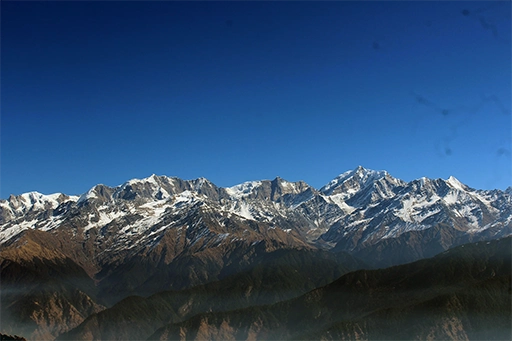
Dayara Bugyal Trek
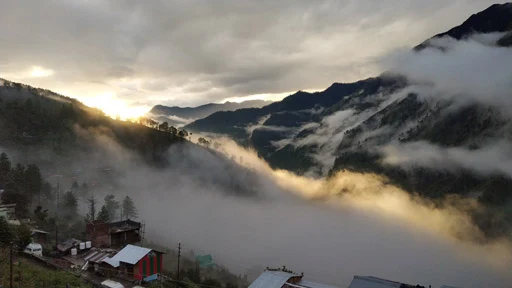
Har Ki Dun Trek
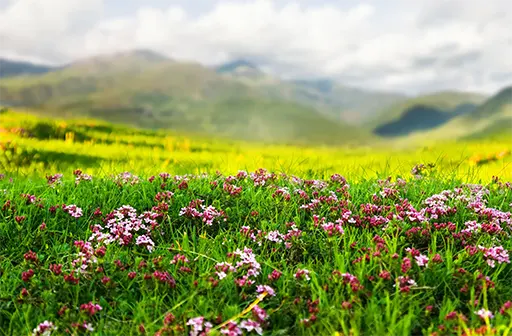
Valley of Flowers Trek
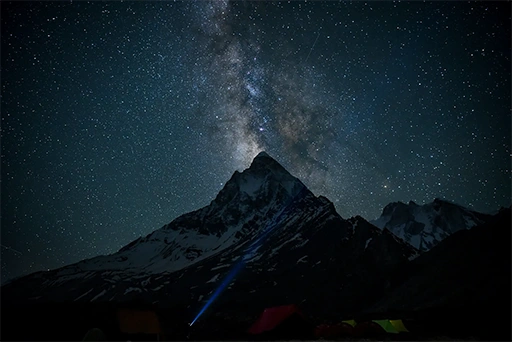
Gaumukh Tapovan Trek

- Trekking & Travel Events
- Travel Organizations
- Himalayan Treks
- Maharashtra Treks
- Karnataka Treks
- Travel Guides
- Weekend Getaways
- Trekking Tips & Advice
Chadar Trek: The Ultimate Guide for 2024!
- Trekking Destinations
Embark on a journey across the frozen Zanskar River, amidst snow-clad landscapes and majestic mountains. Welcome to Chadar Trek, the ‘Frozen River Trek’, a thrilling adventure deep within Ladakh’s icy wonderland. This blog post offers comprehensive information about this unique trek, from travel and accommodation to gear, guides, and permits. Read on to unravel the mysteries of the trek.
- Max Altitude: 11,123 Ft. (3,390M)
- Average Trekking Fees: ₹20,000 – ₹25,000
- Distance: 60 – 65 kms
- Difficulty: Difficult
- Duration: 7-8 days
- Ideal For: Experienced Trekkers Only
- Best Season: January - February
- Region: Ladakh
Table of Contents
Introduction to Chadar Trek

Imagine embarking on a journey that takes you across a frozen river blanketed by a sheet of ice, with majestic mountains and snow-covered landscapes as your backdrop. This is the essence of Chadar Trek , one of the most thrilling and unique experiences trekking in India offers.
Known as the ‘Frozen River Trek’, the trek unfolds in Ladakh’s icy wonderland. The Zanskar River, cloaked in a thick layer of ice during winter months, creates an enchanting pathway for trekkers. This extraordinary natural phenomenon, where the river transforms into a frozen highway, is what gives the trek its name – ‘Chadar’ means blanket in Hindi.
The appeal of the trek lies not only in its unique setting but also in its cultural significance. For centuries, this icy path has been used by locals as a trade route during winters when all other paths are blocked by heavy snow. Now, it’s a sought-after adventure for thrill-seekers worldwide, drawn by the combination of physical challenge and breathtaking scenery.
As for timing your trip, the best time to go on the trek is from January to February . It’s during these chilly months that the Zanskar River freezes solid enough to walk on. But brace yourself – temperatures can drop down to -30 degrees Celsius at night !
A word of caution before you pack your bags for this adventure: this trek is not for the faint-hearted! The freezing temperatures, high altitude and challenging terrain require trekkers to be physically fit and mentally prepared. It’s recommended that participants have prior trekking experience and are comfortable with walking 5-6 hours daily on uneven icy terrain.
Ready to conquer the icy expanse? Strap up those trekking boots! The frozen river awaits…
Preparing for Chadar Trek
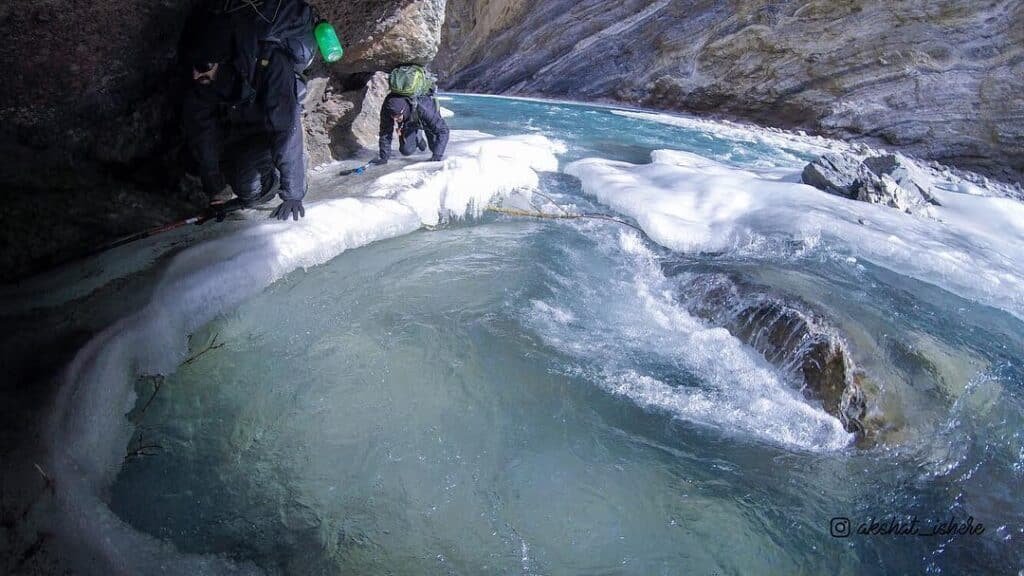
Adventure doesn’t knock on your door, you need to go knocking!
And when you’re knocking on the door of an adventure like the frozen river trek, preparation is key. So let’s dive in!
Physical Fitness Preparation
To conquer the icy path, you need a fair amount of physical fitness. High-altitude trekking is not a walk in the park! You’ll be treading on a frozen river, battling low temperatures and thin air. Regular cardiovascular exercises can be your best ally here. Engaging in activities such as running, cycling or swimming for at least 30 minutes every day, about two months prior to the trek can significantly boost your stamina.
Essential Gear and Equipment
As the saying goes, “There’s no such thing as bad weather, only unsuitable clothing”. For the trek, gear up with winter essentials such as:
- Trekking Shoes: Opt for high ankle waterproof shoes with good grip.
- Insulated Water Bottle: Hydration is crucial at high altitudes.
- Headlamp: Power cuts are frequent in Leh.
Remember to pack light yet smart!
Recommended Clothing
In the brutally cold terrain of Zanskar River valley, your clothing is your lifeline. Layering is the secret sauce to withstand the extreme temperatures.
- Base Layer: Thermal innerwear that traps body heat.
- Middle Layer: Fleece jacket for insulation.
- Outer Layer: Waterproof and windproof jacket.
Don’t forget thermal socks, woollen cap, gloves and sunglasses!
Acclimatization and Altitude Sickness
High altitude equals low oxygen levels. Your body needs time to adjust to this new environment – a process called acclimatization.
Importance of Acclimatization
Acclimatization minimizes the risk of altitude sickness which can turn fatal if ignored. Spending two days in Leh before starting the trek can help your body acclimatize.
Symptoms and Prevention of Altitude Sickness
Watch out for symptoms like headache, nausea or breathlessness. If you notice any of these signs:
- Descend immediately
- Keep yourself hydrated
- Avoid tobacco and alcohol
Tips for Acclimatizing Properly
- Increase altitude gradually
- Maintain a healthy diet
- Stay hydrated
Remember, slow and steady wins the race! Take it easy on the first few days of trekking.
Embarking on this difficult trek demands grit, determination and above all – thorough preparation. With these tips in your toolkit, you’ll be ready to brave the Icy Wonderland! The majestic Zanskar awaits you – tread its frozen path and etch an unforgettable memory into your adventurous hearts!
Getting to the Chadar Trek Base
The journey to the trek begins with an exhilarating travel to Leh, a high-desert city in the Himalayas. Nestled at an altitude of 3500 meters, Leh isn’t just any pitstop. It’s the gateway to your ultimate adventure!
Flights are the most convenient way to reach Leh, with regular services from Delhi. The aerial view of snow-capped mountains is a sight that sets the mood for your trekking expedition. Alternatively, if you’re up for a road trip, there are buses from Manali and Srinagar, but remember these routes are accessible only during summer and not during winter, so the only way to access Leh is via flights during the winter season .
Once you touch down in Leh, don’t rush off to the base camp yet! Your body needs time to adjust to the high altitude. Spend a couple of days exploring Leh’s charming monasteries and bustling markets. This period of acclimatization is crucial for a successful trek ahead.
With lungs full of mountain air and hearts pounding with excitement, it’s time to set off towards the trek base camp located at Chilling. There are shared taxis available from Leh which will take you on a scenic drive along the Indus River till you reach Chilling.
From Chilling, it’s a small hike to Tilad Do, your first encounter with the frozen Zanskar River and your actual starting point of this icy adventure. Be prepared as this is where reality hits – The Chadar Trek is not just another walk in the park!
While the journey to reach Chadar can seem daunting, Nomads of India are here to guide you every step of the way.
As we always say – The journey matters as much as the destination!
Budget & Costing
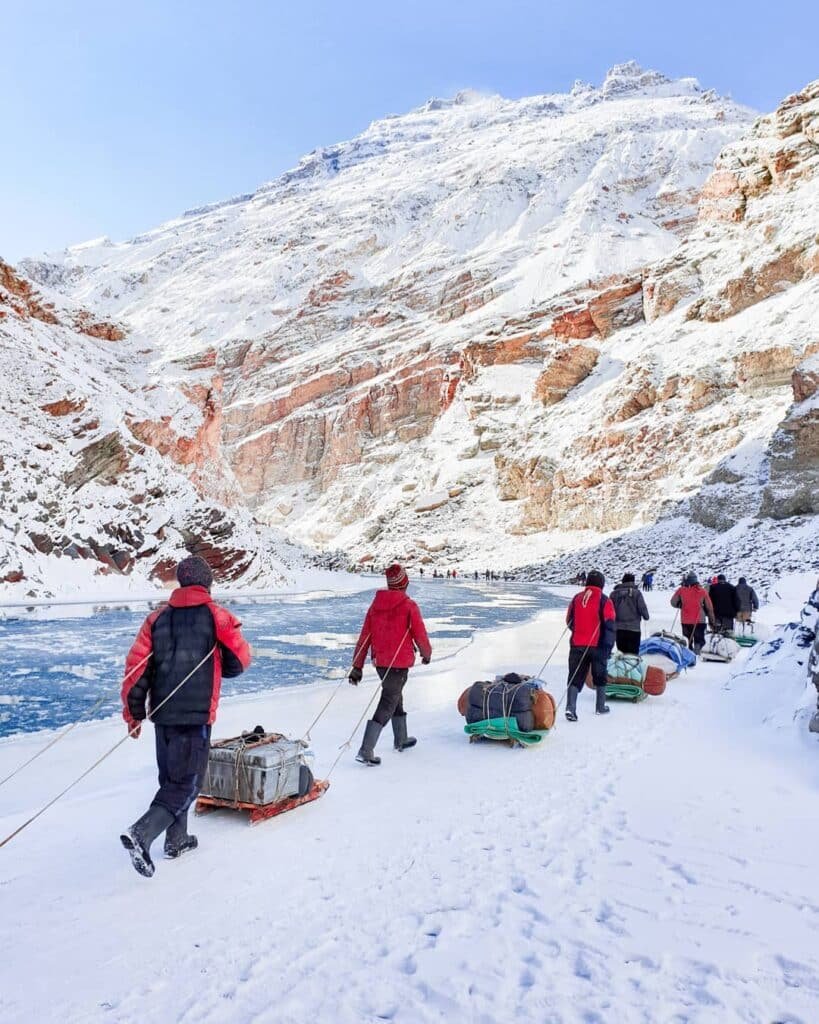
Before embarking on this adveture, it’s essential to plan your budget carefully. The total cost would depend on various factors such as mode of travel, accommodation type, gear and equipment, guides, permits, and other miscellaneous expenses.
Here are some estimated costs for your reference:
- Flights: A round trip flight from Delhi to Leh can range anywhere between ₹10,000 – ₹20,000 depending on when you book.
- Accommodation: Budget hotels in Leh can cost around ₹ 1,000 – 2,000 per night while a more luxurious stay can go up to ₹ 5,000 per night.
- Trekking Gear: Buying new trekking gear can hit your wallet hard. Consider renting equipment like trekking shoes, insulated water bottles and headlamps which can cost around ₹ 1,000 – 2,000 .
- Trek Package: A comprehensive package from a reputed trekking company usually costs between ₹ 20,000 – 25,000 . This generally includes accommodation, meals during the trek, first aid kit, guide charges and permit fees. The group size is usually around 20-25 people
Remember that these are estimated costs and actual expenses may vary. It’s always sensible to carry some extra cash for any unforeseen expenses. Happy budgeting!
But hey, don’t just take our word for it! Pack those bags, lace up those boots and let’s get ready for an unforgettable trip of a lifetime! We’ll continue our trekking story in our next section: Itinerary .
Next Stop: A day-by-day guide through this epic journey…
Chadar Trek Itinerary: Your Daily Dose of Adventure
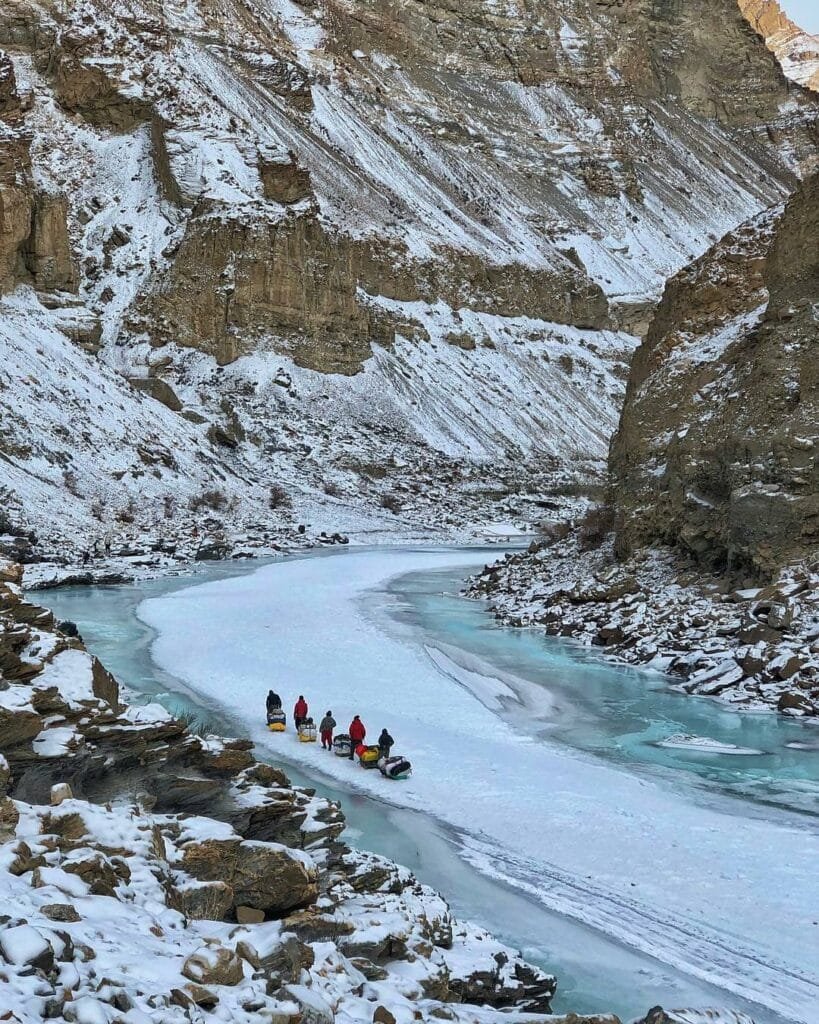
Day 1: Your Arrival in Leh (3,500 M)
Your journey begins in Leh, the gateway to Ladakh with towering peaks. During the winter, the only viable route to Ladakh is by air, and flights from Delhi to Leh provide captivating aerial views of the Himalayas. Make sure to secure a window seat for breathtaking vistas.
Dedicate the first day to acclimatizing to the high altitude. As you transition from sea level, your body will need time to adjust to the mountain environment. While the Leh winters are harsh, this marks just the start of your cold weather experience.
2nd Day: Rest & Acclimatization in Leh (3,500M)
This day focused on helping you adapt to the altitude and climate. Take the opportunity to explore the city market, immerse yourself in the local culture, and visit nearby sites. Gradual movement aids in acclimatization. Also, utilize this time to review your checklist and make any last-minute purchases for the trek. Leh offers an excellent market for trek essentials.
Day 3: Further Acclimatization in Leh (3,500M)
On day three, the process of acclimatization continues. A necessary medical examination at the Tourist Information Centre is planned, playing a vital role in acquiring the required permits from ALTOA and the Wildlife Department for commencing the trek.
4th Day: Trek from Leh (3,500M) to Shingra Koma via Bakula (3,215M)
Distance: 70 km | Duration: 2-3 hours
Today marks the start of your trek as you drive to Bakula, the trek’s starting point. Beginning early, you’ll follow the scenic route along the Indus River, passing the confluence of the Indus and Zanskar Rivers at Nimmu. This picturesque 70 km journey, lasting about 3 hours, treats you to breathtaking views as you navigate narrow hairpin bends. As you approach Bakula, the frozen expanse of Zanskar unfolds before you. Upon transitioning to the Chadar, your trek leaders will guide you in traversing the icy terrain. Embrace the learning curve of walking on this glassy ice using the Penguin Walk technique, and you’ll quickly become adept.
One notable feature of the trek is the consistent, level terrain. There are no steep ascents or descents, and minimal altitude gain reduces the risk of altitude-related issues. Mastering today’s walk signifies adequate acclimatization, boding well for the trek ahead.
The appearance of the Chadar varies with weather conditions. It might be glassy, covered in powdery snow for better traction, or thinly iced in certain sections, requiring navigation through slush or along the riverbank. Safety lies in following the sledge route used by porters.
Depending on your pace, you should reach the next campsite in 3-4 hours. This marks your first night of Chadar camping.
Day 5: Trek from Shingra Koma to Tibb (3,280M)
Distance: 14 km | Duration: 6-7 hours
Waking up to the freezing cold entails leaving the warmth of your sleeping bag and tent. Yet, the hospitable people of Zanskar ensure a comforting start with hot tea and meals. Today’s 14 km journey to the next campsite spans 6-7 hours due to the challenges of Chadar walking. Remember to refill your thermos with warm water, as standard bottles succumb to the cold. Sunlight is a rarity in this gorge, appearing briefly due to the surrounding towering mountains. As you traverse the vast valley, relish the crisp air and the deep blue hue of the Zanskar river, mirroring the sky on clear days. Frozen waterfalls adorn the route. Pause by the river to cook meals and ensure energy levels remain ample. The final stretch to Tibb, about 200 meters, is captivating. Arrival at the campsite is anticipated by late afternoon.
Day 6: Trek from Tibb (3,280M) to Nerak (3,400M)
Distance: 12 km | Duration: 5-6 hours
Day six presents an encounter with the highlight of the trek, Nerak Waterfall. A substantial journey lies ahead, necessitating an early start to reach the waterfall by late afternoon. Amid the Zanskar Valley’s early sun departure, staying active is vital to staying warm. Noteworthy are the broken ice formations in the frozen river, forming captivating geometric patterns. Midway, a unique lunch awaits within a spacious cave. After arriving at the campsite, you’ll visit the awe-inspiring Nerak waterfall, a 30-minute walk away. Keep an eye out for domestic Yaks and relish the sight of the traditional wooden bridge juxtaposed with a modern counterpart. Time spent at Nerak waterfall is followed by dinner back at the campsite.
7th Day: Trek from Nerak (3,400M) to Tibb (3,280M)
Distance: 12 km | Duration: 6-7 hours
Following the exhilarating Nerak waterfall experience, you’ll trace your steps back to the Tibb campsite. The return journey, while familiar, offers a fresh perspective. The ever-changing frozen Zanskar River reacts to temperature fluctuations, transforming its appearance. Listen closely to the evolving sounds underfoot, a captivating aspect of Chadar trekking. Alongside the trail, local porters in traditional attire, called ‘Gonchas,’ demonstrate remarkable ease traversing the icy terrain. Their cheerful greeting of ‘Julley’ resonates – a Ladakhi welcome. Encounters with local songs and their adept sledging add cultural flair. As you penguin-walk to Tibb, the locals effortlessly overtake you.
Day 8: Trek from Tibb (3,280M) to Bakula (3,215M) and Return to Leh (3,500M)
Distance: 12-13 km | Duration: 7-8 hours
The final leg takes you full circle to Bakula, a 7-8 hour trek. From there, a 3-hour drive returns you to Leh, where you’ll spend the night in a hotel.
Day 9: Departure from Leh
The trek concludes. Given the unpredictable high-altitude weather and conditions, allocate buffer days between the trek’s end and your departure to accommodate travel arrangements.
“Every day on Chadar Trek is different, bringing new challenges and experiences!”
Camping & Accommodation
On the trek, your home under the stars changes every day! Camping sites are allocated by authorities based on safety considerations. You’ll be provided with high-quality tents that can withstand harsh weather conditions.
Activities & Attractions
Chadar Trek isn’t just about challenging yourself physically; it’s also about immersing yourself in nature’s beauty. From watching a sunrise over frozen Zanskar, visiting ancient monasteries in Leh, and walking through fascinating ice-formation landscapes, each day promises new sights that will leave you spellbound!
“Chadar Trek isn’t just a journey; it’s an experience that stays with you forever.”
Up Next? A Peek Into The Highlights Of Chadar Trek
But wait! There’s still so much more we haven’t touched upon —like those hypnotic frozen waterfalls or our encounters with local culture! So let’s continue our snowy saga and explore some highlights from this once-in-a-lifetime adventure!
Highlights of Chadar Trek
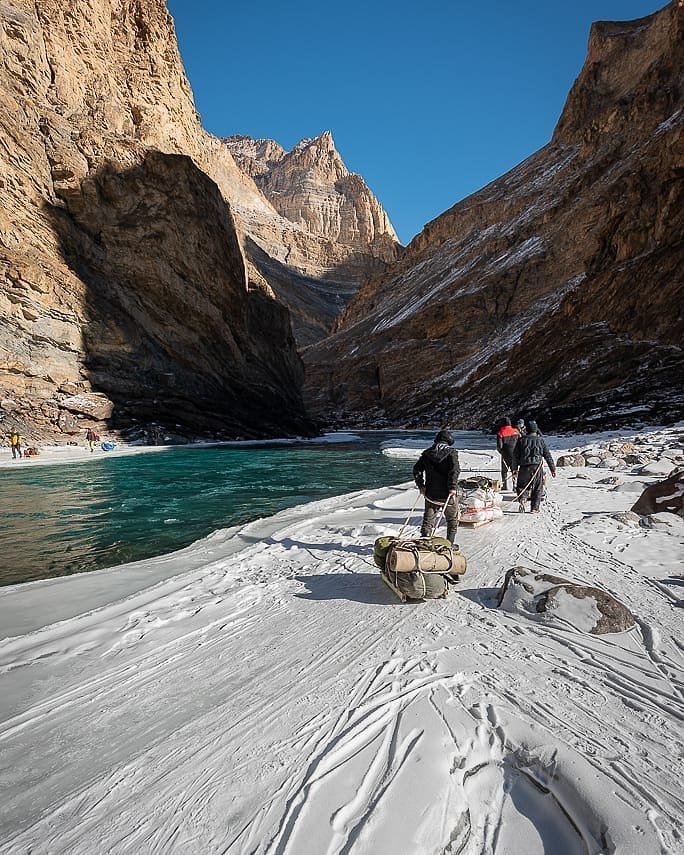
Embark on a journey where each step unveils a new wonder, each turn presents a vista more stunning than the last. Be it the awe-inspiring frozen waterfalls or the tranquil Zanskar River , this trek is replete with unique experiences and unforgettable sights.
Dance with Frozen Waterfalls
Imagine a waterfall, frozen in time, creating a spectacle so surreal that it leaves you breathless. The trek introduces you to such magnificent frozen waterfalls, an ethereal artwork of nature that defies description. It’s akin to walking through a dream, where cascading waters have been paused mid-fall, held captive by the cold winter air.
Surrender to Zanskar’s Charm
Next on the list is the hypnotic allure of the Zanskar River. Dressed in its winter attire, a glossy sheet of ice, it’s truly mesmerizing. The river becomes your constant companion along the trek, its gentle whispers echoing through the silent valleys. As you walk over its icy surface, you’ll be treated to views so enchanting they seem straight out of a fairy tale.
Lose Yourself in Nature’s Artistry
The landscapes here are nothing less than divine poetry etched in snow and ice. Each day breaks to unveil scenic views that can move even the most hardened hearts. The pristine white snow fields contrasted against clear blue skies will leave an indelible impression on your soul.
Immerse in Local Culture
Finally, don’t miss out on embracing the rich local culture of Ladakh. This trek isn’t just about physical endurance; it is also about understanding and appreciating the resilience of locals who thrive in these harsh conditions. Interact with them; their warmth and hospitality will add another layer to this already fulfilling experience.
The Chadar Trek experience ? It’s more than just an adventure. It’s a transformation, a shift in perspective that only the daring ones get to witness. The frozen Zanskar river beneath your feet, the milky way above your head at night, and the adrenaline rush piercing through your veins – it’s an unforgettable journey etched in ice and memories.
Recall those moments of struggle, pushing through physical boundaries, braving extreme conditions. Remember how you emerged stronger, filled with a sense of achievement? That’s personal growth! You didn’t just conquer a trek; you conquered yourself.
“It’s not the mountain we conquer but ourselves.” – Edmund Hillary
And now? Now it’s time to pass on the torch. Encourage others to step out of their comfort zone and embrace this icy adventure. Share your experiences, tell them about the breathtaking views, the thrill of walking on a frozen river, and the silence of the mountains.
Because at the end of the day, it’s not just about reaching the summit or completing a trek. It’s about experiencing something extraordinary, something that makes your heart race and eyes sparkle with wonder.
So go on, and inspire someone today to embark on their own trek adventure. For there is no joy greater than inspiring another soul to explore the beauty of this world.
Don’t forget – every mountain top is within reach if you just keep climbing.
The Chadar trek has not been banned. However, it’s important to note that the status of trekking routes and regulations can change over time. Before planning your trip, it’s advisable to check with local authorities and tour operators for the most up-to-date information on trekking permissions and bans.
The cost of the Chadar trek can vary depending on several factors, including the tour operator you choose, the duration of the trek, the inclusions (such as accommodation, meals, transportation), and any additional activities. On average, the cost could range from approximately ₹20,000 to ₹35,000 or more per person. It’s recommended to compare different tour packages and choose one that aligns with your budget and preferences.
Yes, the Chadar trek is considered to be a challenging and potentially risky adventure due to its extreme weather conditions and the frozen Zanskar River. The temperatures can drop significantly, and the frozen river conditions can change rapidly, leading to cracks or holes in the ice. Trekkers need to be prepared for sub-zero temperatures, altitude-related concerns, and the unpredictable nature of the ice. Proper planning, experienced guides, and appropriate gear are crucial to mitigate the risks associated with this trek.
The Chadar trek is known for its difficulty and harsh conditions, making it less suitable for beginners. It demands a certain level of physical fitness, mental resilience, and prior trekking experience. It’s advisable for individuals attempting the Chadar trek to have some experience in high-altitude treks, cold-weather conditions, and challenging terrains. If you are a beginner, it’s recommended to gain trekking experience on less demanding trails before considering the Chadar trek. Always consult with trekking experts and guides to assess your readiness for such a demanding adventure.
- trekking guides
- No comments yet.
Add a comment
Leave a reply · cancel reply.
Your email address will not be published. Required fields are marked *
This site uses Akismet to reduce spam. Learn how your comment data is processed .
- Share via...

- Best Hikes In The World
- Appalachian Trail
- European Hikes
- Nepal Hikes
- Patagonia Hikes
- See All Hikes
- Mount Kenya
- Mount Kilimanjaro
- Mount Toubkal
- See All Mountains
- South Africa
- New Zealand
- Switzerland
- United Kingdom
- Packing Lists
Chadar Trek – One Of The Most Wild And Beautiful Hikes On The Planet
Asia , India
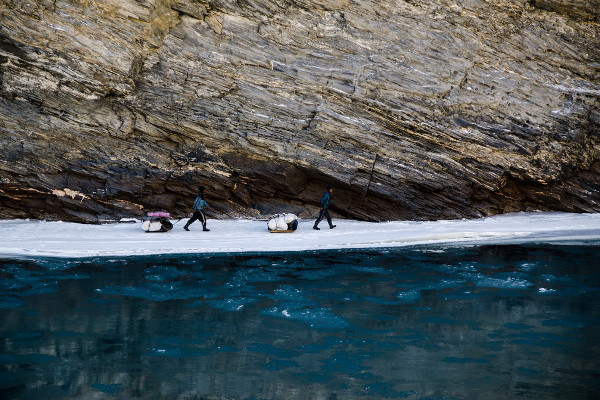
The Chadar Trek, or Zanskar Gorge, is widely known as one of the most difficult treks in the world . If you're an avid trekker, then chances are this wild and challenging trek is on your bucket list.
Chadar Trek Overview
The Chadar Trek is one of the most wild and beautiful hikes on the planet . Frequently covered by the world's top adventure channels and media outlets, the Chadar Trek takes hikers through a frozen river valley into the very heartland of India’s Ladakh region.
The region’s harsh desert environment and towering mountains make the Chadar trek one of the most popular treks in the Ladakh area . Very few treks are as remote as the Chadar and even fewer are conducted in high winter. The trek is not for the lighthearted as temperatures are often lower than -10 degrees celsius in the day and -20 at night.
Cut off entirely from the outside world, the Zanskar river is the only outlet for locals wishing to venture further into the Ladakh region. The trail has been used for nearly a thousand years by the Buddhist monks living in the region. You’ll trek the same route, walking over the frozen river as you cut a path towards Naerak. You will need to have a good level of stamina and fitness to have a really good time.
Accommodation is riverside camping.
Please Note: The Chadar trek is ideally suited to seasoned trekkers looking to experience one of the most remote places on earth.
Regional Map
The Chadar Trek is located in the Zanskar region of Ladakh which is part of the Indian state of Jammu and Kashmir .
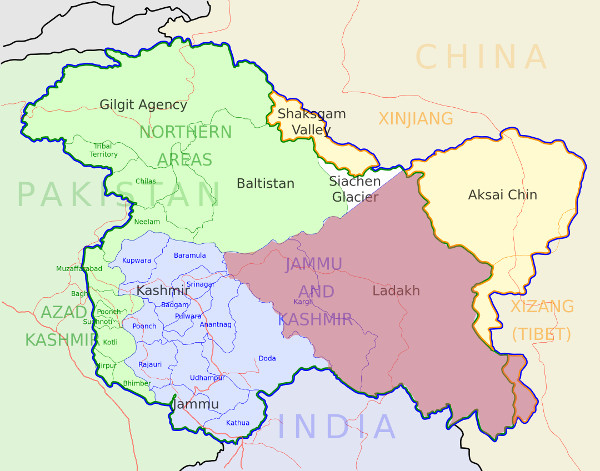
Chadar Hike Itinerary
Below is a detailed Chadar Trek itinerary. Please note that this is a typical itinerary that we would expect many operators to adhere to. However, some tour operators offer variations on this route.
Day 1-2: Arrival in Leh (3500 m)
After taking a flight from Delhi, you will arrive in Leh – the highest airport on earth! Take in the cool mountain air as you explore town before bedding down in your hotel for the night.
Day 3: Drive to Chilling – Hike to Tilad Do (3100 m)
After breakfast, your operator will take you by car to your starting point at Chilling roughly 3 hours away. Along the way, you will no doubt visit the important Buddhist temple of Shanti Stupa. Once in Chilling you will drive a little further to Tildad Do where your hike begins. The drive is fairly high and windy and you’ll need to hold your nerve as the road becomes tighter and more narrow.
You will then trek for several kilometres to reach your first coming ground. Along the path, you will walk for the first time on the river ice and get to grips with the cold weather of the region. Set up your tent quickly before the cold night sets in!
Day 4: Tilad Do to Shingra Koma (3170 m)
Today, you will be walking for almost 12 km as you venture along the valley floor towards your campsite at Shingra Koma. Make sure to follow the lead guide as you will be walking on river ice that can often crack.
As you walk, make sure to take in the incredible rock faces and surrounding snow-capped peaks as you walk in the footsteps of generations before you. The landscape is truly spectacular during winter and very few people get to witness such remote valleys.
Day 5: Shingra Koma to Tib Cave/Tibb (3225 m)
Today, you continue your journey along the river valley taking in the incredible gorges and frozen inlets as you venture towards Tib Cave.
The cave is a huge opening in the rock face in which you will camp for the night to shelter from the snow. Make sure to drink plenty of butter tea to keep your body warm and strong.
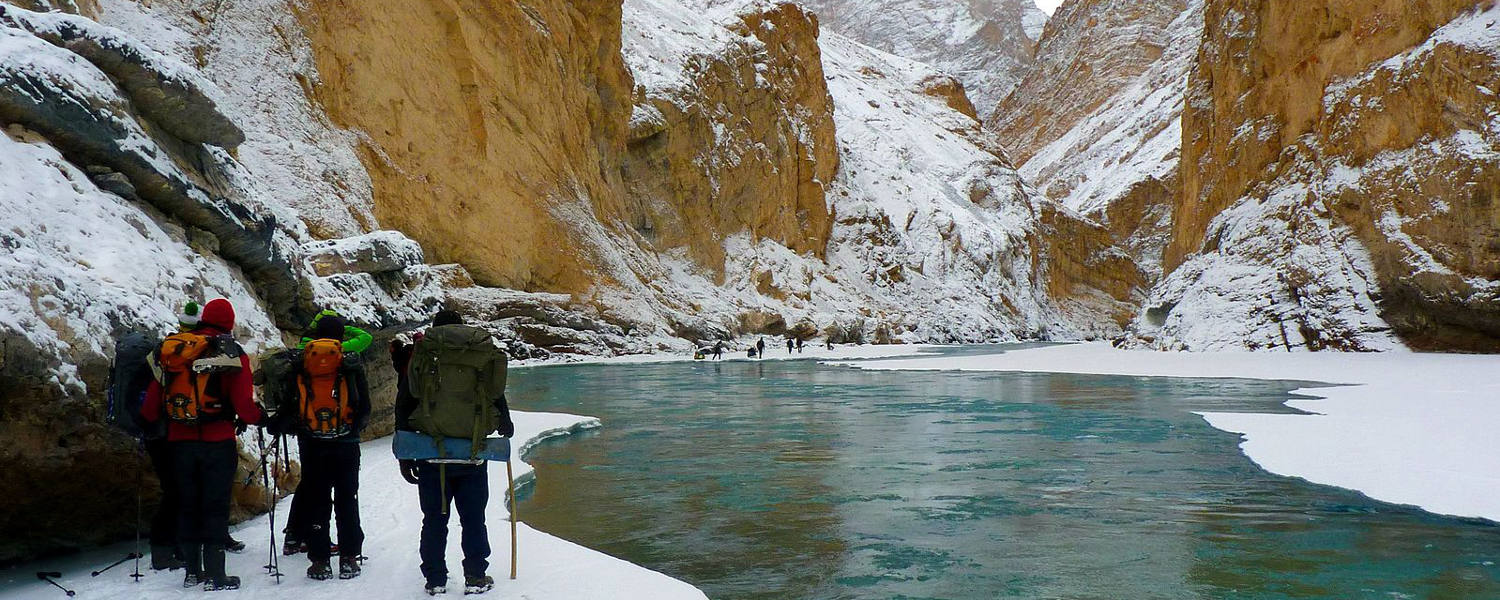
Day 6: Dib Cave/Tibb to Camp at Naerak (3390 m)
Today, you’ll be walking for roughly 10km as you trek the most beautiful section of the valley. Along the route you’ll be dazzled by one of the world's largest frozen waterfalls and large prayer flags fluttering in the cool breeze.
In the late afternoon, you’ll reach the village of Naerak where you have the chance to explore and talk to the locals – maybe share a drink or two!
Day 7: Naerak to Tibb
Today, your return journey begins as you proceed back to Tibb. However, your path may very well be different as the river reacts to the slightest temperature changes. Sections that were frozen may now be running and vice versa. Always follow the steps of your guide.
Day 8: Tibb to Shingra Koma
As you return down the river valley, you’ll have plenty of time to react on the stunning landscape and take pictures to show your relatives and friends back home. Keep a sharp eye out for wildlife including foxes, ibex and the elusive snow leopard. Although rarely spotted, you can be assured the leopards are watching.
Day 9: Shingra Koma to Chilling – Chilling to Leh
This is your last day on the Zanskar River. You’ll trek back to Tilad Do where you will say a final goodbye to the locals before taking a car back to Leh. Relax in a warm and cozy bed for the night to rest your tired muscles.
Day 10: Departure
Today, you say farewell to your crew and depart Leh for Delhi. Here, you will take your international flight home.
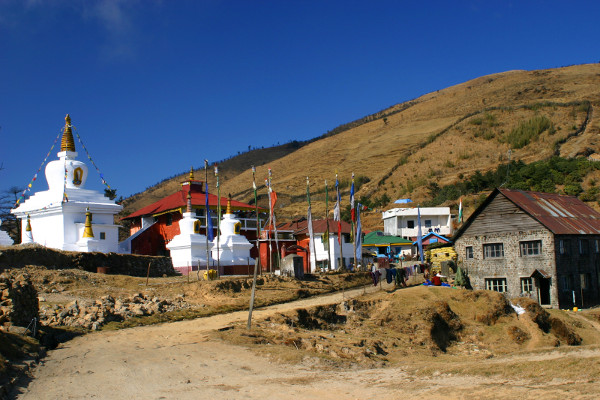
Chadar Trek FAQ
How much does the chadar trek cost.
The cost of the Chadar Trek varies depending on what operator you use. Local agencies often offer a guided trek for as little as US$250 per person (excluding flights). However, for an established western operator, you should look to pay at least double this. The trek can be dangerous and finding the right operator is important as your safety should be paramount.
You will also need to factor in flights, equipment, visas, vaccinations and food and drink. Each operator will offer a slightly varying package when it comes to food and drink on your trek.
- Visa, Vaccinations, Insurance etc: ~$300-$500
- Equipment (buying and hiring): ~$300-$800
- Flights to Leh: ~$1,000
- Tour Agency: ~$250 – 350 for a cheap local agency to ~$500 – 1000 for a Western trekking agency
- Tips: ~$50-$100
- Misc (additional food, unplanned travel / hotels ect): $200
- Total Costs: $2,200 – $4000
Are permits required for the Chadar Trek?
Permits are generally included with your trek costs. However, operators will often ask you to pay around US$50 for a wildlife/environment charge levied by the Indian government.
When is the best time to complete the Chadar Trek?
The best time to trek the Chadar Trek is January and February during the peak winter season . This is when the river is frozen and can be walked on (gently).
The Chadar Trek does not operate at any other point in the year.
Is altitude sickness a risk on the Chadar Trek?
Yes, the entire area is at high-altitude, and you’ll want to make sure you arrive several days before your trek to acclimatise to the thin air.
It is important to have a detailed understanding of the risks associated with high altitude trekking and how the body acclimatises.
We recommend you read our detailed article on Altitude Sickness and Acclimatisation .
How difficult is the Chadar Trek?
The Chadar Trek is considered to be one of the toughest treks in the Ladakh Region. The trail is cold, icy, often steep and always at high altitude.
Only experienced trekkers are recommended for this trek. You will need to be in good physical condition before attempting the route and have a good stamina built up.
The freezing temperatures also make the trek difficult with temperatures often exceeding -20 degrees at night and -10 degrees during the day.
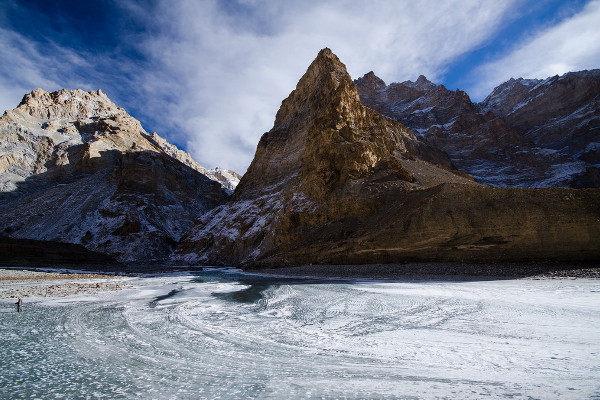
What gear do I need for the Chadar Trek?
Trekking in the Ladakh region requires a number of essential pieces of trekking clothing and equipment. The Chadar trek however requires some cold weather gear that is often not nesscary on the summer treks.
Many pieces of equipment can be rented or bought in Leh, but we recommend bringing the most important pieces of gear with you. The important thing is warmth. You’ll need a winter sleeping bag (may be provided) and good quality thermal gear.
To help you plan and prepare for your trek, we have written a detailed hiking gear list for multi-day treks .
What travel insurance do I need for the Chadar Trek?
Trekking insurance is a must on multi day hikes. This is particularly important on the Chadar Trek which is extremely remote. If an accident should occur that requires medical assistance and evacuation you will definitely want trekking insurance that can cover the costs of air ambulance and treatment.
Moreover, it is prudent to have insurance that covers you for any travel related risks, like lost, stolen, damaged or delayed baggage; flight delays and interruptions; and tour operators default.
Moreover, it is prudent to have insurance that covers you for any travel related risks, like lost, stolen, damaged or delayed baggage; flight delays and interruptions; and tour operators' default.
Are there any recommended guidebooks for the Chadar Trek?
There are a number of excellent guides we recommend for the Chadar Trek. These are:
- Trekking in Ladakh by Radek Kucharski.
- Trekking in the Indian Himalaya by Lonely Planet
- Trekking Guide to the Western Himalayas by Depi Chaudhry
- Ladakh: the Essential Guide: Including Kashmir & Manali by Partha S. Banerjee
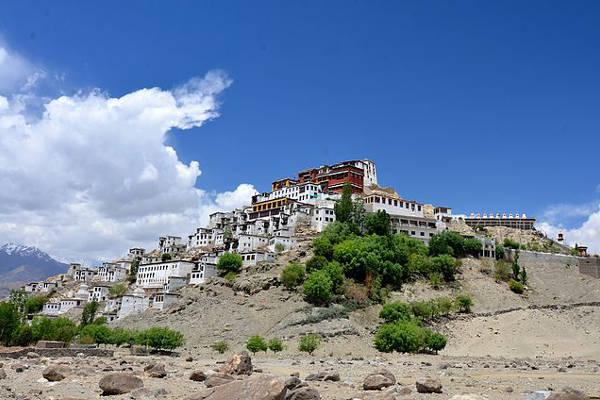
Are there other Indian Hikes besides the Chadar Trek?
Absolutely. We also recommend doing hikes like the Singalila Ridge , Markha Valley and Ladakh for unparallelled sightseeing and experiencing Indian culture and history firsthand.
Continue browsing
See more information on India . Or check out these other Indian Hiking articles:
- Hiking the Himachal Pradesh
- Trekking the Uttarakhand
- Roopkund Hike India
- Arunachal Pradesh India Treks
- Guide to India hikes
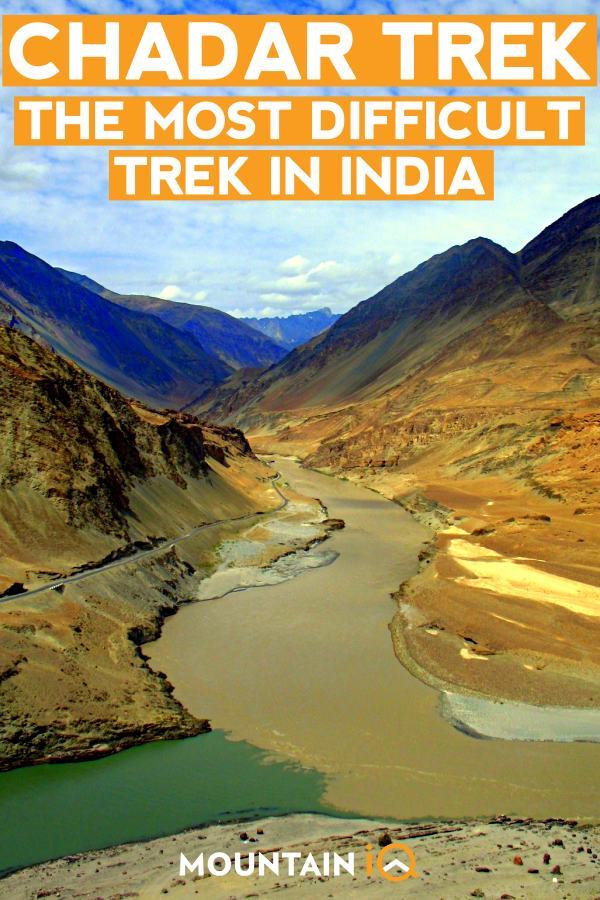
About the author
Mark Whitman
Mark has trekked extensively in Asia, Europe, South America and Africa. He founded Mountain IQ in 2014 with the sole aim to be the best online information portal to some of the most popular mountain destinations around the world. When not writing for Mountain IQ, Mark is out exploring the outdoors with his wife!
Leave a Reply
Your email address will not be published. Required fields are marked
We work with local guides to offer great value adventures at unbeatable prices
Chadar Trek
🗓 Best Time To Visit: January to February
⏰ Open Hours: N/A
🏞 Things To Do: Trekking, Photography, Camping, Nature Walks
💰 Budget: INR 15,000 - 25,000 per person
🧳 Traveller Types: Adventure Seekers, Nature Lovers, Photographers
🔍 Known For: Unique frozen river trek, Beautiful landscapes, Leh Palace, Zanskar River
📍 Distances: Leh Airport - 9 km, Srinagar Railway Station - 421 km, Leh Town - 5 km
🥾 Trek Difficulty: Moderate to Difficult
🧣 Essential Gears: Thermal Clothes, Trekking Shoes, Trekking Pole, Sunglasses, Sunscreen, Medicines
📜 Permit: Mandatory Ladakh Autonomous Hill Development Council (LAHDC) permit
🔺 Altitude: 3,850 meters
Have you ever dreamed of walking on a frozen river, surrounded by snow-capped mountains and stunning scenery? If yes, then you should definitely try the chadar trek, one of the most unique and adventurous treks in the world. The chadar trek is a winter trek that takes you along the frozen Zanskar river in Ladakh, a region in the northern part of India. The chadar trek is not for the faint-hearted, as it involves braving the extreme cold, the slippery ice, the unpredictable weather, and the remote wilderness. But if you are up for the challenge, the chadar trek will reward you with an unforgettable experience, a sense of achievement, and a glimpse into the culture and lifestyle of the local people who have been using this route for centuries.
In this article, we will tell you everything you need to know about the chadar trek, from what it is, why you should do it, how to reach it, when to go, what to expect, what to prepare, and how to book it.
What is Chadar Trek?
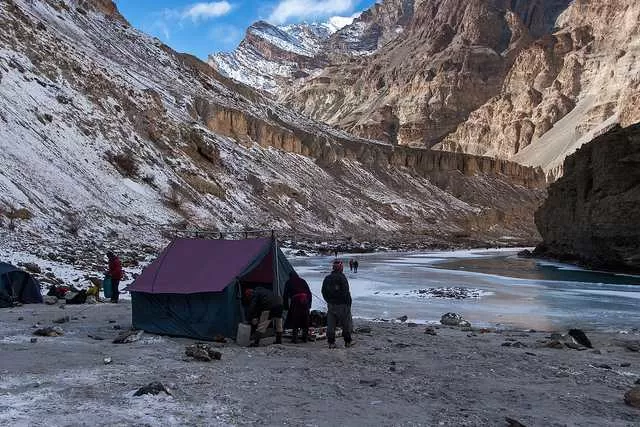
The word chadar means blanket in Hindi, and it refers to the thick layer of ice that covers the Zanskar river during the winter months. The Zanskar river is a tributary of the Indus river, and it flows through a deep and narrow gorge in the Zanskar valley, which is part of the Greater Himalayas. The chadar trek is a trek that follows the frozen river for about 105 km, from Chilling to Naerak and back. The chadar trek is also known as the frozen river trek or the Zanskar trek. The chadar trek is one of the oldest and most traditional routes in Ladakh, as it was used by the local people, especially the Zanskari people, to trade and communicate with the outside world when the road access was blocked by snow.
Why Chadar Trek?
The chadar trek is not just a trek, it is an adventure, a challenge, and a learning experience. Here are some of the reasons why you should do the chadar trek:
1. The chadar trek is a unique and rare trek, as it is one of the few places in the world where you can walk on a frozen river. The chadar trek is also a seasonal and unpredictable trek , as it depends on the weather and the river conditions, which can change anytime. The chadar trek is also a dynamic and diverse trek, as it offers different landscapes, terrains, and views, depending on the time of the day, the angle of the sun, and the thickness of the ice.
2. The chadar trek is a thrilling and exciting trek, as it involves walking, sliding, crawling , and sometimes even swimming on the frozen river. The chadar trek is also a challenging and demanding trek, as it requires a high level of fitness, stamina, endurance, and mental strength. The chadar trek is also a risky and adventurous trek, as it exposes you to the extreme cold, the slippery ice, the unpredictable weather, and the remote wilderness.
3. The chadar trek is a cultural and educational trek, as it introduces you to the culture and lifestyle of the local people , especially the Zanskari people, who have been living in this harsh and isolated environment for centuries. The chadar trek is also a spiritual and inspirational trek, as it passes by many ancient and sacred sites, such as monasteries, shrines, and caves, that are revered by the Buddhists. The chadar trek is also a social and fun trek, as it allows you to meet and interact with other trekkers, guides, porters, and locals, who share your passion and enthusiasm for the chadar trek.
Best Time to Go for Chadar Trek
The best time to go for the chadar trek is from mid-January to mid-February , when the Zanskar river is frozen enough to support the weight of the trekkers. The chadar trek is not possible before or after this period, as the river is either too thin or too thick to walk on. The chadar trek is also not possible during the summer months, when the river is flowing and not frozen.
The best time to go for the chadar trek also depends on the weather, the river condition, the availability, and the preference of the trekkers. The weather in Ladakh during the winter months is very cold, dry, and windy, with temperatures ranging from -5°C to -25°C.
How to Reach Chadar Trek
The chadar trek starts and ends at Chilling , a small village in the Zanskar valley, which is about 65 km from Leh, the capital of Ladakh. To reach the chadar trek, you need to first reach Leh, and then take a taxi or a bus to Chilling. To reach Leh, you have two options: by air or by road.
By air , you can take a flight from Delhi, Mumbai, Bangalore, or other major cities in India, to Leh, which is the nearest airport to the chadar trek.
By road , you can take a bus or a car from Manali, Srinagar, or other nearby towns in Himachal Pradesh or Jammu and Kashmir, to Leh, which is the nearest road head to the chadar trek. The road distance is about 475 km from Manali, and about 420 km from Srinagar, and the road duration is about two days, with a night halt at Keylong or Kargil, respectively.
The best way to reach the chadar trek is by air, as it is faster, easier, and more reliable than by road. However, you need to be prepared for any changes or cancellations, and acclimatize yourself to the high altitude and low oxygen level in Leh, before starting the chadar trek.
The chadar trek is a unique and adventurous trek that takes you along the frozen Zanskar river in Ladakh, a region in the northern part of India. The chadar trek is a winter trek that is only possible for a few weeks in the year, when the river is frozen enough to support the weight of the trekkers.
The chadar trek is a challenging and rewarding trek that requires a high level of fitness, stamina, endurance, and mental strength. The chadar trek is also a cultural and spiritual trek that introduces you to the culture and lifestyle of the local people, especially the Zanskari people, who have been using this route for centuries.
The chadar trek is also a scenic and beautiful trek that showcases the natural beauty and splendor of the Zanskar valley, the Himalayas, and the Ladakh region. The chadar trek is a once-in-a-lifetime opportunity, as it is threatened by the effects of climate change, global warming, and tourism, which may alter or melt the ice in the future.
Chadar Trek Reviews
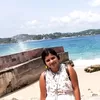
Places To Visit In Leh Ladakh
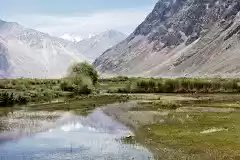
Travel Blogs for Chadar Trek - Trekking In Ladakh - Frozen River Trekking In Ladakh
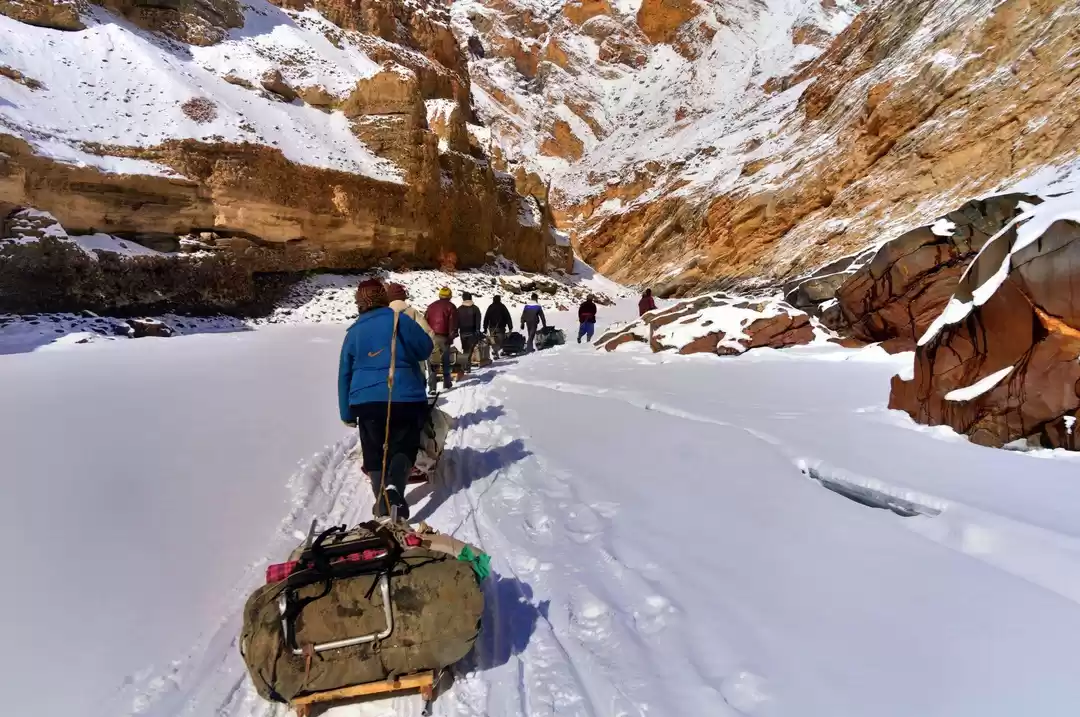

About Chadar Trek in Ladakh – Experience, Guide & FAQs answered
Treks & hikes , Ladakh
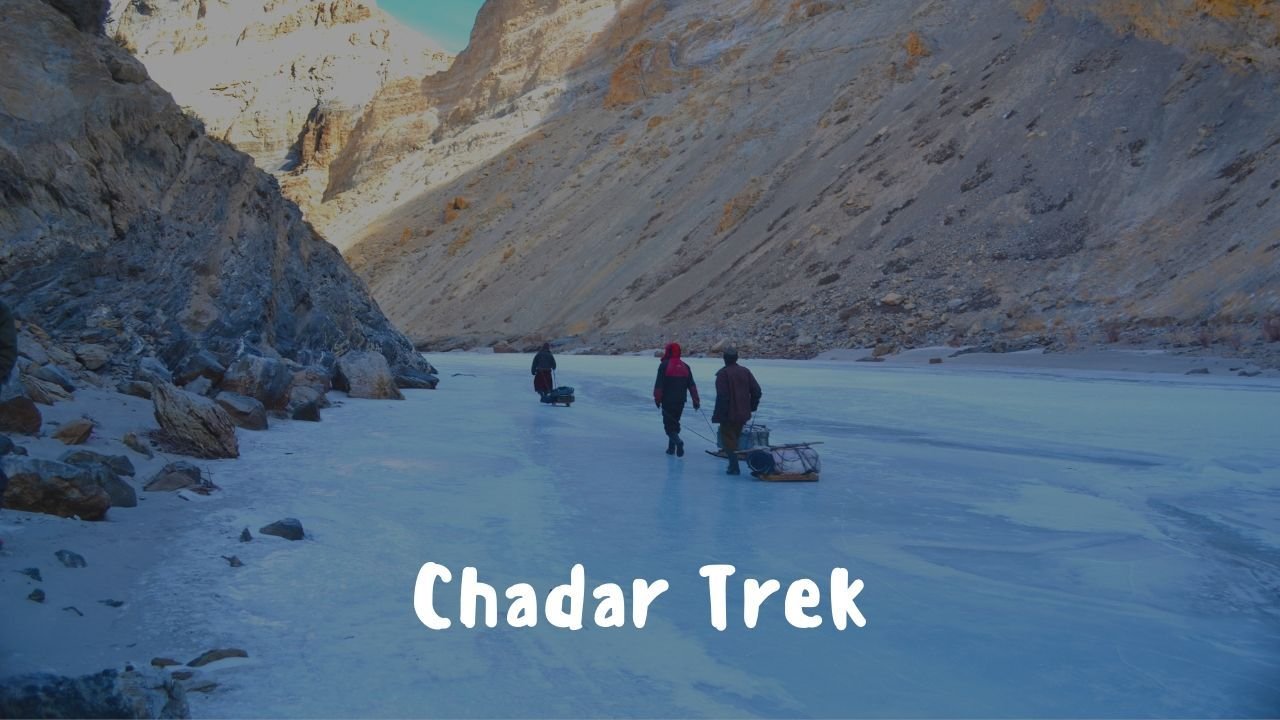
Last Updated on: May 20, 2021
The Chadar Trek is undoubtedly one of our favourite Himalayan treks. The first time we heard about Chadar Frozen River Trek in Ladakh, we were intrigued. When I came to know about the conditions in which we have to trek, I was a bit sceptical. Just imagine walking on a frozen river for almost 8 hours a day at an altitude of almost 11,000 feet. And did I mention the temperature? It is always below zero ranging between -5 to -35 degrees. Not inviting at all! I was finally convinced and we successfully completed the trek; but not without a few hiccups. So here we share our experience on Chadar Trek and a few tips to plan Chadar Trek.

Chadar Frozen River Trek | Chadar Trek
Chadar TrekTrek is considered one of the toughest treks in India. After all, you have to walk over a river, sleep on ice and might even have to wade through knee-deep ice cold water! I will not call it glamorous as many tend to call it; simply because, when Chadar Trek is associated with the word ‘glamorous’, it becomes one that needs to be ticked off the long ‘glamorous’ list. The Chadar Frozen River Trek is an experience, a feeling of wonder. We had done this trek long back in January 2014 – a time when there was not much rush of trekkers at Leh. Chadar Frozen River Trek was our second Himalayan Trek after Roopkund Trek the year before. While Roopkund made us fall in love with trekking, Chadar Trek made us understand the responsibility of being a better trekker or traveller.

What is Chadar Trek?
I always say that Ladakh is a place that never fails to awe its visitors. During the summers, Ladakh is vibrant with all the colours and sound of life. The same place bears a desolate and bleak look during the winter months. It is almost cut off from the rest of the world during this time and almost all the passes connecting Leh are closed due to heavy snowfall. The only way you enter Leh is by flight! Some of the villages become inaccessible during the winters due to snow and one can reach such village by trekking through frozen rivers!!!
The Zanskar River is a wild river gushing through the ravines and treacherous canyons of Ladakh. During the summers, the mighty river flows with all its fervour. But, during the winters, the river freezes and calms down. A blanket of ice forms over the river – thus letting the locals who are trapped in the inaccessible Zanskar villages walk over it and reach towards civilization in case of exigencies. This frozen blanket or “Chadar” (Chadar literally means blanket) is the only way in and out for the Zanskari villagers in winter.
The temperature during this time can be as low as -10 degrees in the morning and -25 to -30 degrees in the evening! A seven to eight days hike in inhospitable conditions over the river would take you from Padum, capital of Zanskar valley to Chilling, near Leh. The Chadar Trek, according to me is not just a trek; it is a symbol of hope and optimism. It signifies the indomitable spirit and courage of the people of the region.
Is Chadar Trek or Chadar Frozen River Trek Difficult?

Chadar Trek, as such, does not have a difficult trail. Yes, I repeat it again – the trail is not difficult , but it is definitely tricky. There are not much ascents and descents as you have in other treks. But, negotiating your way over a thin layer of ice over a fast-flowing blue river is no mean feat. The sub-zero temperature also does not help much. At Chadar, it is a constant fight of willpower to carry on with the trek!
For the trekkers, the Chadar Frozen River trek starts from Chilling, a few kilometres ahead of the Zanskar-Indus Sangam point and leads through the narrow canyons of the Zanskar valley. The trek ends at the Nerak village.
Chadar Trek – an unforgettable experience

Time spent on the Chadar Trek was surely an unforgettable experience. At one time, we were simply awed by the splendour and magnificence of nature. The breathtaking views of golden mountains, frozen waterfalls, hanging icicles the babble of river few inches below our feet simply mesmerized us.
On the other hand, we were also trying hard to cope with the harsh conditions of the terrain. For city folks like us where the temperature in summer goes as high as 40 degrees, trekking at sub-zero temperature is difficult. There were times when we were actually cursing ourselves as to why we are enduring such difficulty!
The first couple of days were really difficult for us. The chilly winds seemed to freeze us to the bones. As long as there was sunshine above us, all was well. As soon as we entered a shadow area, the biting cold returned.
Mornings in Chadar Trek
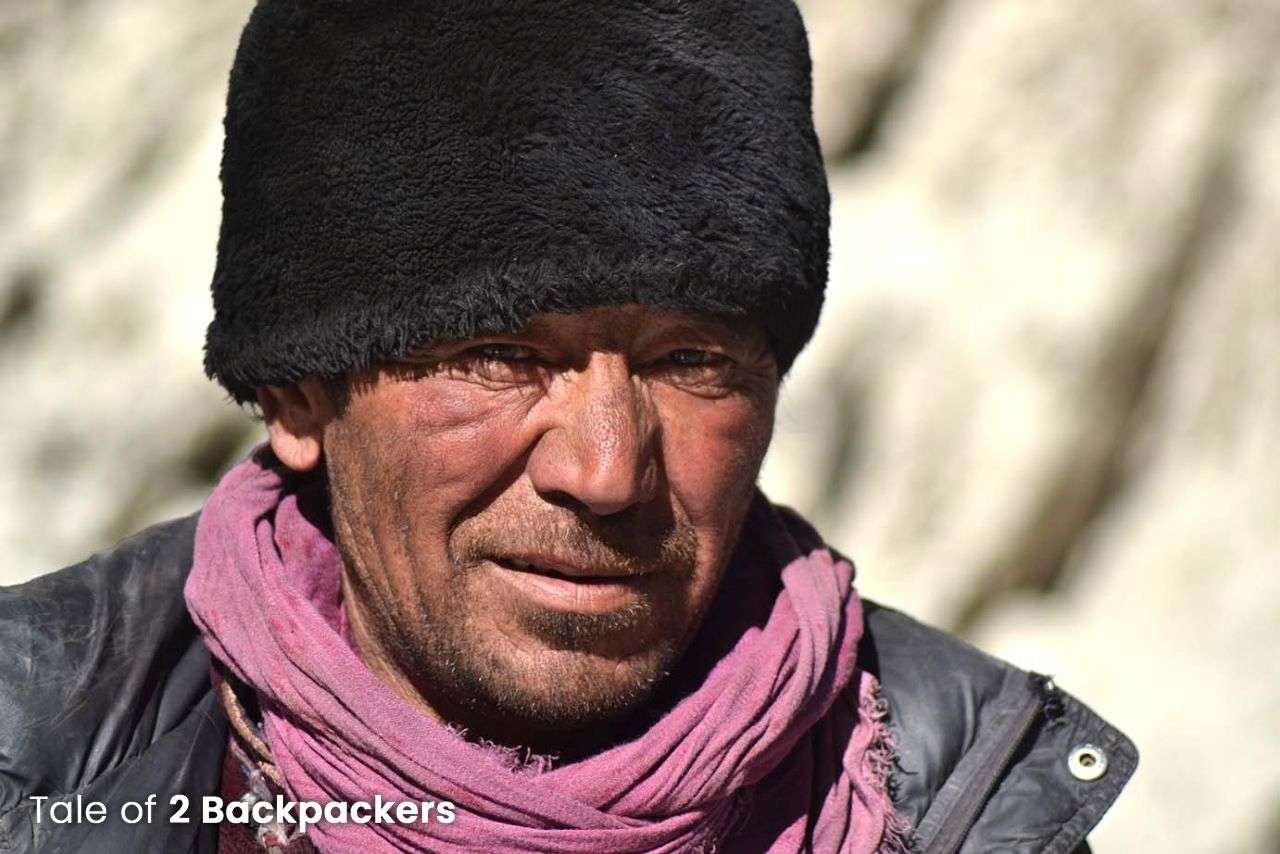
Early morning at the Chadar Trek made us feel that we were inside a refrigerator. At night, we slept inside 2 sleeping bags and covered ourselves fully. I did not cover my nose and mouth while slepping, because I feel nauseated if I do so. When I used to wake up in the morning, I would find ice frozen on my hair and top of my nose. After waking up, my hands and feet used to go numb totally. The only therapy there was to walk and walk fast until our feet responded again. Well, going for daily ablutions was also quite a pain. But this is something that cannot be avoided! So I just used to clench my teeth and go towards the toilet! Phew, it was really some experience.
Gradually, as a couple of days passed, we started getting a hold of the Chadar. We started understanding the place and the terrain. The sound of the flowing rivers underneath our feet sounded like music to our ears. The sound of the flowing river changes according to the thickness of the Chadar or ice blanket. The guides have great knowledge about this and by the sound of the river, they can predict quite accurately whether it is safe to move on that patch of ice. Finally, we also started mastering the technique to walk over the ice. One needs to walk like a penguin-like stance on the ice so as to not slip and fall.
Chadar Trek | Walking over Ice
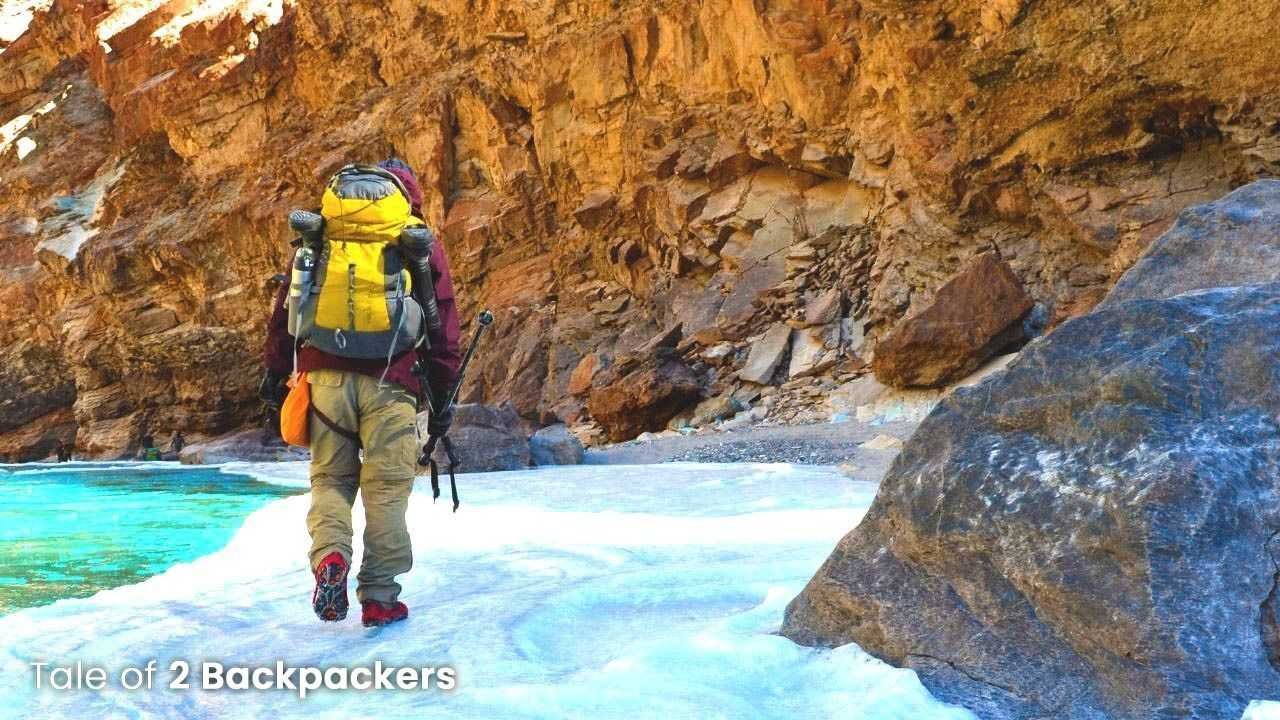
The entire trail path of Chadar Trek might not be uniform. At places, we found fresh snow, while at other places we had to tread on hard ice. Walking on soft snow is relatively easy than walking on hard iceAs I mentioned before, we had to walk slowly in a penguin kind of way. On the first few days, we lost count the number of times we fell down while walking. Gradually, we started walking in the perfect way. Experienced trekkers, as well as the locals, fall down on hard ice. The only thing you do in such situation is to rise again and start walking again with the same zeal and spirit.
You might be given crampons to walk over the ice. It will definitely make your walk easier, but it is not good for the ice blanket. The pressure of the crampons breaks the ice easily.
And at some places, there was no ice blanket at all. It is broken, weak or not formed. The river flowed with all its might!! Here we had only 2 options – either we made our way through the chilling water. Gumboots came handy during this time. Or if the water was quite deep, we had to climb over the mountains to cross the broken Chadar. What an experience it was!
Evening and nights at Chadar Trek was always beside the campfire trying to warm ourselves. We always used to have an early dinner and go off to sleep early. But the campsites below the clear starry skies were a beauty to reckon. Those were some of the best starry skies I had seen.
Chadar Trek campsites
Chadar Trek boasts of some very difficult campsites. The locals usually stay at the caves during the night. If you are going with some trekking agency, you might be provided with tents. Personally, our favourite campsite is the Shingra Koma campsite. It is a big campsite beside a frozen stream. As you walk down the stream exploring, you will encounter a frozen waterfall. The whole place will look as if straight out of some Hollywood movie.
Chadar Frozen River Trek route
Leh is the basecamp of the Chadar Frozen River Trek. Tilat Sumdo is the first campsite for the trek. But once you arrive at Leh, please spend at least 2-3 days for acclimatization. In the winter months, you have to fly into Leh. So acclimatization becomes even more important. Spend these 2-3 days doing nothing. Acclimatization is very very important to prevent AMS.
Chadar Trek starts and ends at the same point. And on the way, we encountered ice sheets, countless frozen waterfalls and all the wonders of nature. The route we followed for the trek:
Leh – Tilat Sumdo – Shingra Koma – Tibb – Nerak – Tibb – Shingra Koma – Tilat Sumdo – Leh
Day 1,2 & 3: Leh (11,400 ft)

After arriving at Leh, we stayed at Leh for 3 days to acclimatize. The first 2 days, we confined ourselves to the hotel and only roamed a little on the streets of Leh. On the third day, we visited the Shanti Stupa in the evening.
This rest for 3 days is required. And I will keep on reiterating this, AMS and acclimatisation throughout this blog.
Day 4: Leh – Tilat Sumdo (10,390 ft)
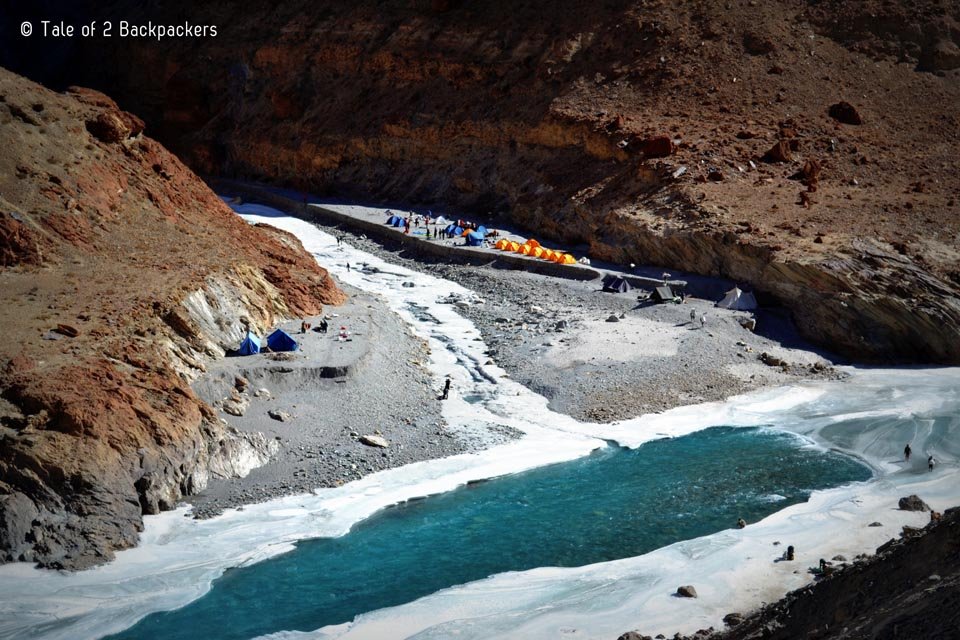
We started from Leh by road and arrived at Chilling. On the way, we stopped at Nimoo, the confluence of the Zanskar and Indus River. The rivers were frozen during this time. It looked so different from the time we had visited earlier during August. From Chilling, we had to climb down to the river bed. The place is known as Tilat Sumdo. It was our campsite for the night.
We reached at Tilat Sumdo in the afternoon. Once we were there, it was the time to get acquainted with our fellow trek mates. Our trek leader briefed us about what lay ahead of us for the next 8-9 days. We also took an acclimatisation walk on the icy river bed. Our trek leader showed us how to walk on thick hard ice. It was difficult for the first time. I kept on falling down. But the others encouraged me to again get up and walk. I guess that day the number of times I fell down in one day exceeded that of my entire life till that day!
After all the fun of walking and falling, our trek leader called it a day early so that we could get a nice rest. “The real fun starts tomorrow”, he grinned at us.
Day 5: Tilat Sumdo – Shingra Koma (10,550 ft, 10 km)

The next day, we started our trek from Tilat Sumdo to Shingra Koma, which is about 10 km away. The walk was not easy. We had to walk in the penguin kind of way. And of course, pay heed to our guides. They know the region the best.
Day 6: Shingra Koma – Tibb (10,760 ft, 14 km)
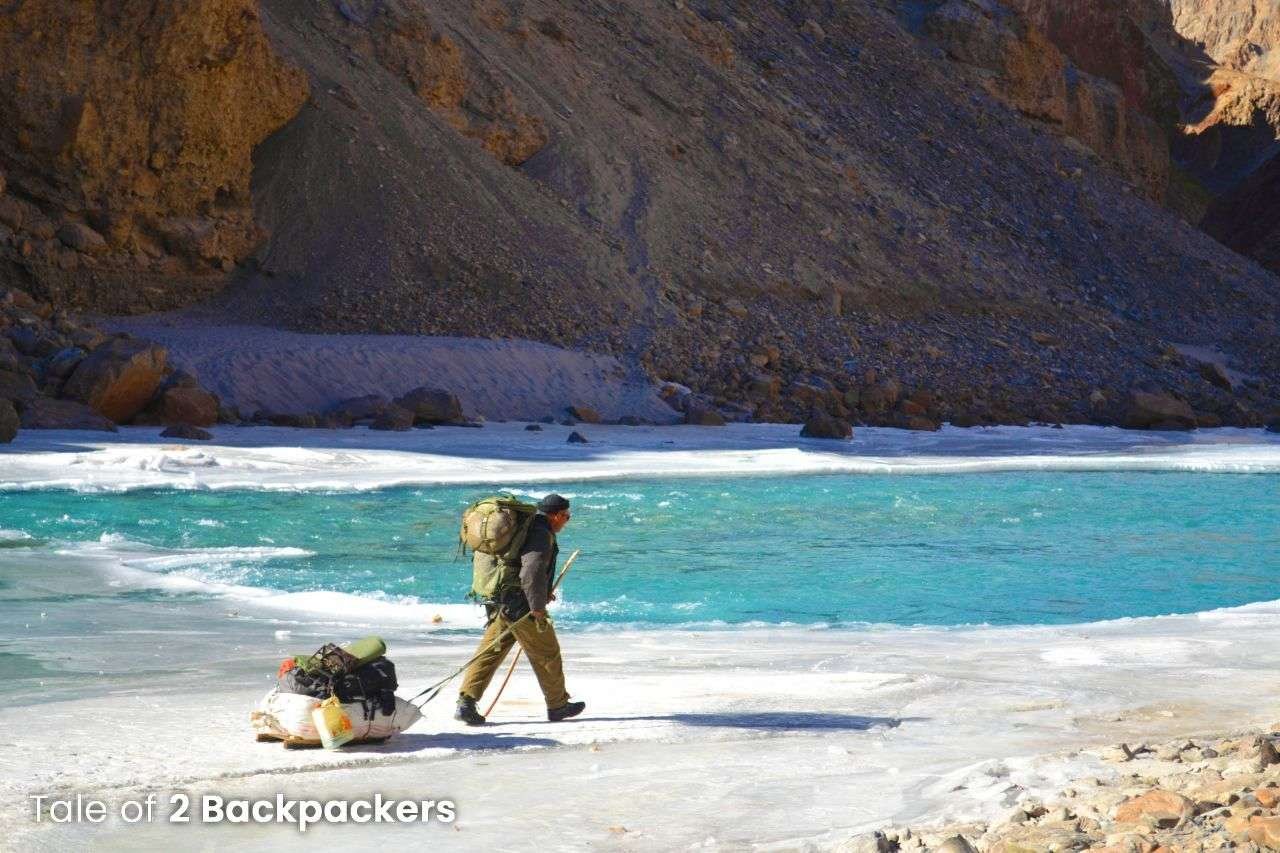
The biggest challenge this day was to wake up early in the morning and get ready for the day’s trek. It was so cold! All my hands and feet were numb. It was actually a great pain to go to the toilet and then get ready for the trek.
It was a long day of the trek and it took us about 6 to 7 hours to reach Tibb. We started by 8 AM and walked over the ice blanket. The sun, as usual, played hide and seek with us. Just as the sun god hid behind the clouds, we could feel the cold. As we trekked, we simply wandered at the splendour of nature all around us. The ochre mountains on both sides looked like canyons and the frozen waterfalls on them left a confound impression on us. It was something that I would never forget. On the way, we even came across the paw marks of snow leopards. Finally, by afternoon we reached our campsite at Tibb. There is a cave there where the locals usually stay for the night. We, however, stayed at tents.
Day 7: Tibb – Nerak (11,150 ft, 12 km) | Which did not happen

Yes, we could not continue our way to Nerak this day, we started as usual after fighting off with the cold. We went along quite a long way when our trek leader stopped us. Apparently, the ice blanket had broken at one of the places and the water was also quite deep. By this time, we already had waded through knee-deep water wearing our gumboots. But here the water was quite deep. After deliberating some time, it was decided that we would climb up the mountain-side and cross the water part.
Well, this was also not an easy task. The mountain trail was gravelly with loose stones and gravels. And it was definitely steep. Just a miscalculation of steps and I would fall deep down in the water. I saw many of my teammates took the trail and went on to the other side. When my turn came, I took the names of all the Gods I remembered. I was scared. Very scared. I did not want to fall down to the water.
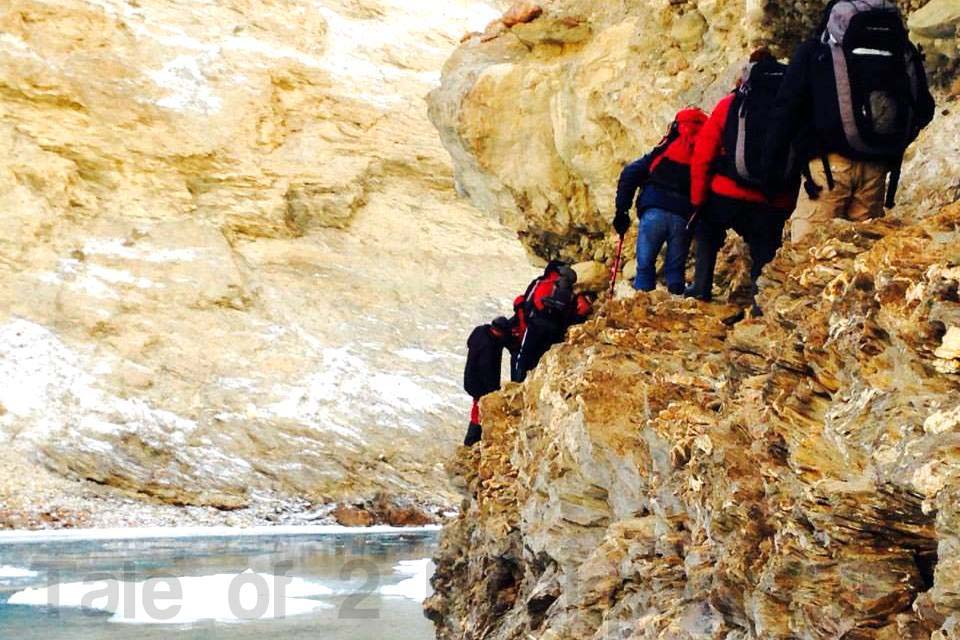
I started slowly treading my way through the trail made for the trekkers. There were tricky parts where Agni and my team leader helped me negotiate. At one moment, I felt that I would simply fall down. But finally I managed to cross the patch. And yes, I was quite happy at the feat. But at the same time, a thought lurked behind my mind. I was now apprehensive about how many such trails we have to cross. Nevertheless, we started again.
After about an hour of trek, we stopped again. This time also, the blanket was broken and the water was too deep to wade through. One of the guides went ahead to see the path ahead. He back with a bad news. He informed us that the path beyond was broken totally. Even if we managed to cross this stretch, we would not be able to do it further.
It was time for a decision. Our team leader decided not to go further and we camped there for the night. It was decided by the guides and our leader that we would wait there for another full day. If the Chadar formed within this time, we would continue. Otherwise, we have to retrace our way. All of us prayed to whichever Gods we believed so that the ice blanket formed again. We did not want to return back after coming so close to the destination.
Day 8: Somewhere in between Tibb and Nerak (The Chadar did not form)
Well, the Chadar did not form even this day. So we used our spare day at the same place. If it did not form the next day, we were to return.
Day 9: To Nerak
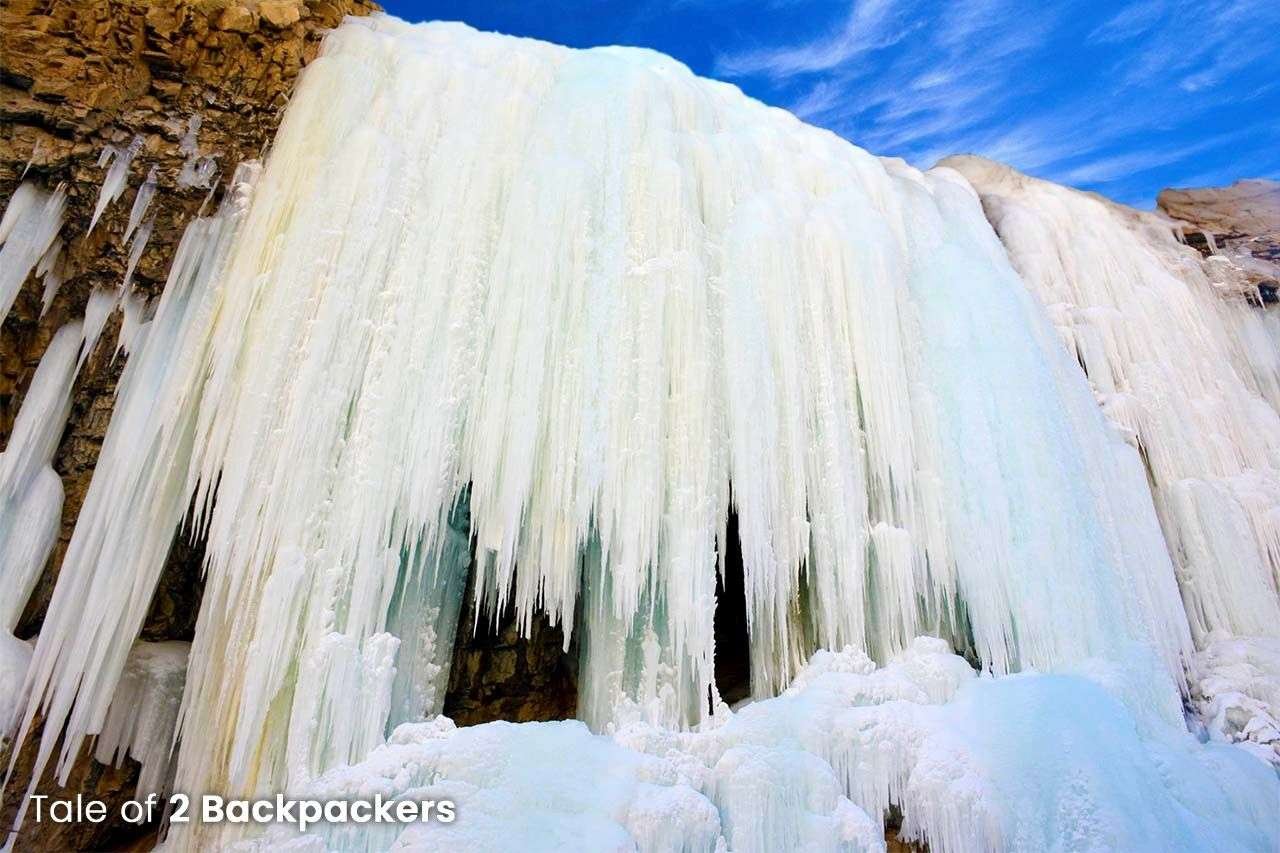
Thankfully, the weather gods took pity on us and listened to our prayers. The ice blanket was formed and we started our trek again. We reached Nerak early. Nerak is known for the huge frozen waterfall. Next to the waterfall is a bridge that takes to Nerak village. We camped at Nerak for the night.
Day 10: Nerak – Tibb
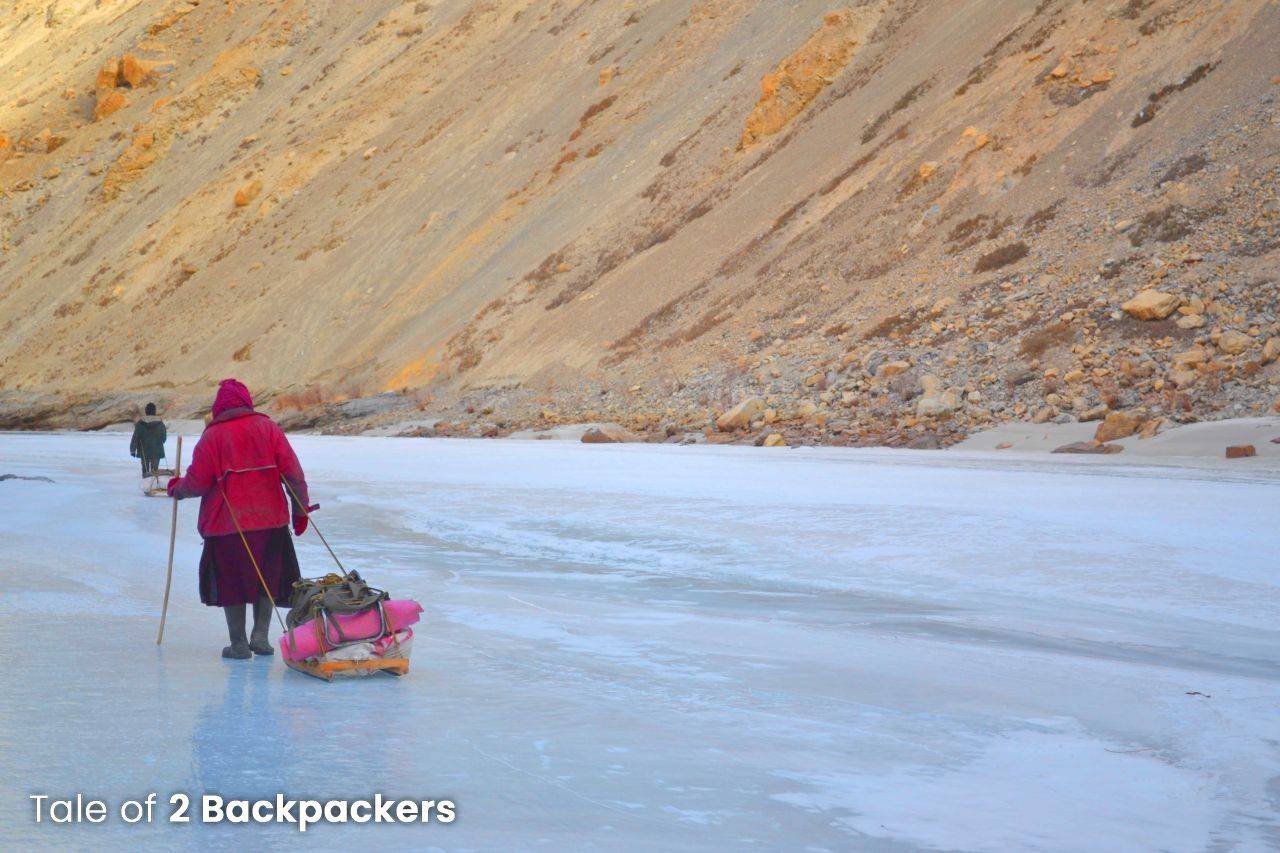
We retraced our steps through the same trail. However, the trail was no longer the same. Well, the mountains were definitely at their place. But the ice blankets, river course changed. It felt as if we were trekking on a different route. That is the beauty of Chadar.
Day 11: Tibb – Shingra Koma
We followed the same way back.
Day 12: Shingra Koma – Tilat Sumdo – Leh
We trekked back to Tilat Sumdo and then returned to Leh by a car.
What is the best time for Chadar Trek?
Chadar trek completely depends on the ice blanket or Chadar formed on the Zanskar River. The best and only time that you can do this trek is between mid-January to mid-February.
Chadar Frozen River Trek | FAQs answered
Is the chadar trek difficult.
Yes, Chadar Trek is definitely a difficult high altitude trek. Physical fitness is absolutely essential for this trek and those suffering from asthma or other chronic diseases should not go for this trek.
What is the experience required for doing the Chadar Frozen River Trek?
You need to have done at least 4-5 Himalayan treks before you decide to do Chadar trek, out of them at least one should be a moderate one. The trekker must also have an experience of trekking more than 2500 m before. The trekking trail is not difficult per se, but the conditions of the trek are quite harsh. We would definitely not recommend first-timers to go for this trek.

When we went for the trek, we had already done 3 high altitude Himalayan treks. But we found that there were a couple of first-time trekkers too in a different group. The trek operators might allow a novice trekker to do Chadar trek for some income, but this is absolutely not the right thing. It is neither good for you and nor for Chadar.
What to pack for Chadar Trek?
Since you will be trekking in sub-zero temperature, clothing is very important. Layering is the mantra at Chadar trek. Wear layers of clothes. We usually wore our thermals inside, then a tee, a fleece and then our windproof jackets. Sometimes, I used to wear t tee-shirts. Here is a list of things that you need to pack for the trek.
- Warm clothes including fleece, heavy jackets and thermals.
- Balaclava and other woollen cap or scarf
- Several pairs of socks
- Good trekking shoes
- Gumboots to wade through the water parts
Other important things to carry for Chadar Trek:
- Trekking Pole
- UV-protected sunglasses
- Water bottles
- Thermal water bottles
- Hot water bags
- Headlamps and torches
- Basic medicine kit and toiletries
- Toilet Paper
How to reach Leh?
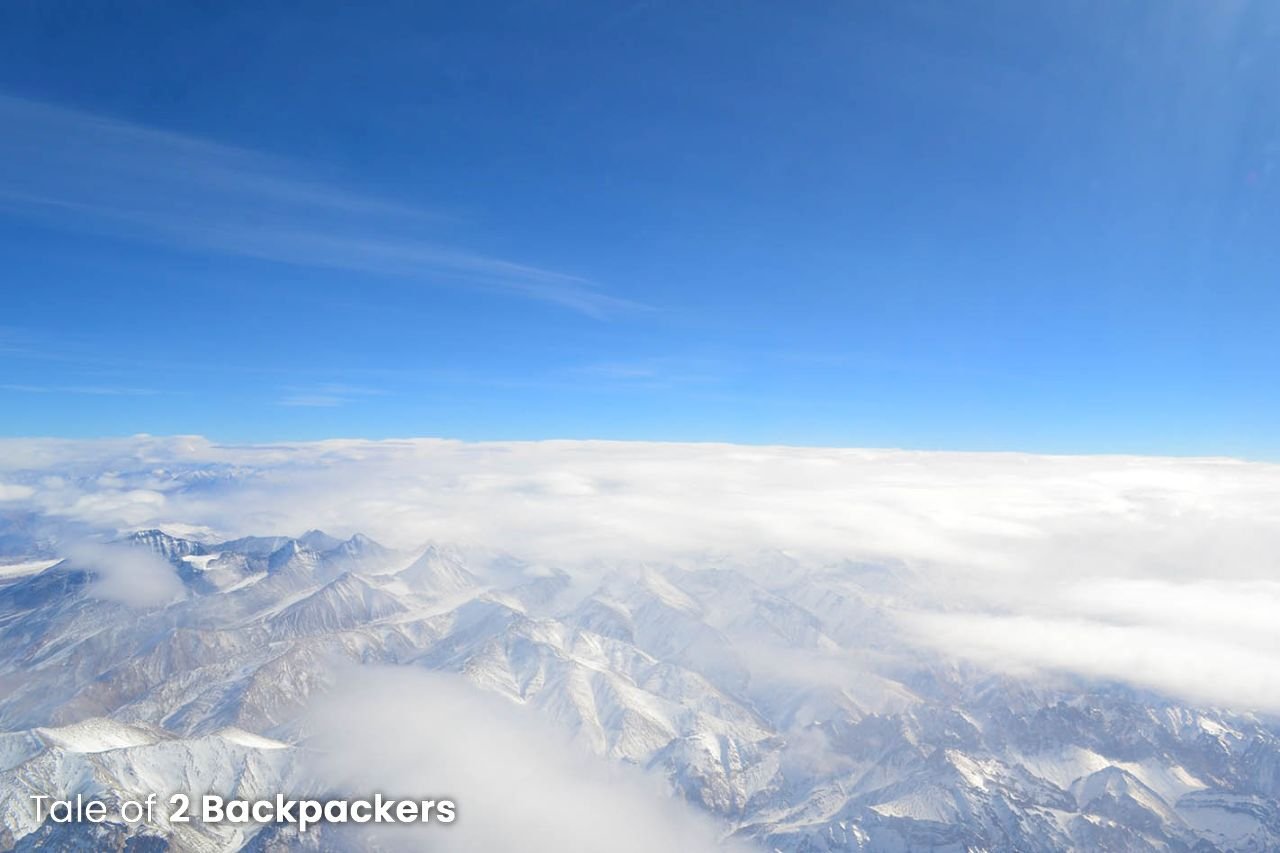
The only way to reach Leh during the winter is by flight. Leh Airport is connected with all the major airports of India. While on the flight, you can see the snow-covered mountain ranges and the Zanskar river from a height.
How will be mobile connectivity in the trek?
You will get BSNL connectivity in Leh. There will be no mobile connectivity during the trek.
How many days are required for the trek?
A total of 8-9 days are required for the trek. You will need 1 day to acclimatize and then another day for the medical checkup at the Government check-up centre. We would always recommend you to spend atleast 2 days for acclimatization to prevent AMS.

What is AMS?
AMS or Acute Mountain Sickness is actually the effect on the body at a higher altitude environment. AMS is quite common in higher altitudes, usually above 8000 ft. the occurrence of AMS depends on the altitude, the rate of ascent and individual susceptibility.
The symptoms of AMS are headache, dizziness, fatigue, shortness of breath, loss of appetite, nausea, disturbed sleep, and a general feeling of malaise. While trekking it is extremely important to look for the symptoms of AMS. And if you feel any of the above discomfort, you should immediately report to someone and see a doctor.
AMS can hit anyone at any time. Severe AMS has even taken life of even fit persons. So acclimatization is very important while you are in Leh, even if you come for a Ladakh trip.
If you experience the symptoms of AMS on your trek, please let others know. Do not ignore them. At such conditions, do not ascend further with the symptoms. Often Diamox is suggested as a preventive to AMS. Please consult with a physician before if you want to take it. Also, remember, Diamox is a preventive and not a curative drug. So you have to take it from before the start of the trek. There is no point in taking Diamox after you have AMS. There can be certain side effects of taking Diamox like frequent urination and tingling sensation in hand.
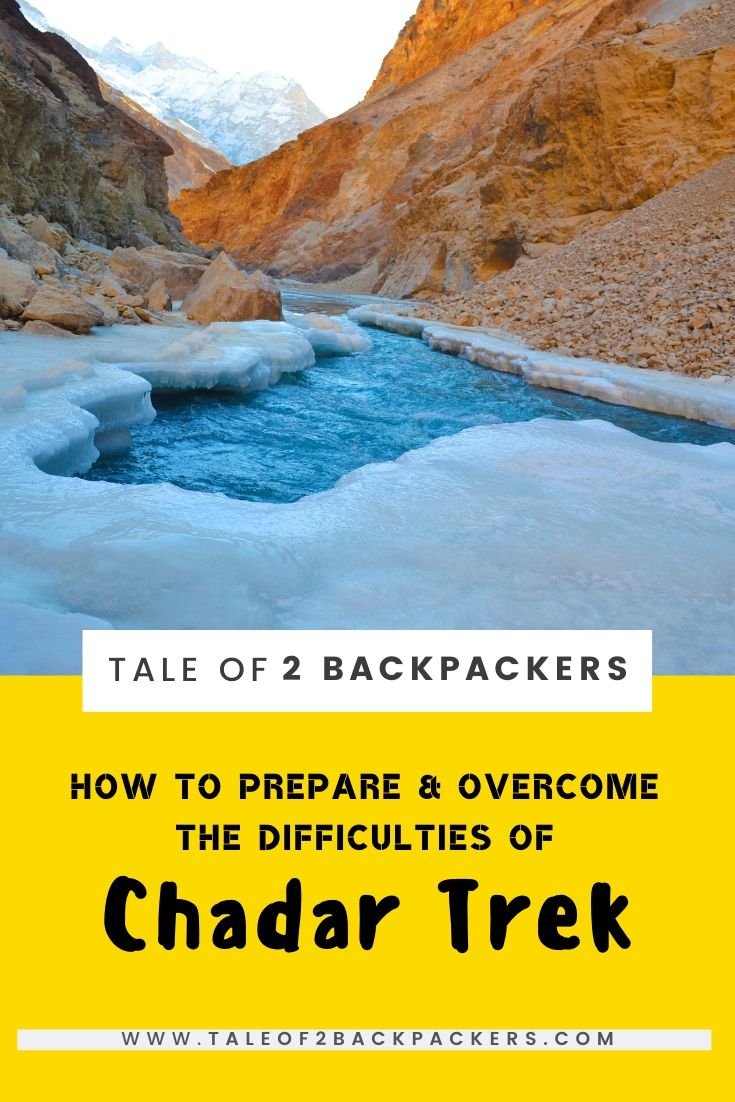
What is acclimatization?
During the peak season, when you can enter Leh by road, you can stop a night at a lower altitude (Kargil is usually suggested as a stop for the night before entering Leh). But during the winter months, you will be coming to Leh directly by flight. Delhi is at an altitude of 709 ft while Leh is 11,480 feet. There is such a gain in altitude within just a couple of hours. The body needs time to adjust to this change in altitude and so it is very important to stay at Leh for at least 2 days doing simply nothing. This process is known as acclimatization.
Responsible trekking at Chadar Trek

By now, you must have understood that the region has an extremely fragile environment and ecosystem.
The frozen Zanskar River offered a lifeline to the Zanskari villages to reach Leh, when snow closes all the land routes. The Chadar trek was their winter lifestyle. But with the popularity of this trek, also came a threat. During the last few years, the number of trekkers in Chadar increased exponentially. It had an adverse effect on the Chadar trail. With more trekkers walking on the ice blankets, it is creating a pressure on them and the blankets are broken.
Also the trekkers, guides and porters think little before littering the ice with garbage. Defecation also creates a problem in the higher altitudes. The normal decomposition process is already slower in the high altitudes. So it is not rocket science to understand that with so many trekkers, the toilet pits will become the breeding grounds of bacteria, which would ultimately contaminate the soil and water. Because of this irresponsible human activity leading to plastic waste, human waste and other harmful wastes, we heard that the Chadar trek is going to be banned in the future. While we do not agree that banning can be a solution to these problems, but we definitely urge all the trekkers to be more sensitive and understanding of the local and ecological issues.
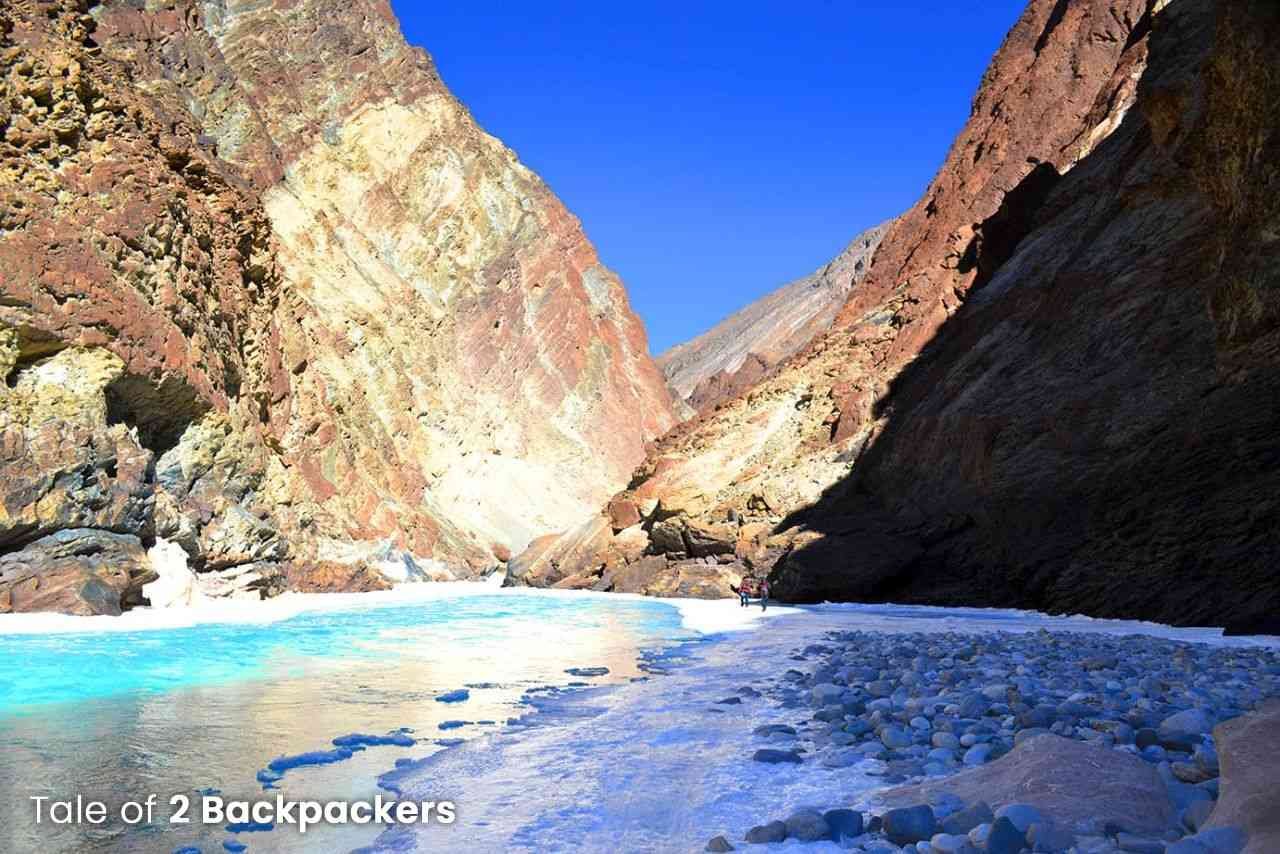
Some Tips to help you with Chadar Trek
- Acclimatise. Acclimatise. Acclimatise. This is the first tip that we would give you. Yes, we are repeating it every now and then, but this is most important. Spend at least 2-3 days in Leh doing nothing to get yourself acclimatized.
- Carry sufficient warm clothes as the temperature can be really harsh. And keep extra socks. They can be really helpful.
- Keep your backpack light and pack well. You would not like to get burdened with a heavy backpack on your trek!
- Drink water at regular intervals.
- Do not skip your meals.
- Absolutely refrain from alcohol and smoking. Not even a swig of brandy for tackling the cold. It will do more harm.
- Listen to your guide. Do not challenge them. They know the area much better. So follow their words religiously.
- Do not carry plastic items and please do not litter the trail.
- Do not use soap and shampoos in the waterfalls (if it is not frozen) and the open water sources. The locals use this water as their drinking water.
- For relieving yourself, please go to the designated area for the toilet.
- Keep buffer days while planning your trek. You never know when you get stuck in the trail.
- Avoid wearing crampons or microspikes. It is not good for the ice blanket. Initially, you will find it difficult to walk on ice, but you will definitely get a hold of it soon. You might fall down, but let that not deter you from walking.
- Be careful with your camera and other equipment. A guy in our group slipped while taking photographs and his camera fell in the river and was carried away!
Finally, enjoy and appreciate Chadar Trek with all its challenges. And while you do that, respect the nature, the landscape and the locals. While you definitely get the bragging rights of completing the Chadar Trek, but that should not deter you from doing your bit and being responsible.
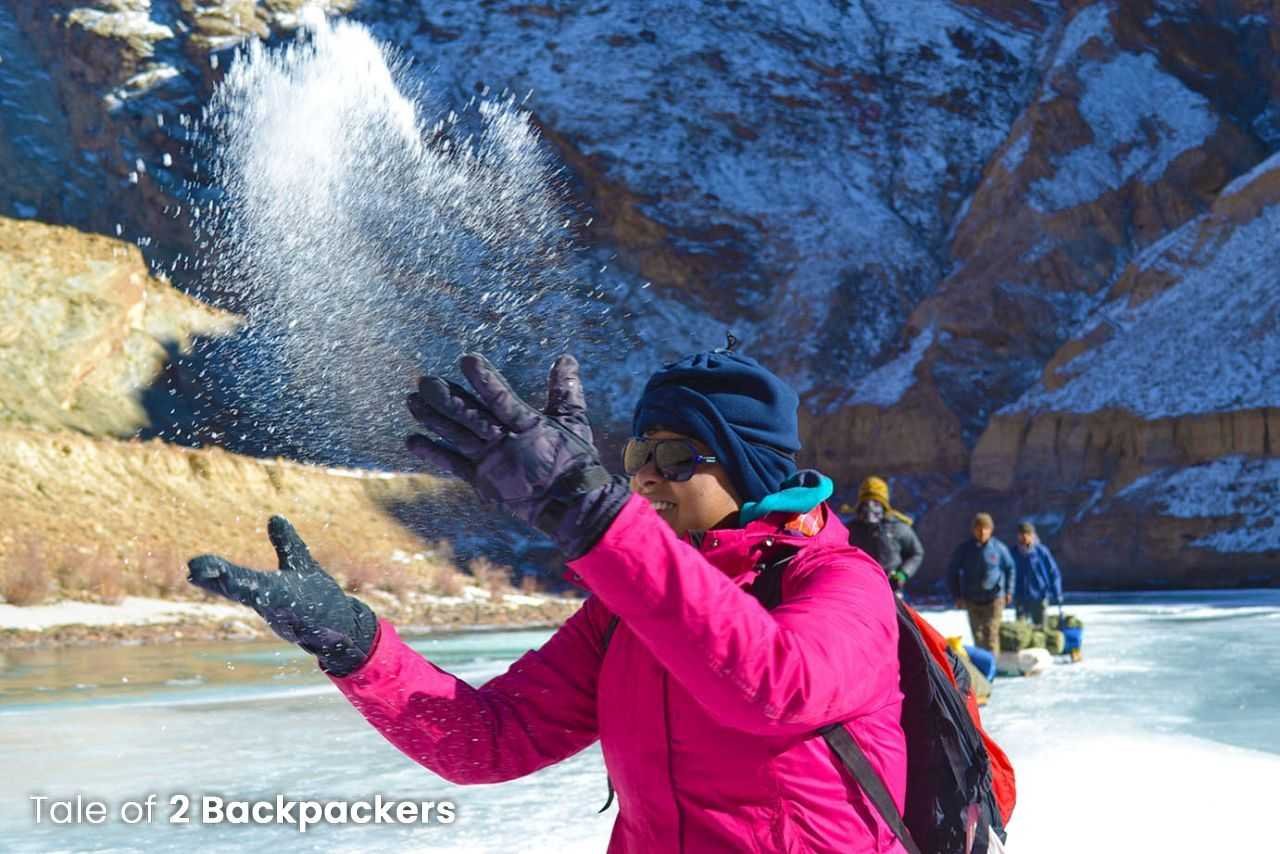
Chadar Trek was a changing point in a number of ways for me. The first thing that I realized on the trek was that we take nature around us so casually. We all are responsible in some ways or the other for environmental issues, either by using plastics or by our lifestyle or by some other reason. We might not be able to rectify all, but we can do whatever there is in our hands. Chadar Trek made me realize the importance of a responsible traveller, a responsible human being.
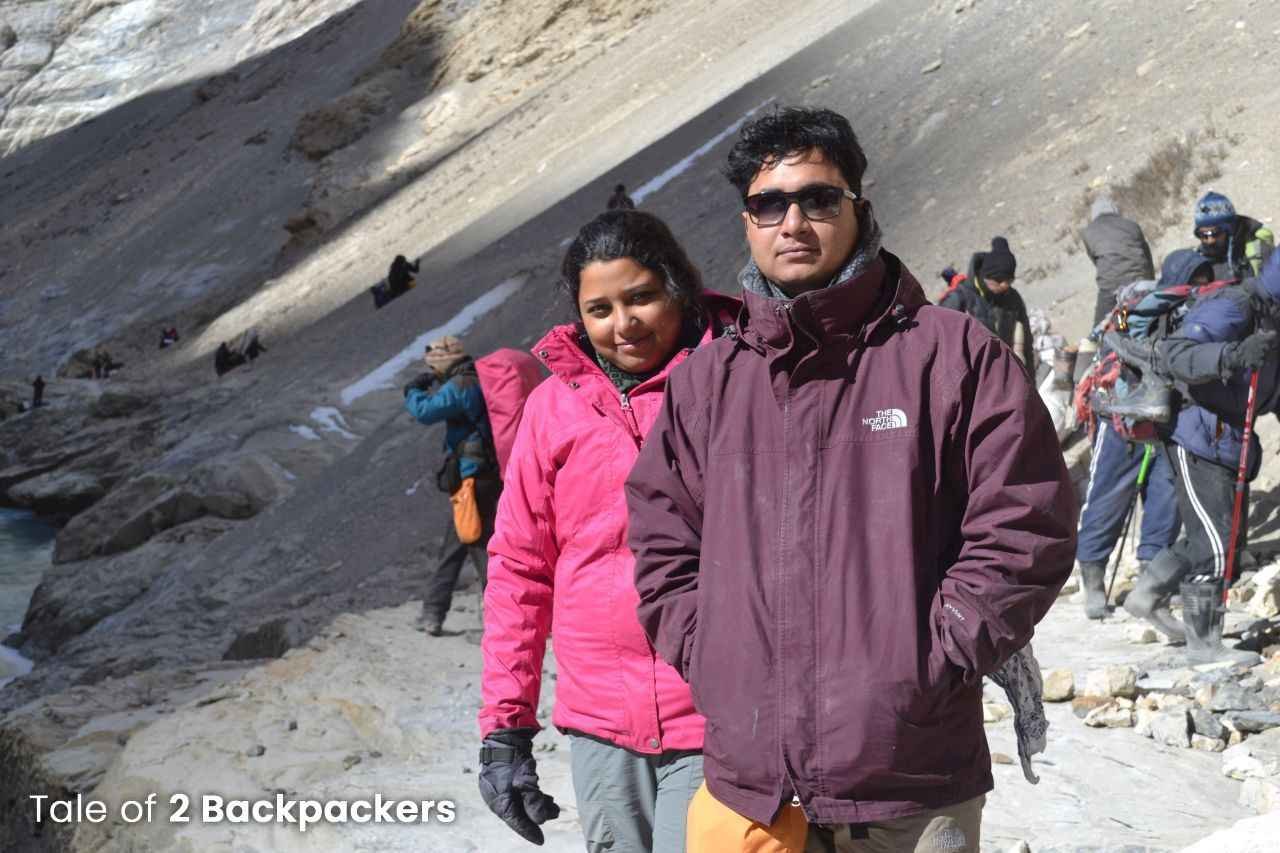
Chadar brought out the best and worst in me. In such harsh conditions, I found out my worst qualities as well as realized what I am capable of.
And the most important lesson that Chadar trek taught me is that everything in the world is ephemeral. Nothing lasts forever. Just as the Chadar is dynamic, changing its shape and course all the time, life too is not meant to be lived confined. Challenges are a part of life and are meant to be met with a smile on face and determination in the heart.
Have you done the Chadar Trek? How was your experience? Let us know in comments below. If you want to know anything else about the trek, please ask in comments below or send us a mail.
Pin this for a later read!
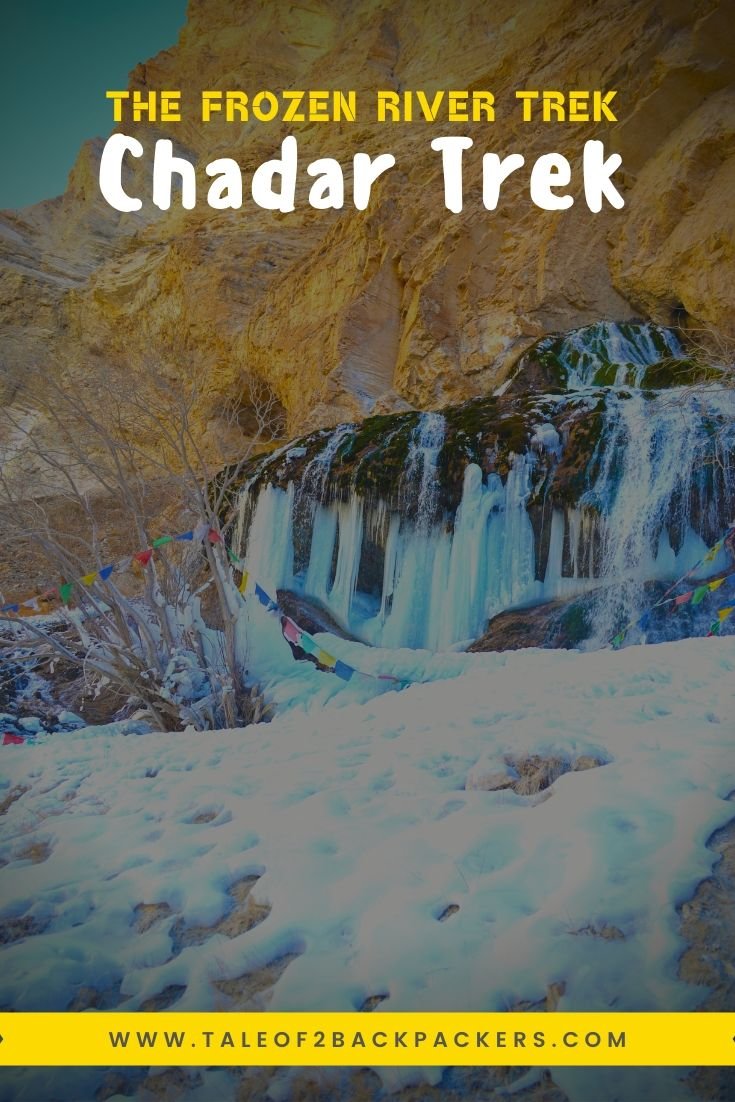
Agni Amrita
Related posts.

Hunderman – Ghost Village near Kargil with Museum of Memories
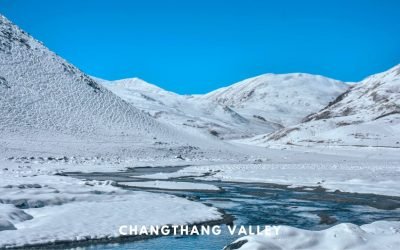
A Trip to Changthang Valley in Ladakh and a Failed one to Tso Moriri
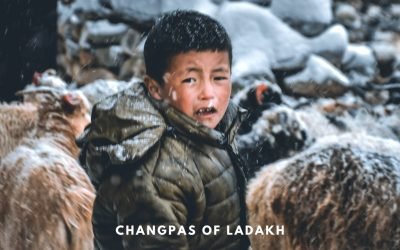
Changpa Tribe of Changthang, Ladakh – The Story of Pashminas
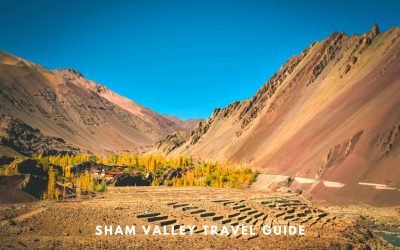
Sham Valley in Ladakh – A Complete Travel Guide
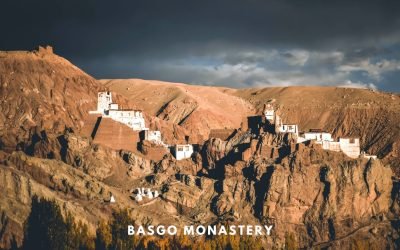
Basgo Monastery, Ladakh – Ruins of Palace and Fort
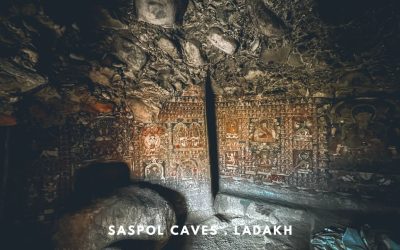
Saspol Caves – Best-kept Secret of Sham Valley, Ladakh
28 comments.
Really loved your honest and fantastic narration of the Chader trek. I have been waiting to do this since a couple of years and I am finally planning to do this in Jan 2024. I will be traveling solo, and wanted to ask you about any good trekking group which cater for women trekkers as well, cause there are so many, and it’s difficult to understand which ones are actually good. Many thanks for this lovely post I really enjoyed reading it.
Thank you so much! We are so glad that you are doing the Chadar Trek. It is a lifetime experience for sure. You can do the trek from any reputed trekking companies in India. We did it with Indiahikes. Thanks again.
I am planning to do the trek in Jan 2022 and just happened to check your post today. Ideally, how many months should one book this trek in advance ? it is just the beginning of winter so would it be fine to book now or one should wait for some more time and then go ahead based on the winter conditions on leh. what do you suggest ?
Assuming that you are trek fit, you can book the trek even 15 days before. But please be sure of your fitness and learn about winter conditions in Ladakh if you plan to do this trek. email us if you have any more queries. Thanks and have a great trekking experience.
Fantastic post. Your narration was so beautiful. Do we have a satellite phone facility during the trek?
Thank you so much. Glad that you liked the article. Yes, there will be satellite phones with your trek leaders.
Wow that trek looks very intense. I love hiking and have done many multi day treks but nothing like that. I am not a fan of the cold and I can’t imagine hiking in those temperatures!! Your pictures though are amazing and it is certainly a challenge I could be tempted to do one day!!
Thank you Clare. The trek was a test to my perseverance and will power!
Just reading the first para about the altitude and temperature and time, it already sounds exhausting. So, super congratulations for completing the trek inspite of these harsh realities!!! You’ve been to Roopkund already? Whoa! Hats off to you!!!! //Ice frozen on the hair on my nose// – What???? OMG! That’s brrrrrrrrrrrrrrrr cold! I have never walked on thin ice or frozen river so far, and I can’t imagine how would it be to do it all day long for days together! The frozen waterfalls of Nerak looks so so so splendid!
Haha! I liked the way you described the experience about ice on hair and nose! Chadar Trek is a really an experience.
The thought of walking on a frozen river at almost 11,000ft for about 8 hours a day would intimidate me too! After reading your post I believe you that the Chadar Frozen River Trek is the most challenging in India. I bet you feel so accomplished now! I love reading about difficult hikes like this, but they are not for me! Waking up with ice on my nose, no thanks….lol.
Thank you Elizabeth. Yes, Chadar Trek is one of the most challenging treks in India. I would not say the most challenging!
Amrita, I am overwhelmed with admiration for your perseverance, fortitude, and endurance! I was near tears just reading about your Chadar Trek experience in Ladakh and the many challenges you faced. I cannot imagine waking up with ice on my face and hair and slogging through frigid water, let alone navigating the mountain ledges. You must feel so accomplished and now have yet another amazing experience in your memory to draw should you ever face difficult times. (If you can do this, I believe you can do anything.) I am in awe of you.
I would love to have seen snow leopard tracks and that beautiful frozen waterful first hand. While you provided really important tips for anyone attempting this trek, I am grateful to have seen both wonders–along with many other natural beauties–through your eyes.
Thank you so much Jackie for your words. This means a lot to me as I am one of your admirers. Thanks again.
I am enjoying reading all about your hikes in the Himalayan Mountains. I may never get to do these myself. So it is interesting to read about ones like the Chadar Trek. Even as a Canadian I am a winter wimp. So walking on a frozen river at such cold temperatures would not be my kind of thing. Although I can see why the beauty would drive you to want to visit. What an adventure you had!
Thanks Linda. I am also not particularly fond of very cold. But Chadar trek experience was totally out of the world.
I can not even imagine walking on a frozen lake for 8 hours. AND it isn’t completely frozen. Isn’t there some rule about it needing to be completely frozen to a certain depth before walking on it? And having ice frozen on your nose when you wake up cannot be healthy. I obviously have anxiety issues, I would have been scared too. All that being said, it is beautiful. And you didn’t die. And this is a huge accomplishment!!!
I can totally understand your anxiety. I too was scared before going for the trek. But it went on well and we were back all hale and hearty.Yes there are rules about walking on frozen rivers. The guides look after that.
What a great post! I admire your strength for being able to do this trek! As a Canadian, I understand how cold those temperatures can feel and cannot even imagine trekking and sleeping outside in those conditions. I’m very impressed! Nerak looks so beautiful and would be the place I would be most excited to visit. I also appreciate that you pointed gave tips on how to be a responsible traveller and not abuse the natural landscape!
Thank you Erica.
This adventure looks so cold! And amazing! I haven’t done a trekking adventure yet and I’m not sure it is on my bucket list. I am more into long distance cycling!
Yes, it was cold! But was also beautiful.
I love reading your final thoughts after the trek that everything in the world doesn’t last forever and I totally agree with you. Thats why we should appericate everything we have and try not to ruin it. Also I would love to do this trek, it looks amazing (and a bit cold). 🙂 I would seriously consider doing is trek if I was in the Leh area, it is on the plans but I havent chosen which hiking trails I would like to do. My time will come.
Thank you Danik. It was really cold there. 🙂
I really enjoy to read your Chadar Trek diary, it also encouraging me to do this trek in the future.
Thank you so much. Glad that we could inspire you!
Your pictures bring your experience alive. Have heard so much about Chadar and after seeing your post, want to head there now.
Thanks Ami… Chadar is definitely an experience…
Submit a Comment Cancel reply
Your email address will not be published. Required fields are marked *
Submit Comment
This site uses Akismet to reduce spam. Learn how your comment data is processed .
Pin It on Pinterest

Chadar Trek Ladakh: Your Ultimate Wonderland Expedition Guide
- Updated on April 2, 2023

The Chadar Trek is one of the world’s most challenging and exciting treks. It provides the ideal opportunity to discover a completely new environment in the Zanskar Valley. The Chadar Trek, also known as the Zanskar Gorge, is a winter trek that rises 11,123 feet above sea level. Throughout the summer, people flock to the lower region of this valley for river rafting excursions. During wintertime, the Zanskar River freezes, and hikers flock to this area to appreciate the scenery.
As part of the ‘Chadar’ (ice sheet) trek across the frozen river, visitors and trekkers from around the world enjoy the spectacular scenery and surprises it offers.
Table of Contents
What is the ideal time to plan your trek to Chadar?
January and February are the best months to go on this beautiful trekking excursion. Specifically, if you schedule your trip between the 15th of January and the end of February, you will be able to appreciate the unparalleled splendor of Zanskar Valley. The river freezes into a gleaming sheet of ice, and the valleys create a pure white track for trekking adventures. Furthermore, the snow-capped mountains that accompany you all the way shimmer and sparkle in the first rays of the light.
During the day, the temperature in Leh varies between -10 & 0 degrees Celsius. At night, the average temperature is about -25 degree celsius. So, we suggest trekkers carry extra woolen clothing to be warm in this chilly weather.
Chadar Trek: How Difficult Is It?

According to the Chadar trek guide, this is among the country’s most challenging and toughest treks. During the winter, the Zanskar River freezes into a frozen sheet. Zanskar Valley can only be reached by the Chadar Trek. Due to snowfall, all mountain passes are closed, leaving the Chadar or the frozen Zanskar River as the sole options for travel.
January and February are perfect for this walk because the rushing river is harnessed in the bounds of blocks of ice, and the surroundings are all coated in the pure white splendor of snow.
The temperatures are extremely low all day and drop to extremely cold temperatures at night.
Cold weather and challenging camping conditions should be expected during the Zanskar trek. The walk covers around 105 kilometers, most of which is covered on foot. It is also possible that the trekkers will be needed to climb cold rocks and stones.
Because the evenings are spent in caves near the ice river, all participants should bring warm jackets, sturdy shoes, and sleeping bags.
What should you do before your Chadar Trek?

If you plan to do the Chadar Trek, here are a few things you must consider. That will contribute to your pleasure and make your winter trip to Ladakh unforgettable.
There is usually an experienced trekker known as the alpha. This individual takes on the role of trek leader, and you should always follow them. They are acquainted with the entire walk and are also provided with technical expertise that can help other trekkers.
Make sure your loved ones and family members are aware of the itinerary ahead of time. It is usually beneficial to have some company on this journey. If you decide to travel alone, make some friends along the way, so you don’t feel left out.
You must eat nutritious food most of the time so that your body can create the necessary warmth throughout the Chadar Trek. It is essential that you maintain your body hydrated throughout the trip.
To start, a fleece jacket and water-resistant sneakers are recommended. If your clothes become wet, move to a dry location as quickly as possible. Do not rely on others for support; instead, carry a first-aid kit before commencing your lovely winter adventure.
- 8 Days Ladakh Tour Package
- Pangong Kahrdungla Trip 5 Days
- 5 Nights 6 Days Ladakh Travel
- Ladakh With Turtuk Tour 7 Days
- Ladakh Kargil Nubra Pangong Trip
- 12 Days Kashmir Ladakh Manali Package
- Srinagar Ladakh Manali 11 Days Tour
What should you not do on your trek to Chadar?
There are several do’s and don’ts that you must follow during your Chadar Trek. You should not leave any of your food packets in the valley. Keep all food packages in your bag to be a responsible traveler. Do not litter in any way. You should avoid stepping out alone or without telling others.
Make sure you are healthy, so whatever the reason, don’t skip meals or stop sipping water from time to time. Each of these factors is important during the Chadar trek. In any circumstances, never panic. If you believe your body can’t handle it any longer, take a break and then get back to walking. So keep your body comfortable and don’t overdo it. Eat light food on your trek.
Day by Day Itinerary for Chadar Trek in Ladakh:
1st day: reach leh.
After you arrive in Leh, you will be transported to the assigned accommodation. The initial day will be dedicated to acclimatizing to the high altitude while staying indoors. This will be important in the coming days. You can stay in a hotel for a night.
2nd Day: Acclimatization
The next day, one may go sightseeing and experience the local highlights of Leh or simply rest at the hotel. Spend the night in a hotel.
3rd Day: Full Body Checkup
You will be escorted to the local hospital in Leh for a health checkup today. It is mandatory to take a medical certificate before starting your Chadar Trek. In addition, following the medical assessment, one must obtain a clearance certificate from the hospital.
This certificate will be provided only if the participant is considered suitable and acclimatized for the trek. Then you can rest at the hotel overnight.
4th Day: Leh to Shingrayokma to Tsomopaldar
Following breakfast, you can drive to the magnificent valleys and see the Indus and Zanskar rivers, which meet at the Nimoo confluence. From Nimoo, you may begin the trip towards the Shingra Yokma road.
At this point, you will disembark and begin your hike to the TsomoPaldar campground; then, you can spend your night in a tent.
5th Day: Tsomo Paldar to Dibb Cave
On day 5, you can begin your journey to the Dibb cave. Going into the deep canyons of the Zanskar valley, you can see towering cliffs on all sides and unspoiled snow.
At the end of the day, you must have arrived in the cave, which is a popular site for locals to explore. Then a camp will be set up for the night here.
6th Day: Dibb Cave to Nyerak
After breakfast, you will pass the picturesque gorges to Nyerak village. The journey will take you through a big ice waterfall that acts as a rest stop for rafting expeditions that take place between August and September.
The tent for today will be put up in Nyerak village so that you can tour the area in the evening. Stay in the tents for the night.
7th Day: Nyerak to Hotang
Today you’ll follow the same route you followed yesterday from Nyerak to Hotang. Enjoy an overnight stay in the tents at the end of the day.
8th Day: Hotang to Shingra Yokma
This is the final day of the hike, and you will leave after breakfast for Shingra Yokma. The expedition will take 9 hours of walking over the hard ice, including a short stop. After the trek, you will be returned to Leh and spend the night at a hotel.
9th Day: Departure from Leh
On the final day of your journey, you will be taken to the airport, where you will begin your travel to your following location.
What types of foods are offered?
The food supplied throughout the expedition is carefully selected and prepared. On the journey, Indian vegetarian and egg meals are typically offered. It is essential that the participants’ food requirements are addressed throughout the walk. The region’s climatic conditions are harsh and distinct from those on the mainland.
Hence, to keep all trekkers in excellent health & energized for the journey ahead, well-cooked veggies and eggs are served. Throughout the walk, and especially when preparing the food, hygiene, and safety are top priorities. As a result, great attention is given when preparing food for the guests.
What items should be included in the Chadar Trek checklist?
Apart from everything else, creating a checklist is essential. Before you go, ensure you have everything in your backpack. Keep in mind that the entire journey takes around eight days. All of the items listed below should be on your Chadar Trek checklist.
- Spiked trekking boots
- Bottles of water
- A fleece jacket to keep you warm
- Sunscreen and lip balm
- Hand Sanitizers
- A first-aid kit
- Bags for trash
- AMS medications
- Bars of chocolate
- Warm clothes
- Warm gloves
- UV-protection goggles
- Little Snacks
If you’re the type of explorer who ensures everything is noticed, the chadar trek should be on your bucket list. It is not only one of the most incredible winter treks in India, but it is also a fun thing to do. The things stated above should be considered while planning your vacation.
We hope that this comprehensive guide to the magnificent winter trek- Chadar- assists you in remembering all of the necessary details.
Similar Content:
- Popular Places in Ladakh to Visit in July 2023
- Ladakh Tour in May 2023 For Famous Places
- Famous Honeymoon Places in Ladakh
- June Visit in Ladakh for Popular Destinations
- 7 Most Popular Restaurants in Ladakh
- Ladakh Tourist Places to See in August
- Top 10 Trekking Destinations in Ladakh
- Visit Ladakh Destinations Travel in September
- Most Popular Offbeat Places in Ladakh
- Ladakh 6th Siachen Folk Festival in Nubra Valley
- Now Fly and Explore Ladakh in a Helicopter
- Best Time to Visit Leh Ladakh via Manali – Month-by-Month Guide for Road Trip
- Nubra Valley is to be upgraded and the Sumoor desert developed in Ladakh
Tusk Travel Team
Tusk Travel is dedicated to delivering precise, genuine, and reliable travel guides through a dynamic team of writers, editors, and destination experts. We aim to provide comprehensive information in its simplest form, sharing insights to influence perspectives nationwide.
Related Posts

10 Best Places to Visit Ladakh in May 2024


Ladakh in April 2024: Guide to Top Destinations and Trip Planning

Travel Guide to Leh Airport (IXL) – Kushok Bakula Rimpochee Airport

Ladakh Galdan Namchot: A Luminous Celebration of Life and Culture

Ladakh’s Grand Festival: Join the Celebration from September 21-24

World’s New Highest Road to Rise in Ladakh, Surpassing Umling La
Leave a reply cancel reply.
Your email address will not be published. Required fields are marked *
Name *
Email *
Add Comment *
Save my name, email, and website in this browser for the next time I comment.
Post Comment

- Treks in Himachal Pradesh
- Treks in Uttarakhand
- Treks in Sikkim
- Treks In Jammu & Kashmir
- Uttarakhand
- Himachal Pradesh

Chadar Trek Guide 2024: Distance, Route, Map, Best Time & Itinerary
Table of Contents
Displaying a surreal backdrop of vibrant colors, the Frozen River Trek popularly known as the Chadar Trek is one of the most challenging and strenuous treks in the Ladakh region of Jammu and Kashmir State in India.
Therefore such a trek is only and only meant for those amateur and experienced trekkers that have one or two trekking experiences and also, wish to experience the ultimate thrill and excitement.

This trek is a winter trail in the Zanskar region of Ladakh . Moreover, the Zanskar region is famous for its stunning scenery and Tibetan-style Buddhist monasteries.
This arduous trek trail on the ice-clogged river under the gleaming blue winter sky passes through numerous beautiful valleys, mountain caves, and frozen waterfalls.
It is also one of the most strenuous treks in the Indian Himalayas as trekkers have to pass through rugged rocks and temperatures may surprisingly dip to minus 10 degrees, a rare climatic condition that can be difficult to acclimate to.
Chadar Trek Images
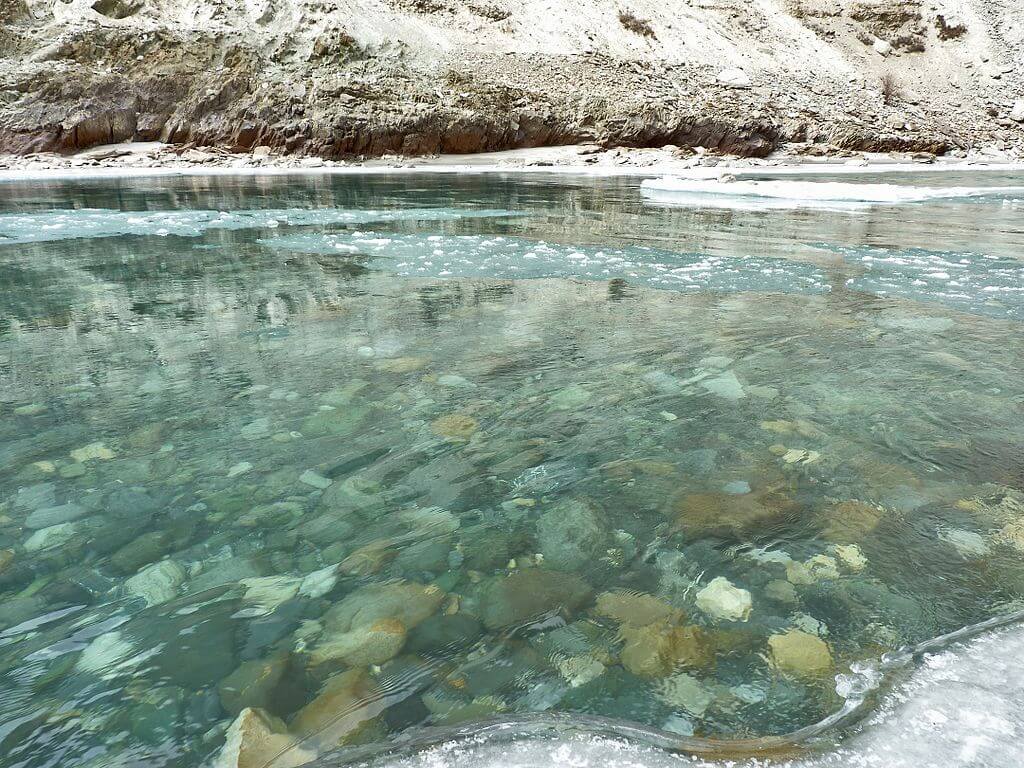
Where is Chadar Trek?
During the winter season, the Zanskar River freezes, giving trekkers a perfect solid platform for trekking. So just imagine, the trail to the Zanskar valley is going to be a challenging yet thrilling experience for the trekkers as the frozen vertical cliffs are 600 m high, and the Zanskar river is about 5 m wide.
Best Time to Visit Chadar Trek
The ideal time to visit the Frozen River Chadar Trek is between mid-January to February as during this time the upper layer of the Zanskar River freezes. The river looks like a sheet of ice; hence, it is referred to in the local language as ‘Chadar’ which means blanket.
Read more: Hidden Hill Stations In India
The winter in Ladakh region is frigid with nature. From January to February the days are relatively warmer but there will be a chill in the air. January is the coldest month in Ladakh. Early mornings, evenings and night times are extremely cold.
Daytime temperatures in Leh, and on the trek, will be between –25°C to 6°C and night-time temperatures can drop to -25°C to – 35°C. There is heavy snowfall in January and February and everything around is covered in pristine white snow.
Chadar Trek Highlights
- Trek along the conventional winter trading route connecting Padum to Ladakh along the frozen Zanskar River.
- This is an arduous adventure with only a couple of groups making the trek every year. The conditions on the river can vary so a flexible approach is required!
- Gain insight into the local culture of Zanskar and you will get a unique opportunity to homestay in the beautiful Zanskari villages along the way.
- Go for a sightseeing tour to explore the architecturally rich Gompas and forts around Leh as you
- let yourself acclimatise to the altitude.
How to Reach Chadar Trek?
Leh Kushok Bakula Rimpochee Airport is the main airport in Leh City. There are quite a number of flights like Air India and Go Air that connect Leh with Delhi and with a few other major cities in India. You can opt for air travel and have a very unique and thrilling experience of flying over the mountains.
Leh is inaccessible via roadways and railways during this time period(winter season).
Read more: Sham Valley Trek Ladakh
Places To Visit Near Chadar Trek (Zanskar Region)
1. Zanskar Valley
An acute and mesmerizing sight, Zanskar Valley is popular for the challenging treks it offers. With the craggy landscape of the surrounding mountains, the snow-covered peaks, the smooth flow of the misty clouds, the breathlessness offered by the isolation, and the flawless glory of nature, the valley is a breathtaking sight. This valley sits in the Zanskar range of the great Himalayan Mountains.
The range, rising to an elevation of about 6000 meters, is home to several exotic flora and fauna species. On the way to the valley, you can witness captivating meadows, gleaming streams, and the Drang-Drung Glacier among other sights.
2. Pensi La Pass
Known for separating the Zanskar valley from the Suru valley, Pensi La Pass is located at 4400 meters above sea level in the Zanskar range of mountains.
Rich with exotic medicinal plants, blue-green water springs and a spectacular view of the circumscribing mountains, this region is the best campsite for trekkers who wish to refresh themselves before resuming their journey. A variety of fauna are also present here including the commonly observed marmots and brown bears .
The Pass is also bounded by glaciers on both sides, from which streams flow into the Suru and Zanskar river, creating an enchanting sight.
But it is accessible only during the months from May to September, and the region is submerged and hazardous due to heavy snowfall observed during the rest of the months.
Named after an ancient Indian Buddhist master called Padmasambhava who was known as the second Buddha, the historically rich town of Padum rests at an altitude of 3669 metres in the Zanskar range.
The most populated town of Zanskar, Padum also serves as the abode of flora and fauna species.
Once the known capital of the ancient Zanskar Kingdom, the region still holds ancient relics like intricate carvings on a large rock situated on the banks of the river Lung-nak, dating back to the 8th century.
The town also consists of two ancient Buddhist monasteries situated on the hilltop. Apart from these attractions, the breathtaking beauty of the surrounding areas from this region is too lovely to be put into words.
Also acting as a trekking base, the landscape comprises of vast grasslands, huge agricultural fields, lush green forests, beautiful streams and the ruggedness of the mountains.
4. Zanskar River
As mentioned above, the Zanskar River trek or the Chadar Trek is a winter trail and is undertaken by some of the bravest souls of the land. One of the largest tributaries of the river Indus, Zanskar River emerges from the north-facing Himalayan slopes.
Further, the Zanskar River bifurcates into the Doda tributary, which begins in close proximity to the Pensi La Pass and flows alongside the Zanskar Valley towards Padum, whereas the Kargyag river tributary forms the second branch emerging from the Shingo La and Tsarap river.
The confluence of these two tributaries forms the Lungnak river which is also called as Lingti or Tsarap river. The entire area of the Zanskar river forms a U-shaped valley owing to the surrounding glaciers.
A captivating sight by day as well as during the night, the river provides an enthralling trek, especially during the winter months at a whopping elevation of 3800 metres making it a must-visit site.
Situated between Kargil and Padum, Rangdum is an elliptically shaped plateau in the Kargil district of the Jammu and Kashmir State. Situated at an elevation of 3657 metres, the plateau lies in the Suru Valley region about 100 kilometres away from the Kargil city.
Surrounded by colourful hills on one side and dazzling white glaciers on the other, the region is an alluring place. The Drang-drung glacier can also be witnessed from this region.
A beautiful region in the north of India, Zanskar is home to such amazing places that you can explore to relish your lovely vacation.
Frozen River Chadar Trek Itinerary
Day 1: Delhi – Leh (Rest for acclimatization)
Take a flight from Delhi to Leh. I would suggest a morning flight. On arrival at Ladakh, take a taxi in order to reach the hotel. Then you can visit the local markets of Leh like the Tibetan market for clothes and the Moti market in the evening. Try to return early from the markets and take proper rest in the hotel.
Day 2: Leh – Shey – Thiksey – Hemis
So, today you will be heading on a sightseeing tour to some important monasteries in the area. You will be visiting Shey Gompa, which was once the summer capital of Ladakhi kings; Thiksey Gompa, which is said to be one of the most beautiful structures in Ladakh and the famous Hemis Monastery belonging to Drukpa Order. Then, you may stay at the guest house in Leh.
Day 3: Leh – Chilling (3200 mts/ 5 hrs drive)
Start the day with a hearty breakfast and then embark on a trip to Pishu Village, through the roads that are bestowed with the sheer charisma of nature. Overnight, stay in the guest house.
Day 4: Chilling – Zaribago (3250 mts / 5 hrs)
Try to wake up by 7 am. I know it is difficult to wake up so early when you are on vacation. Yet, to make your vacation special try to follow some tips. Then get fresh and eat a proper, light, and healthy breakfast. Also remember to carry some biscuits, fruits, water bottles, and napkins along with you.
Begin the first day of the trek to Zaribago, which will take approximately five hours to reach. Overnight, stay in Zaribago.
Day 5: Zaribago – Deepyokma (3300 mts/ 5 hrs)
Today, it is going to be a thrilling yet exciting experience as you will walk on the frozen Zanskar River till you reach Deepyokma. Overnight, stay in the Deepyokma camp.
Day 6: Deepyokma – Nyarakpulu (3400 mts/5-6 hrs)
Today you need to reach Nyarakpulu below the Nyarak village from Deepyokma by trekking for about 5-6 hours. Overnight, stay in the camp.
Day 7: Nyarakpulu – Lingshed (3800 mts/ 4 hrs)
Depart from Nyarakpulu and have an hour’s walk to reach the small village of Lingshed. Relish the local culture and pleasing atmosphere of the private houses equipped with central heating systems.
Day 8: Lingshed (3800 mts)
Get ready for a fun-filled and exciting day of the Frozen River Chadar Trek. Witness the breathtaking landscapes of Lingshed, visit the monasteries and spend time with the natives of Lingshed. Stay in a Lingshed guest house.
Day 9: Lingshed – Nyarakpulu ( 3400 mts/ 5 hrs)
Today you need to trek till Nyarakpulu. Overnight, stay in a Nyarakpulu guest house.
Day 10: Nyarakpulu – Tso Mopoaldar (3200 mts/8 hrs)
Today, get ready for a long walk of around 5 hours from Nyarakpulu to the campsite at Tso Mopoaldar.
Day 11: Tso Mopoaldar – Tilatdo
Post a nutritious breakfast and embark on a trek till Tilatdo. Overnight, stay in Tilatdo.
Day 12: Tilatdo – Chilling – Leh
Return to Chilling. Drive ahead and reach Leh. Overnight, stay at a hotel in Leh.
Day 13: Leh – Delhi
Now your trip is still not got over. You still have to reach your home. So, reach the airport in time to catch the flight to Delhi and also, for those who have come by road, I wish you a safe journey ahead. Do not forget to capture some photos,and shoot videos while driving through the hills, forests, and then the plains.
I know you must be feeling quite tired and also sad at the same time because your trip has now come to an end. But I hope you enjoyed your trip to Frozen River Chadar Trek. Till then, keep on trying new trekking activities. We will meet soon with a new trek!
Frequently Asked Questions About Chadar Trek
When should i book for chadar trek.
You should book this trek two to three months in advance so that you get an ample amount of time to prepare for the trek.
What is the Minimum Age Required for Chadar Trek?
The Chadar trek is a moderate trek with a maximum altitude of 3850 mts/12628 ft, so the minimum age required is 15 years.
What kind of shoes will be Required for Chadar Trek?
Trekking shoes with good ankle support are a must for any trek in the Himalayas. Quechua Forlclaz 500, Hi-Tec Colman, and Salomon are some of the ideal shoes with value for money.
Is it Safe to Drink Water From Streams?
Himalayan stream water is safe to drink as well as for cooking but it is better if you can carry a few chlorine tablets for disinfecting water.
Which Vehicles are Used for Transportation Purposes?
Most of the Himalayan roads towards the trek are rugged, so a vehicle with good ground clearance like Mahindra Bolero, Scorpio, Safari Dicor, Tata Sumo, etc are used for transportation purposes
Is Chadar Trek for Beginners?
What i believe is that yes, chadar treks are for beginners but if they follow your guide instructions properly so there is no harm and the rest of thing is dependent upon yourself.
- Share This Post:
Related Articles
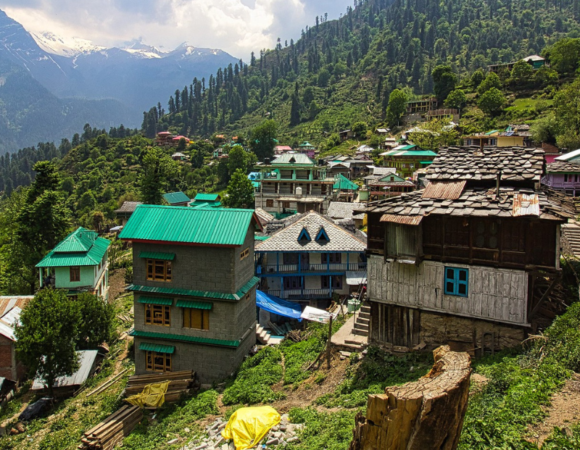
10 Best Hill Station In Himachal Pradesh, Highlights, FAQ’s
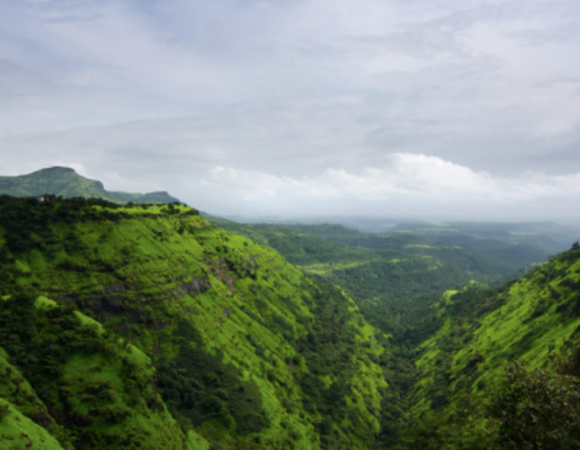
10 Best Hill Stations In Maharashtra, Highlights & FAQ’s
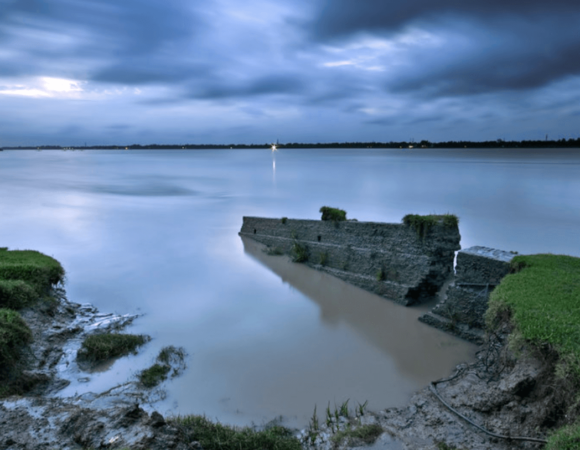
10 Best Hill Stations In West Bengal – Best Time, How to Reach Highlights & FAQs
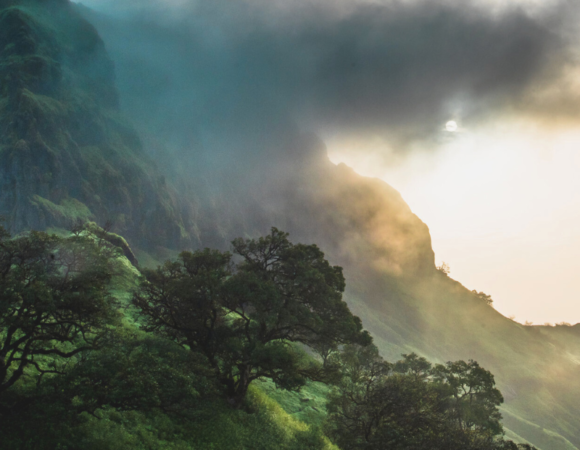
10 Best Maharashtra Trekking Places, Highlights, Treks & FAQ’s
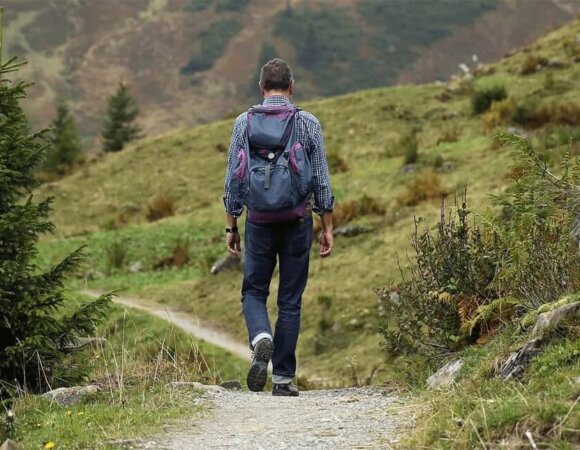
10 Best Trekking Places Near Delhi In 2024 & FAQ’s

10 Best Treks in Himachal That You Can Do in Winters
Add a comment cancel reply.
Save my name, email, and website in this browser for the next time I comment.
Things To Carry On Your Trek
Book your experience with us.
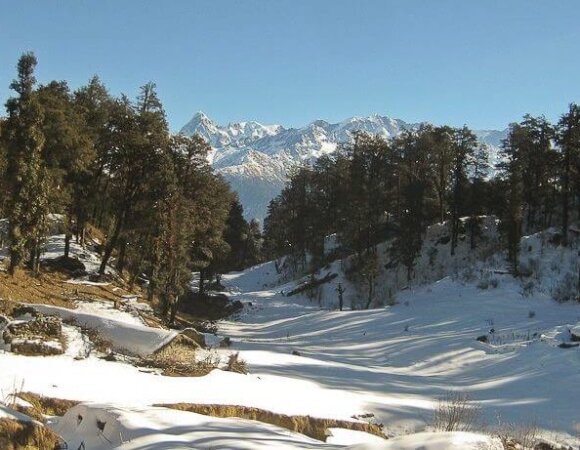
- Amenities 5
Dayara Bugyal Trek
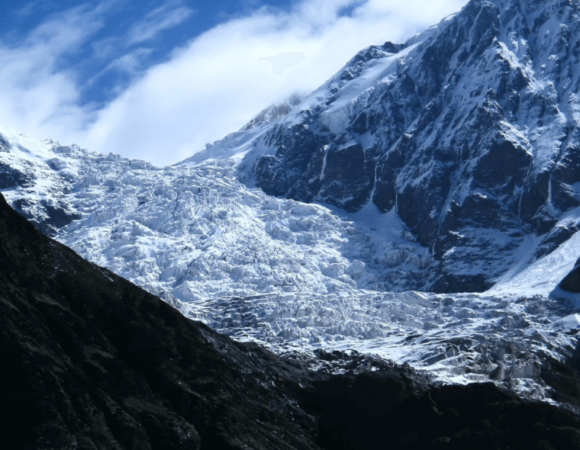
Pindari Glacier Trek
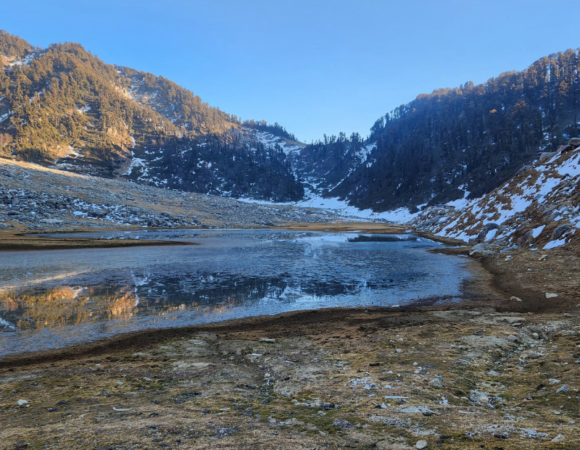
Kareri Lake Trek
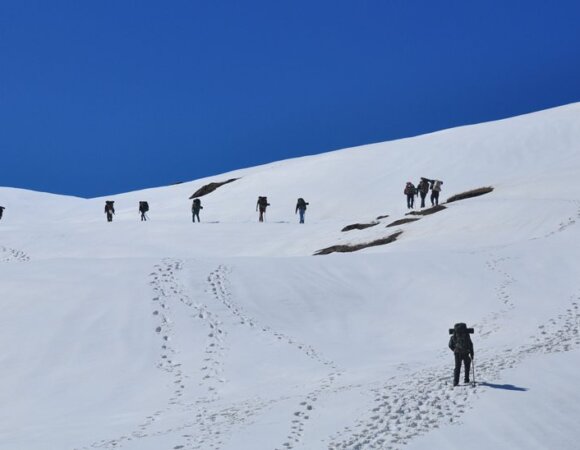
Panwali Kantha Trek
Book your unforgettable experience with us, reset password.
WhatsApp Us
- More Networks
You will be redirected to your dashboard shortly. We will also call you back in 24 hrs .
- Chadar Trek: A Complete Guide For The Adventure Junkies To Conquer In 2024!
10 Nov 2021
Only if the title tells you enough of what we are talking about, we will not brag about it. But in case you are proud of that inkling that you have about the Zanskar Chadar Trek in Ladakh, let us assure you that this is something that will arm you with bragging rights for life.
Towering mountains lending cliffs to block the bleak ways, a sheet of snow comfortably taming a wild river underneath, and blood chilling temperature in the realm around–all of this is in one 75 km long trek . If you think no level of adventure can redefine your life, this trek will change all of that.
Chadar Trek: The Inspiration
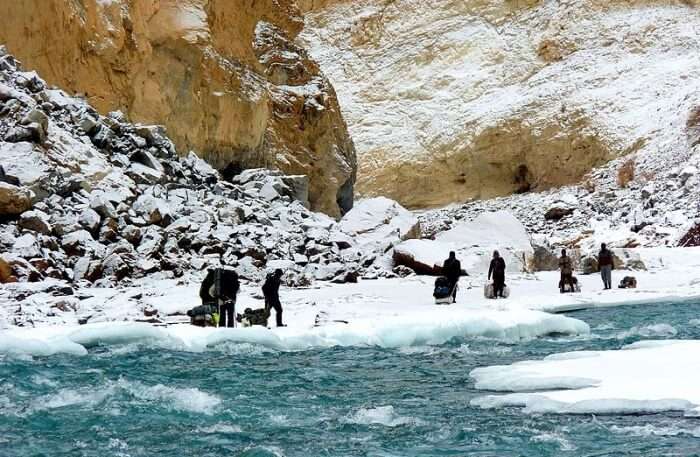
Image Source
Chadar means sheet – the thick sheet of ice that enslaves the ever-feral Zanskar river. Come winters and the civilisation living beyond the canyons and ravines of the valley gets clogged with snow. And it is then that the ice on this river allows the inhabitants of this remote valley to reach out to the world in case of emergencies.
One might tag trekking as a recent fad, but Chadar is different. It is the closest you can get to walking on a glacier . The difficulty level, the thrill-o-meter, and the experience top all the treks you can imagine. The mere idea of a successful expedition on these snow boulders is unparalleled. It’s not a trek, it’s a rejuvenation of a different kind. And to be a part of it, one needs utter caution and preparation.
Must Read: 41 Perfect Destinations To Spend Your Summer Holidays In India
Best Time To Go For Chadar Trek

January and February ; it is in the middle of January till late February that one can catch the raw thrill of walking on a frozen river. The trek usually takes 9-10 days, and one has to cover a minimum of 16-18 km per day.
Weather Details
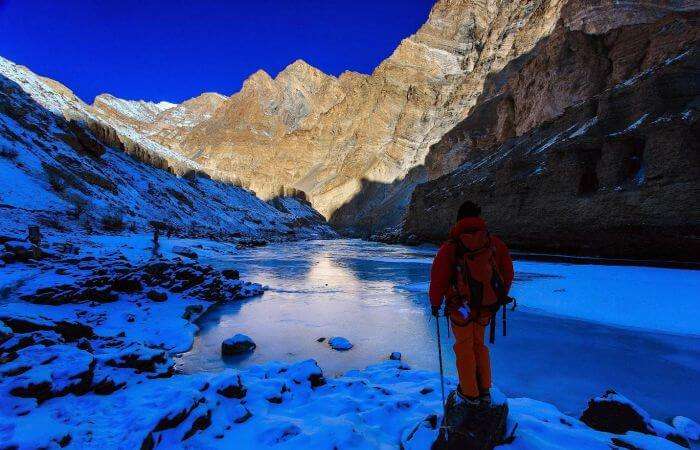
The temperature in Leh during the daytime happens to be in between -10 to 0 degree celsius which depends on the weather condition. The temperature starts to drop after the sunset and the temperature goes down till -25 degrees celsius. A feather jacket is a must item to have not just during the trek but also around the Leh Town along with warm gloves and warm hat. In case of visiting the monastery, it is very important to take off the shoes and having a thick pair of warm socks is necessary. For extreme weather conditions, one must have a proper trekking gear which can protect from the cold winds and unexpected snowfall.
Suggested Read: Bhrigu Lake Trek: A Handy Guide For Adventure Junkies
Looking To Book A Holiday Package?

Spellbinding Cochin Family Tour 2D/1N Package @ Rs 2,750
Plan your trip today!

Himachal Family Tour Package 4D/3N @ Rs 8,750
Get quotes from multiple travel experts.

Exciting Andaman Family Trip 5D/4N @ Rs 10,250
Compare & customize quotes before booking.

Gangtok & Darjeeling Tour Package 5D/4N @ Rs 13,000
Have Questions? Talk to our travel experts today.

Wonderful Goa Family Package 3D/2N @ Rs 6,500
Best prices guaranteed.

Riveting Rajasthan Vacation 3D/2N Package @ Rs 6,499
EMI option available.

Enchanting Uttarakhand Tour 4D/3N Package @ Rs 7,199
Explore best destinations with our experts.

Delightful South Weekend Tour 3D/2N Package @ Rs 4,999
Thrilling weekend full of fun.

Marvelous Gujarat Tour 3D/2N Package @ Rs 4,999
Talk to our experts today.

See more at TRAVELTRIANGLE.COM
Detailed Itinerary Of Chadar Trek
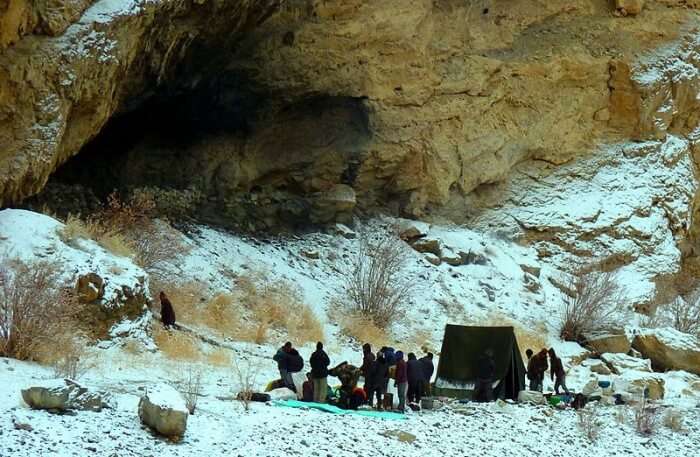
Day 1 – Arrival At Leh
As you will arrive at Leh, from there you will be transferred to the designated hotel. The first day will be spent in the room, to acclimatize in the high altitude. This is very important for the days coming ahead. Spend the night at the hotel.
Day 2 – Acclimatisation Day
On the next day, one can go for their own sightseeing and explore the local highlights of Leh or otherwise relax at the hotel. Spend overnight at the hotel.
Day 3 – Medical Check Up
Today you will be taken to the local hospital located in Leh for a health check-up. This is a mandatory process by the government to get a medical certificate before going for the Chadar trek. Adding to this one has to get a clearance certificate post the medical check up which will be issued by the hospital. This certificate will only be issued after the participant is believed to be fit and acclimatised for the trek. An overnight stay at the hotel.
Day 4 – Leh – Shingrayokma – Tsomopaldar
After having breakfast, one will take a drive to the beautiful valleys and get a glimpse of the Indus and Zanskar river which meets at the confluence of Nimoo. From Nimoo, one can start the journey toward the road heading to ShingraYokma. At this point you will deboard and then start the trek towards TsomoPaldar campsite. Spend the night at the tents.
Day 5 – Tsomo Paldar – Dibb Cave
Today you will start the trek towards the Dibb cave. Walking past the deep gorges located at the Zanskar valley, one will get to witness the sheer cliffs on both sides and untouched snow. By the end of the day, one will reach the cave which is a traversing spot for the locals. The camp will be set up here for spending the night.
Day 6 – Dibb Cave – Nyerak
After having breakfast, you will head towards the Nyerak village after crossing the beautiful gorges. In the route, you will be passing through the large frozen waterfall which is a stop point for rafting trips which happens during Aug-Sep. The camp for today will be set up at the Nyerak village and in the evening you can go explore the village. Overnight stay in the tents.
Day 7 – Nyerak – Hotang
Starting from Nyerak, today you will be heading towards Hotang following the same route. At the end of the day, enjoy an overnight stay at the tents.
Day 8 – Hotang – Shingra Yokma
Today will be the last day of the trek where you will be heading towards Shingra Yokma after having breakfast. Walking over the thick ice, the trek will take 9 hours which also includes a break for a few minutes. As the trek gets over, you will be driven back to leh and spend the night at the hotel.
Day 9 – Departure From Leh
On the last day of the entire journey, you will be transferred to the airport and from there you can start the journey towards the onward destination.
Suggested Read: Guide To Dzongri Trek In Sikkim – A Glimpse Into The Heaven
Trek To Zanskar: That Walk to Remember
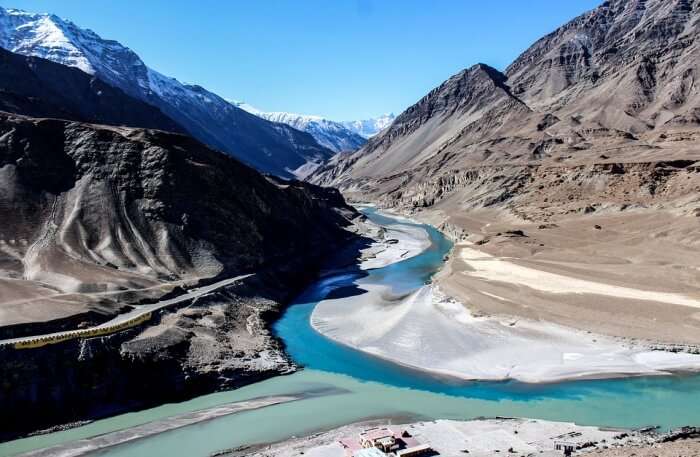
One of the most enigmatic adventures on earth, this trek is an enthralling expedition that goes through some of the most breathtaking panoramas on earth.
1. Tilat Sumdo is the campsite for the trek . It is the confluence of Zanskar and a small stream. The trek starts from here. 2. Next comes Shingra Koma, which is almost 10 km from Sumdo . 3. After Koma, on the 2nd day, comes one of the most beautiful spots of the Chadar trek — Tibb . Tibb is full of caves and waterfalls. The caves are used for night stays and waterfalls are used for framing some of the most scenic vistas of Himalayas in Zanskar valley. 4. Nerak follows Tibb on the 3rd day and next comes another campsite called Gyalpo on the 4th day . At a bend in the river, is this beautiful place full of wall of rocks resembling human faces. Surreal is the word to explain the sights here.
5. The trek further goes through Dibyok ma on 5th and 6th day and ends at Ling shed by the 8/9th day . Ling shed is one of the oldest villages in Ladakh. The village also has one of the oldest monasteries in world. It is one of the most naturesque sights on the trek. The locals have opened their homes to the tourists.
Suggested Read: Hampta Pass Trek: A Testing 4-Day Expedition Near Manali
How To Reach The Starting Point

The only way to reach Zanskar is through the air. The nearest airport is Leh and all flights land before noon . Be prepared to come out of your aircraft as the bone-chilling temperature awaits you on the vast expanse of white snow.
From here you head to Chilling (64 km) by road and then trek for about 2 hours to Tilat Sumdo , the starting point.
Suggested Read: 25 Road Trips In India For Couples That Will Reshape Their Future Together
The Preparation: Tips From A Beginner
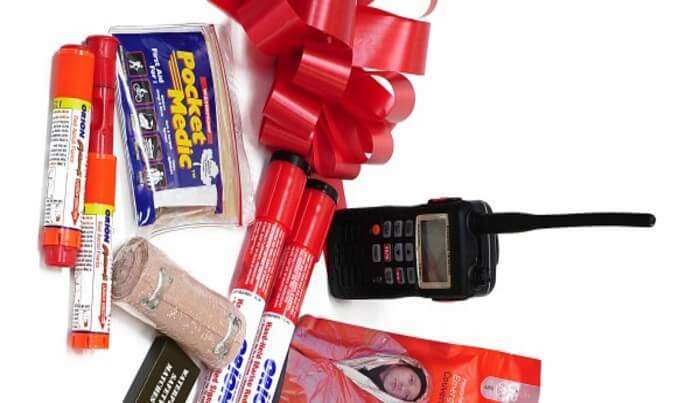
1,300 ft above sea level, a bone-chilling quaint surrounding, and a violent river ready to break the ground anytime it wants–all of this for a distance of almost 75 km to Zanskar valley. We are certain you are not planning on walking in your sandals with a stick in one hand and a portable speaker in other.
It truly does need all the preparation in the world of trekking and one must start preparing with at-least month in hand. Hence here are a few suggestions from an average trekker:
1. Acclimatize And Build Stamina
If you have never been on a trek that needed acclimatization, we suggest you take it more seriously this time. For the January trek, we suggest you spend at least 2-3 days in north India’s winter. By the time you are camping and hiking with proper gears on in subzero (-8 to -5 degree celsius on average) conditions, you will feel that cold is just a state of mind.
Physical fitness is important. Start working out and build some stamina before you head for Chadar. After all you are going to scale some of the rarest heights.
Suggested Read: 15 Best Trekking Places Near Bangalore For Thrill Seekers To Visit
2. Things To Carry

Take all the accessories that you need. Buy gumboots as the normal hiking shoes aren’t enough. They prevent the feet from frostbite, don’t get wet easily, and cost INR 400. Extra pair of socks , waterproof gloves , body warmers , flask bottles , exothermic pouches , trekking rods , couple of sleeping bags are some of the most basic things.
Suggested Read: 35 Places To Visit In March In India For A Calming Vacation
Planning your holiday but confused about where to go? These travel stories help you find your best trip ever!

Nikhil Recites A Tale Of 11 Friends Who Went From Bengaluru To Ladakh
Bengaluru - Delhi - Leh - Ladakh - Leh - Delhi - Amristsar - Chandigarh - Bengaluru

Pranav Took A Solo Trip To Andaman & It Was Truly Wonderful
A backpacker's guide to the predominant Honeymoon destination!

Shivani Talks Of Her Trip To Mcleodganj & Dalhousie With Her Husband And Friends
Sunset views. Monasteries. Bhagsunath falls. And amazing street food.

Kanika Proves That Traveling With An Infant To Kerala Is Totally Safe & Wonderful
Beaches, Backwaters, Spas, & More. Take me there now, please!

Here's Why Aakanksha's Trip To Manali Changed Her Idea About Group Tours
Ideal long weekend getaway from Delhi! Isn't it?

Isha Elaborates On How She Went Solo To Kasol & Returned With Lots Of Friends
And tales of her exciting Kheerganga & Chalal trek...

Prasham's Account Of A Goa Tour Proves That Goa Is More Than A Party Destination
Adventure, sightseeing, laid-back beach tours, and it doesn't stop there!

Bhavya Gives An Extensive Account Of His Jaisalmer Trip With Friends
Desert safari, haunted Kuldhara village, & Gadisar Lake. There's more...

Ashish Tells Why Kashmir Turned Out To Be A Winter Wonderland For His Family
For Gondolas, Shikaras, and plenty of snow!
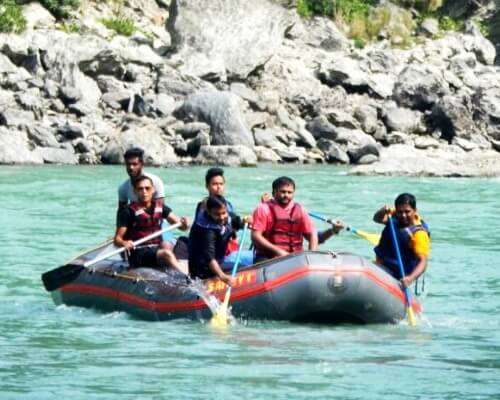
Arunav Can't Stop Praising His Adventurous Trip To Sikkim & Darjeeling With Friends
For adventure in Air, on Land, and in Water!

Avneet Describes Her Trip To Spiti With A Group Of Strangers That Became Friends
Sightseeing. Monasteries. Trekking. And beauty all along
The Extraordinary Stay
But wait, what about lodging and food? Fret not, all trek organizers take care of camping and food. Another popular lodging option enroute Zanskar Valley is cave camping . In some of the most picturesque nights, right in the middle of nowhere, dining and living in caves is certainly an extraordinary experience. But thrills apart, there are a several homestays —simple and warm—on the way to Chadar Trek.
So, before you embark on something as mesmerising, mysterious and magical, here are a few bullets you must keep in mind.
Suggested Read: 31 Ideal Places To Visit In India In May For An Amazing Summer Vacay
Do’s And Don’ts For Chadar Trek
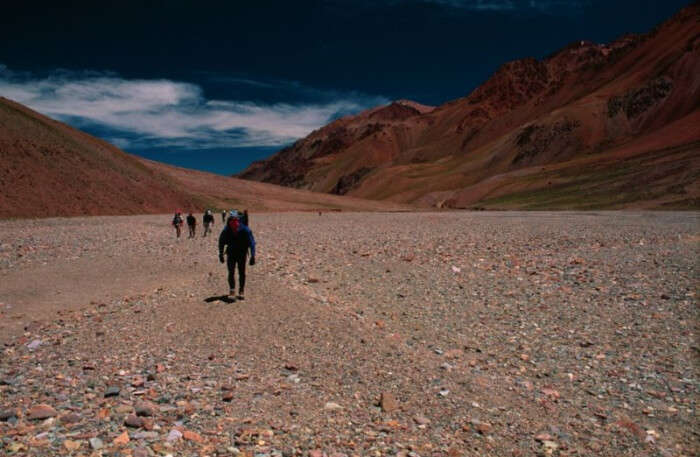
- Maintain that adrenaline rush for a good period of time. Don’t lose heart if something does not work out.
- Follow the locals like a shadow. They know the best of the trek. Do not do anything that the locals are not doing.
- Make peace with falling and failing . You will slip on the ice and you will have to get up – this will be the case for the first couple of days.
- Carry sufficient eatables and edible water , food may fall short.
- Keep a first aid kit handy . Bring your meds as the cuts and bruises are a welcome greeting here.
- Do not undermine the weather reports. Keep sync with MET records .
- Skipping a meal is the last thing you would want to do. The trek is demanding and it would need you to be on you toes even when you are sleeping.
- Do not neglect the Guide . Follow him/her religiously.
- Do not litter , do not use soap in waterfall for the obvious reasons.
- Do not over stress . Take a break when you feel it is required.
Suggested Read: 18 Honeymoon Destinations Outside India In March For A Romantic Escape
The Experience
Chadar trek packages start from INR 18,500 . Most of these are group treks, where the package excludes air fare, airport pickup and drop, personal expenses, and luggage carriage charges. However, these specially designed packages do, normally, include the service taxes, professional trekking kits and guide, and meals on trek (only veg). Some of the popular Chadar Trek organizers are Chadar Trek ; Road Trek Ventures ; Adventure Nation ; and We Nomads .
Further Read: Kheer Ganga Trek: Whispers From The Parvati Valley!
Does this guide give a push to your adrenaline rush? Chadar trek is considered to be one of the most adventurous trails to explore and enjoy a great time. Amidt the snowy paths, it is just like a magical walk. So if you’re planning a vacation in Ladakh , then make sure to indulge into this adventurous journey to experience the best time of your life!
Disclaimer: TravelTriangle claims no credit for images featured on our blog site unless otherwise noted. All visual content is copyrighted to its respectful owners. We try to link back to original sources whenever possible. If you own rights to any of the images, and do not wish them to appear on TravelTriangle, please contact us and they will be promptly removed. We believe in providing proper attribution to the original author, artist or photographer.
Looking To Book An International Holiday?

Trip to Sri Lanka at Rs 13,500/-
Plan Your Vacation Today!

Trip to Singapore at Rs 20,499/-
Get Quotes From Local Experts

Mauritius Holiday Starting at Rs 65,000/-
Talk to Our Experts Today

Maldives Honeymoon Trip at Rs 39,800/-
Pay with easy EMI Option

Europe Trip at Rs 89,999/-
All Inclusive Deals

Vacation in Dubai at Rs 27,499/-

Hong Kong Holiday at Rs 24,999/-
Money Safe Guarantee

Thailand Holiday at Rs 7,999/-
Flights Excluded
People Also Read
Zanskar Valley Trek Mullayanagiri Trek Spiti Valley Trek
Recent Posts
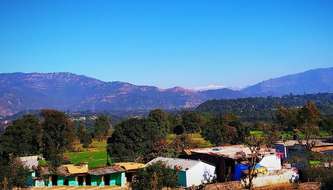
7 Places To Visit In Udhampur For A Memorable Vacation In 2023
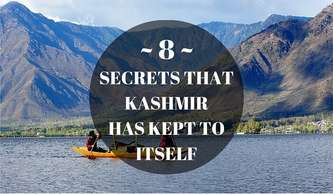
8 Lesser Known Secrets Of Kashmir That It Has Kept To Itself

Stay At These 8 Cottages In Kashmir In 2023 That Are Just As Heavenly As This Destination
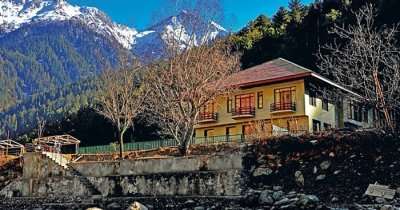
10 Breathtaking Hotels In Sonmarg For A Divine Holiday
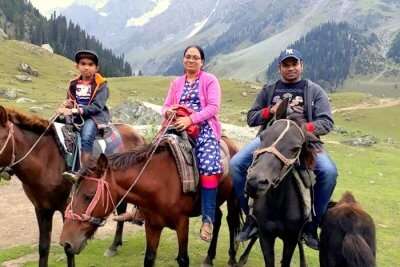
Celebrating Precious Moments On A Family Holiday In Kashmir

Ankit’s 5 Days In Kashmir With His Loving Wife Were Truly Splendid
Trending Blogs

20 Mysterious Places In India To Visit In 2023 More Bizarre Than The Bermuda Triangle

10 Scariest Roads In India That Are A Driver’s Nightmare

101 Places To Visit In India Before You Turn 30 in 2024

35 Exotic Places To Visit In December In India 2024 To Enjoy A Surreal Vacation

60 Best Honeymoon Destinations In India In 2024

95 Best Honeymoon Destinations In The World In 2023 For A Romantic Escape!
Best Places To Visit In India By Month
Best places to visit outside india by month.
- TravelTriangle
- Kashmir »
- Tour Packages
- Honeymoon Packages
- Family Packages
- Budget Tour Packages
- Luxury Tour Packages
- Adventure Tour Packages
- Group Tour Packages
- Kerala Tour Packages
- Goa Tour Packages
- Andaman Tour Packages
- Sikkim Tour Packages
- Himachal Tour Packages
- Uttarakhand Tour Packages
- Rajasthan Tour Packages
- Tour Packages From Delhi
- Tour Packages From Mumbai
- Tour Packages From Bangalore
- Tour Packages From Chennai
- Tour Packages From Kolkata
- Tour Packages From Hyderabad
- Tour Packages From Ahmedabad
- Kerala Tourism
- Goa Tourism
- Sikkim Tourism
- Andaman Tourism
- Himachal Tourism
- Uttarakhand Tourism
- Rajasthan Tourism
- Hotels in Kerala
- Hotels in Goa
- Hotels in Sikkim
- Hotels in Andaman
- Hotels in Himachal
- Hotels in Uttarakhand
- Hotels in Rajasthan

Chadar Trek
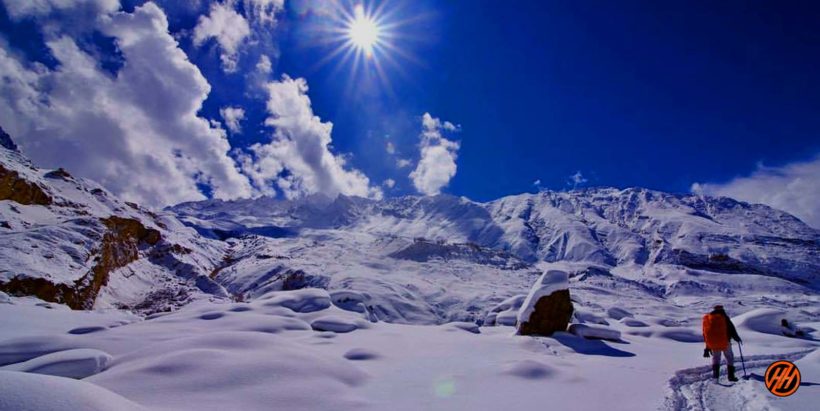
Description
Reviews (2), things to take, available dates, include / exclude, chadar trek in leh – over the zanskar river range of ladakh-2024- complete information, itinerary, costs date.
Your trek journey started with Himalayan Hikers , beautiful mountain town of Leh, all our trekker reach Leh by flight this is best option to you reach to Leh, altitude is 11400 feet above sea level, the trek beautiful Zanskar River which liws totally frozen during the December to Feb, Peak Winters Trek , So, probably the best time to do Chadar Trek is February because the ice remains harsh and stable. Trek starts from the freezing point of Zanskar River and that is Chilling.
Therefore, the “Chadar trek” is also known as “The Frozen River Trek”. This Trek is over a frozen river in the Zanskar region of Ladakh and it is different from all other treks in the Himalayas.
The snow appears as a thick sheet of snow, therefore, it is called “Chadar trek” and it is one of the trickiest treks in the world which is done in peak winter months. On this trek explore the Zankari culture and get to know about it in close proximity and the main highlight of this Frozen River Trek is a completely frozen waterfall “Nerak”.
The Chadar Trek is a popular winter trek in the Zanskar region of Ladakh, India. Here are some highlights of the trek:
- Trekking on the frozen Zanskar River: The highlight of the Chadar Trek is the experience of walking on the frozen Zanskar River, which transforms into a thick sheet of ice during the winter months.
- Breathtaking views: The trek offers breathtaking views of the frozen landscape, towering mountains, and the gushing river beneath the ice.
- Cultural experience: The trek also offers a unique cultural experience, as trekkers get to interact with the local Zanskaris and witness their way of life in the harsh winter conditions.
- Adventure: The Chadar Trek is a challenging trek that requires physical endurance and mental toughness. Trekking on the slippery ice, crossing icy-cold streams, and camping in freezing temperatures make it an adventure of a lifetime.
- Photography opportunities: The trek offers numerous opportunities for photography enthusiasts to capture stunning landscapes and unique cultural experiences.
Overall, the Chadar Trek is a must-do trek for adventure and nature lovers who are up for a challenging winter trekking experience.
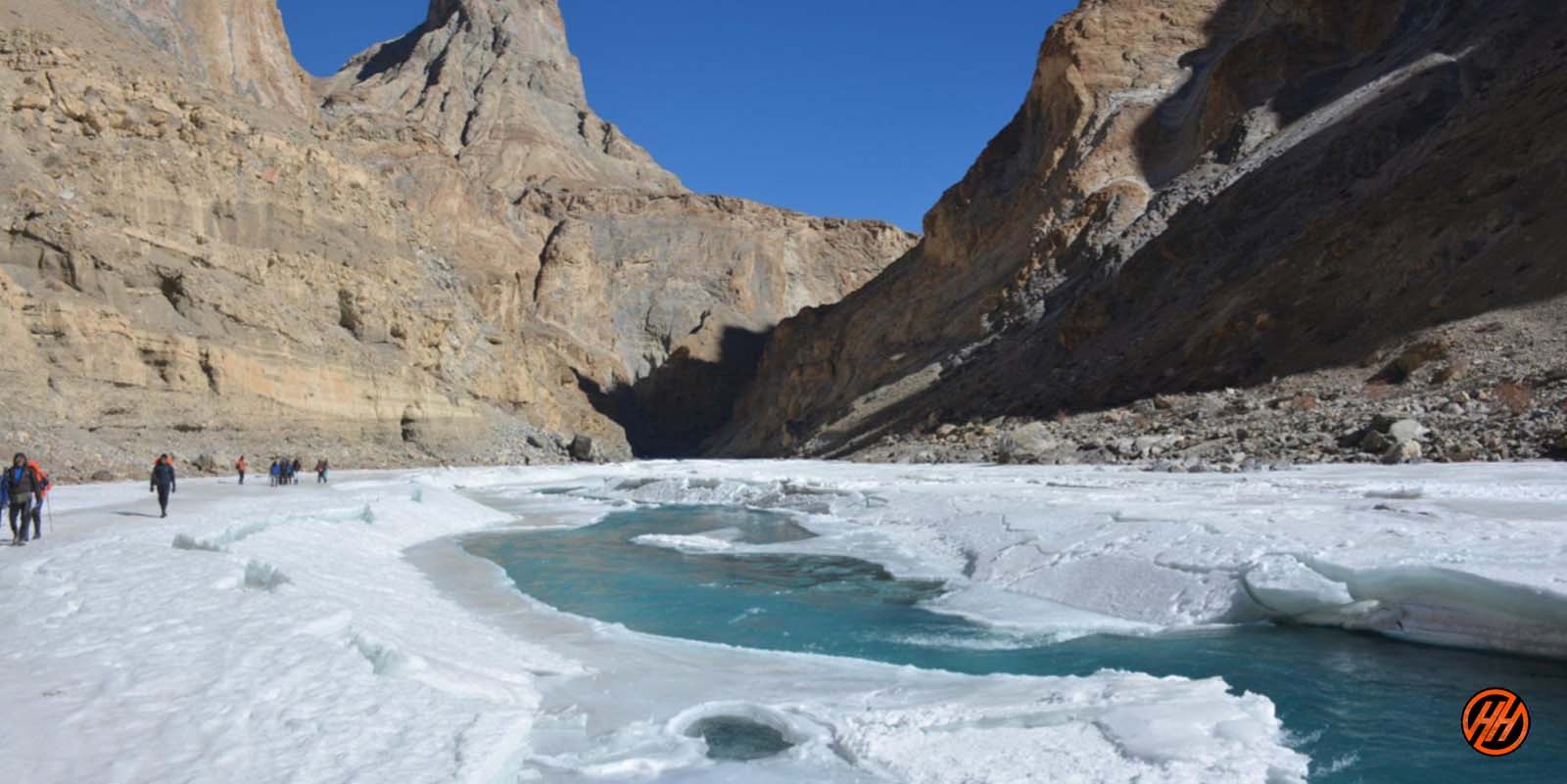
Ice Covering and Freezing Cold in Chadar Trek
The Chadar trek is over a frozen river and the ice can turn dangerous sometimes but can also be safe the other times. But, it is important to find a safe path over the perilous sheet of ice.
During the trek, you do not camp here at the meadows or the forest clearings but inside the caves which are present along the banks or you set up the tents at stable ice.
Here, the temperature remains chilly and freezing (-20) and falls down at night, so keep warm layers to protect the body against chilly cold and prevent the freezing of blood.
Best Time to Visit Chadar Trek
The best time to do the Chadar Trek is during the winter months, from January to February, when the Zanskar River freezes and forms a thick sheet of ice that is suitable for trekking. During this time, the weather is cold and dry, with clear blue skies and minimal precipitation.
It is important to note that the timing of the trek also depends on the weather conditions and the formation of the ice sheet. It is essential to have experienced guides and a reliable trekking organization to provide up-to-date information on the ice conditions and weather forecast.
Additionally, it is recommended to plan the trek in advance and book with a reputable trekking organization like Himalayan Hikers Trekking Organization to ensure availability and to have the necessary permits and logistics in place.
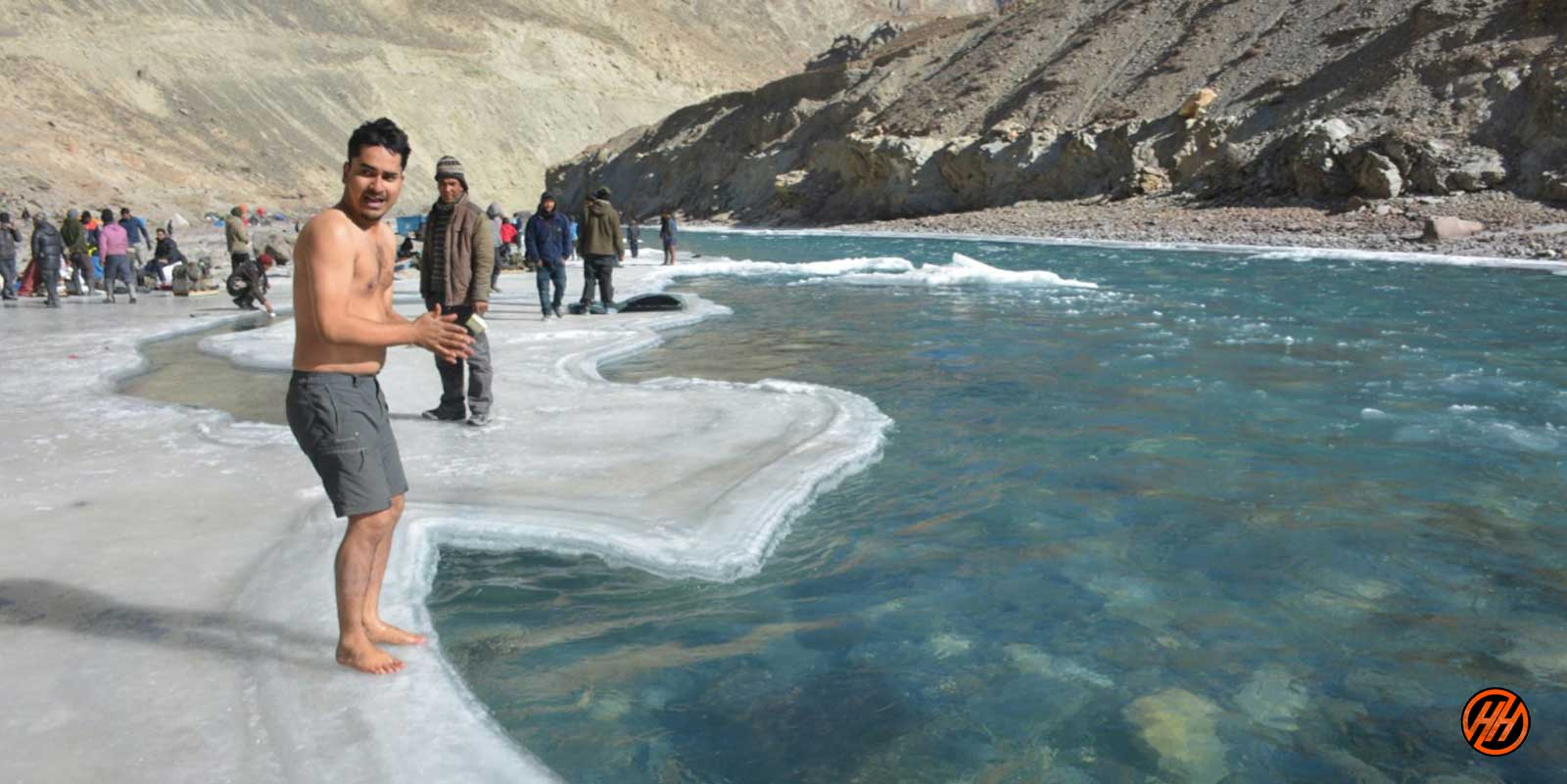
Be Aware During Chadar Trek (Not for Beginners)
You need to be very aware of the stability of ice and conditions below the feet for a safe trek. Sometimes the ice isn’t stable and the choices go wrong so walk carefully if suddenly a crack appears to go fast to the place where the ice is
So, choose a camping spot wisely after properly analyzing the area.
Here are some tips to do Chadar Trek –
Analyze the ice sheet conditions.
Avoid the cracks in the ice.
Walk carefully on the slippery areas.
Run immediately to a stable area if a sudden crack appears under your feet.
Walk on the places with a coating of snow.
Choose camping spots wisely.
Alcohol and smoking are not allowed in during the trek
Level- Difficult
During the trek, proper conditioning & training of body required
Need proper gear & clothing for sub-zero temperature
Shoes are the single most important equipment.
High Altitude requires proper acclimatization. Of base camp Leh
Beautiful landscapes so carry good photo gear & Extra battery backup.
Travel headlight
The backpack should not exceed 12 kg.
Long Gumboots are mandatory to all trekker
About Leh – Ladakh – The Land of High Passes
Area: 98,000sq km
Altitude: 7,500m Max.
Population: 250,000
Religion: Buddhism, Islam. Hindu
Geographical Status: Cold Desert
Across the Kashmir Valley and over the famous Zoji La pass lies Ladakh, the Land of High Passes. It is a magical land, so completely different from the green landscape of some other parts of the Himalayas. It is nature at its extreme. A land of freezing winds and blazing sunlight, Ladakh is a cold desert lying in the rainshadow of the Great Himalayas and other smaller ranges. Little rain and snow reaches this dry area, where the natural forces have created a fantastic landscape.
Ladakh forms part of the state of Jammu and Kashmir in India. Parts of Ladakh are under the illegal occupation of Pakistan and China. The border of Ladakh touches those of Afghanistan, Pakistan, China, the Kashmir Valley (India) and Himachal Pradesh (India). This region is made up of two administrative districts — Leh District, with its headquarters at Leh, and Kargil District, with its headquarters at Kargil –and covers a total area of about 59,000 square kilometers.
Ladakh is at an average elevation of 2,700 m to 4,200 m. The aridity of this region is due to its location in the rainshadow area of the Great Himalayas, elevation and radiation of heat from the bare soil. The most striking physical feature of Ladakh, however, is the parallelism of its mountain ranges. The region is extremely dry, with an annual rainfall as low as 10cubic centimeter.
In Ladakh, large rivers and their tributaries have carved deep gorges far below their steep banks. However, their water is not of much use as the terraced fields lie high above the gorges.
Until the advent of the aircraft, Ladakh could only be reached over dangerous, high passes. The Zoji La pass connecting Ladakh to Kashmir is at 14,000 ft and is the lowest approach from the west. The southeast approach has to cross the 18,200 ft high Tanglang La. And to the north lie the Saser La and Karakoram passes, gateways to Central Asia from where trading caravans used to come for many centuries.
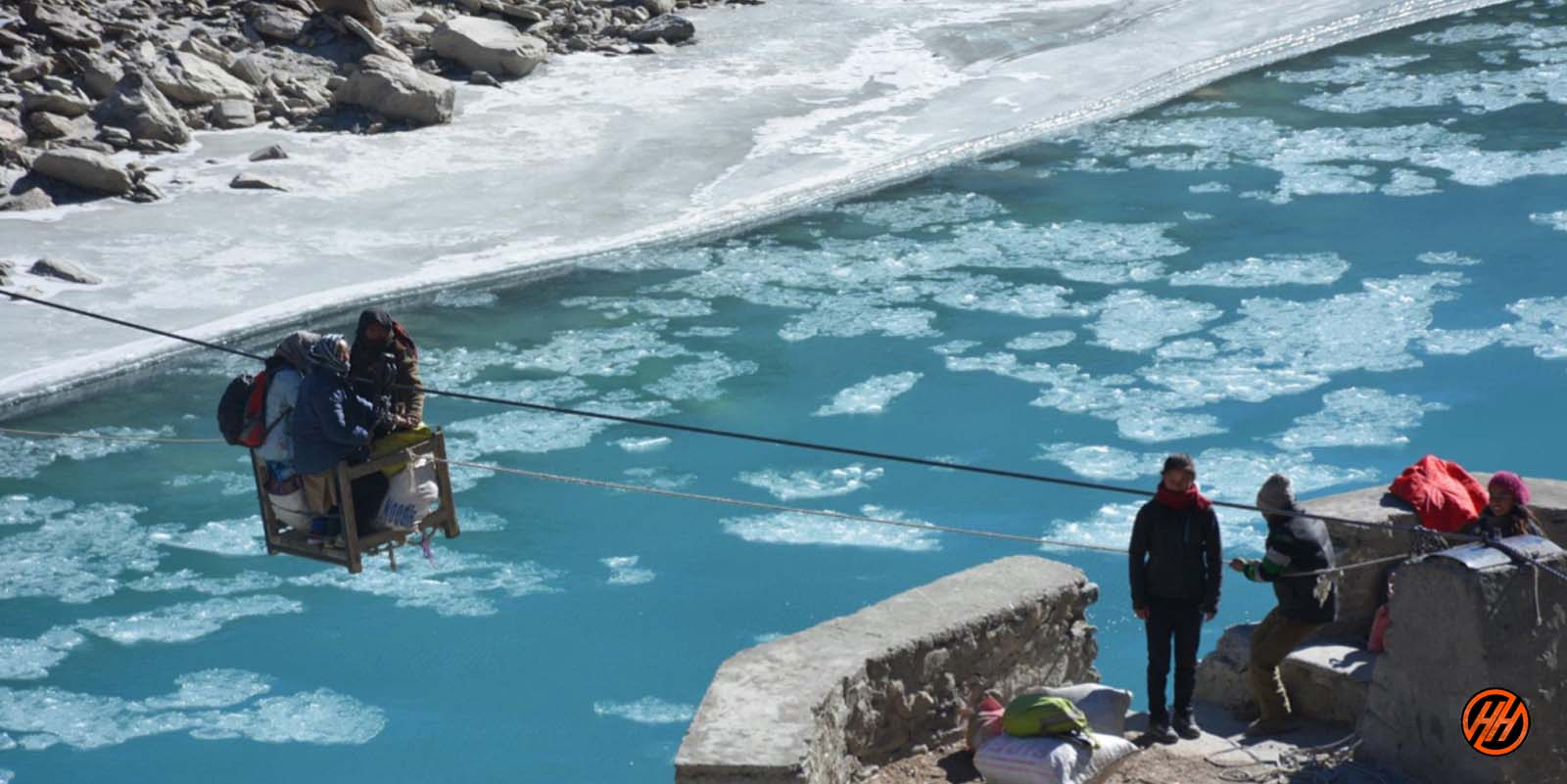
Altitude we are going to cover in Chadar Trek
Leh – 3500 Meters
Tsomo Paldar camp – 3200 Meters
Tibb Cave camp – 3300 Meters
Nerak camp – 3400 meters
The temperatures during the Chadar Trek
The temperatures during the Chadar Trek can be quite cold, as it takes place during the winter months when the region is covered in snow and ice. The average temperatures during the trek range from -10°C to -20°C (14°F to -4°F) during the day, and can drop to as low as -30°C (-22°F) at night. However, it is important to note that temperatures can vary depending on the weather conditions, altitude, and time of day.
It is crucial to have proper clothing and gear to stay warm during the trek, including warm base layers, a down jacket, insulated pants, waterproof gloves, and a warm hat. Additionally, it is important to stay hydrated and eat nutritious food to maintain energy levels and stay warm. Experienced trekking organizations like Himalayan Hikers Trekking Organization provide detailed information on what to wear and pack for the Chadar Trek to ensure a safe and comfortable trekking experience.
ATM Point & Mobile connectivity in Chadar Trek
ATM POINT: Hi trekker ATM available is Leh Withdraw money before your journey,
Mobile Connectivity: There will be available all networks only postpaid
Key Points of Chadar Trek
Duration: – 08 Nights 09 Days from Leh to Leh
Base camp: – Leh
Winter Temperature:- Day -5°C to -15°C) Night – 12° C to -20° C
Chadar trek – Altitude: – 11400 feet
Best Time: – Jan or Feb
Trek Level: – Difficult
Trek distance: – On foot 57 Km – By taxi 140 km
Group Size: – minimum of 05 people maximum of 15 people
Temperature
The winter temp. touches as low as minus 30 degree (Leh & Kargil) and minus 60 degree in (Drass) subzero temp. prevails from December to February throughout Ladakh, whereas, zero degree temp. is experienced during rest of winter months. This results in freezing of all conceivable water resources. During summers the maximum temp. increases from 20 degree C to 38 degree C in July and August
Clothing: Light/Medium woolens in summers to Heavy woolens in winter
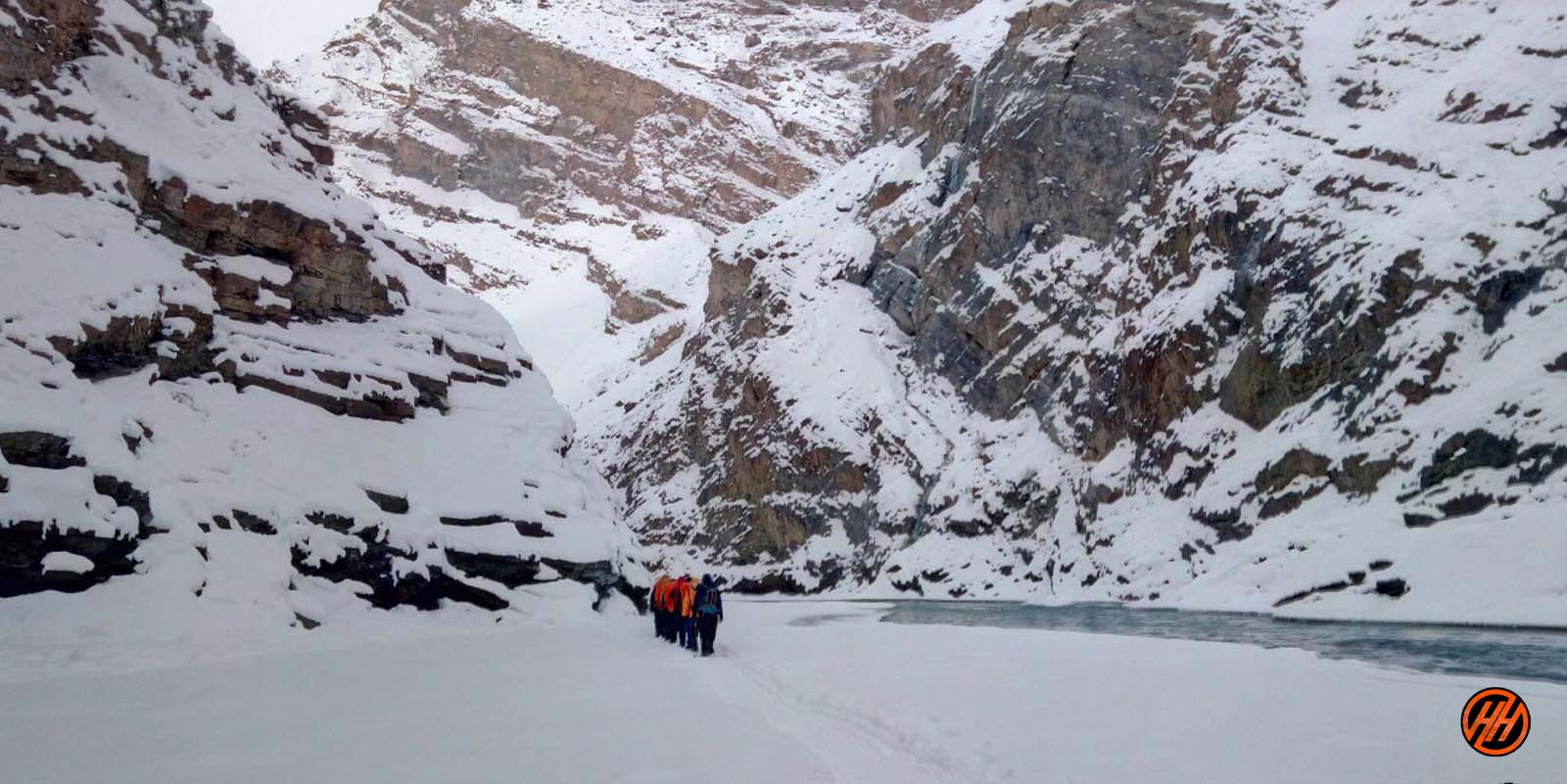
Languages Spoken
Ladakhi is the main language of Ladakh. Other languages spoken are Balti, Shina, Brokshat and Changshat. In hotels and restaurants, staffs speak English and Hindi, while tourist guides are well versed with the language.
Key Points about Chadar Trek
– Level: Difficult (so first-timers trekkers should avoid)
– Proper conditioning & training of body required
– Group size minimum of 05 maximum of 15 people
– Need proper Expedition gear & clothing for sub-zero temperatures?
– Shoes are the single most important equipment
– High Altitude requires proper acclimatization
– Phones don’t work on the trek, we are provide to you Radio Walkie Talkie for Communication
– Beautiful landscape so carry good photo gear (I couldn’t carry my best equipment)
– Travel light (my backpack was heavy at about 12 kg to 15 Kg )
– Keep an extra day in your itinerary for attempt to Chadar trek summit account for bad weather
– Alcohol and smoking is not allowed in during the Chadar Trek Expedition
Difficulty level
Because the top is relatively high in elevation, we strongly recommend a reasonable level of physical fitness. The arduous journey of Chadar trek winter hiking with longer distances and ascending elevations to be covered in a short span of time would require acclimatization. We advise trekkers to physically and mentally prepare themselves prior to this trek. Throughout the course, all groups will be guided by our experts for trekking equipment and any impending terrain.
Any medical assistance that is required will be provided at any point of the journey; however, trekkers must consult their professional care before beginning any trek. We also strongly advise trekkers to learn about altitude sickness and to notify our teams as soon as any symptoms appear.
Short Itinerary of Chadar Trek
Day 1:- Arrival at Leh – pickup to you from Airport drive to Hotel check in Rest and Acclimatization overnight stay Hotel
Day 2:- Trek Planning and Briefing – Acclimatization and Preparation- meet us our Himalayan Hikers Guide overnight stay
Day 3:- Medical Test Day in Leh
Day 4:- Drive from Leh to Bakula (70 km) (2 hours) same Day Trek Bakula to Shingra Koma 2/3 Hours overnight stay Camp
Day 5:- Trek from Shingra Koma to Tibba (16 km) (6/7 Hours) overnight stay Camp
Day 6:- Trek from Tibba to Nerak Waterfall (12 km )( 6/7 Hours) overnight stay Camp
Day 7:- Trek from Nerak to Tibba (16km ) (6/7 hours) overnight stay Camp
Day 8:- Trek from Tibba to Bakula (12 km) (6/7 hours) Same day Drive to Leh Hotel
Day 9:- After breakfast Depart from Leh
permit and passport.
Tourist don’t require permit for Leh, however, all foreigners are required to be registered at Drass, Rumtse and Serchu if they are travelling overland. Those traveling by air get themselves registered at airport. Tourists are required to get permit for restricted areas like Tsomoriri, Tsokar and Pangong Lakes, Dhahanu and Nubra Valley, which can be obtained from District Magistrate, Leh, through Travel Agents at Leh.
Avoid acute mountain sickness
Acute mountain sickness can occur to any one at an altitude above 10,000 ft. above sea level, therefore, make it sure to take complete rest on the day of arrival.
How to Reach Leh or ladakh
Overland Approach
Overland Approach – The overland approach to Ladakh from Kashmir Valley via Kargil is approx. 434 Km, which remains open for traffic from early June to November. The most dramatic part of this road journey is the ascent up the 11,500 feet / 3,505 m high Zoji-La, the pass in the Great Himalayan Wall that serves as the gateway to Ladakh. The J & K State Road Transport Corporation (J&K SRTC) operates regular Deluxe and Ordinary bus services between Srinagar and Leh on this route with an overnight halt at Kargil. Taxis (cars and jeeps) are also available at Srinagar for the journey. Groups can charter Deluxe and A-class buses for Leh, Kargil or Padum (Zangskar) from the J & K SRTC at Srinagar.
Manali to Leh – Since 1989, the 473 km. Manali-Leh road has been serving as the second overland approach to Ladakh. Open for traffic from around mid-June to early October. This high road traverses the upland desert plateau of Rupsho, altitude ranges from 3,660m to 4,570m. A number of high passes fall enroute among which the highest one known as Taklang-La is world’s second highest motorable pass at an altitude of 17,469 feet/5,235m. Himachal Pradesh Tourism, HRTC and J & K SRTC operate daily Deluxe and Ordinary bus services between Manali and Leh. The bus journey between Leh and Manali takes about 19 hours or two days with an overnight halt in camps at Serchu or Pang. Shared taxis are also available both from Leh and Manali
Road Distances
Srinagar-Leh 434 Km
Manali-Leh 473 Km
Srinagar-Kargil 204 Km
Delhi-Leh 1047 Kms
Leh-Kargil 234 Km
Kargil-Padum (Zanskar) 240 Km
Leh-Deskit (Nubra Valley)118 Kms.
Credit Cards & ATM Machine
Credit cards are accepted by very few hotels and tour operators but there will be 2.5% service charge. The Jammu and Kashmir Bank and State Bank of India has placed ATM Machine in Leh. The State Bank of India accepts visa and mastero but this ATM is not very reliable. J&K Bank ATM is more reliable but accepts only Mastero.
Indian Airlines www.indian-airlines.nic.in operates regular flights to Leh from Delhi (fare USD 135), Four flights in a week from Jammu and once in a week from Chandigarh and twice from Srinagar. Jet Airways www.jetairways.com also operates daily flights between Leh-Delhi (fare USD 143).
Internal Transport
The cheapest way to travel within the region is by public buses, which ply on fixed routes according to fixed time schedules. The most comfortable and convenient though expensive mode of travel, however, is by taxi, which are available for hire on fixed point-to-point tariff. For visits to the newly opened areas of Nubra, Dah-Hanu, Tsomoriri, Tsokar and Pangong Lakes. It is mandatory to engage the services of a registered/recognized travel agency for making all the requisite arrangements including internal transport. Detailed information about bus schedules, taxi tariff, travel agencies can be obtained from the Tourist Office or Local travels guide “Reach Ladakh”, available at Book Shops.
Leh is the headquarter of Leh District, and the largest town of the region. It is located to the north of the Indus River at an elevation of 3600m above the sea level. The town is dominated by the nine-storey Namgyal Palace and Namgyal Tsemo (victory peak), built by Tashi Namgyal on his victorious in reunification of the Upper and Lower Ladakh. Leh became the capital of Stod (upper Ladakh) during the reign of king Graspa Bum- Lde,who ruled Ladakh from 1400 to 1430 AD. In the later period, Leh became an important center for trade in Central Asia. Leh remained merely a headquarter of Ladakh district until 1974, when Ladakh was opened for foreign tourists. Since then period Leh became the centre for tourism related activities in the region.
Fact File
Leh provides medium and lower class accommodation, with hundreds of guesthouses and hotels, which can suite every budget. Restaurants offer good multicuisine for a reasonable price. There are number of tour Operator/Travel Agents around the town, which look after traveler’s requirements.
Tour of Buddhist monasteries can be organized in one or two days, as all the famous monasteries are within a drive of one or two days from Leh. For information on monasteries please check monastery section of this web site.
There are several reasons why you may consider going on the Chadar Trek with the Himalayan Hikers Trekking Organisation:
- Experienced guides: Himalayan Hikers Trekking Organization has experienced guides who are familiar with the trek and the local area. They can provide valuable insights into the local culture and help ensure your safety during the trek.
- Safety measures: The Chadar Trek is a challenging trek that requires proper safety measures. Himalayan Hikers Trekking Organization takes safety seriously and provides necessary safety equipment like crampons, ropes, and ice axes, as well as a medical kit.
- Logistics: Organizing a trek like the Chadar Trek can be challenging, especially in a remote region like Zanskar. Himalayan Hikers Trekking Organization takes care of logistics like transportation, accommodation, and food, making the trek a hassle-free experience.
- Reputation: Himalayan Hikers Trekking Organization has a good reputation for organizing treks in the Himalayan region. They have received positive reviews from trekkers who have gone on their treks, making them a reliable choice for the Chadar Trek.
- Support staff: In addition to experienced guides, the Himalayan Hikers Trekking Organization also has a support staff to help with logistics and camp setup. This ensures that you can focus on the trek and enjoy the experience without worrying about the details.
Overall, going on the Chadar Trek with the Himalayan Hikers Trekking Organization can provide a safe and enjoyable trekking experience with the necessary support and guidance.
Day 1 : Reach Leh by Air today is your Reporting day in our hotel (3500 Meter) – night stay hotel
Today arrive Leh, a great tourist attraction. And, the only way you can arrive Leh in winters is by flight, catch the glimpse of snow-capped Himalayas while flying high.
Reach Leh and experience the drastic change in temperature with a touch of cold breeze on your face. Acclimatize and have enough rest today, spend your night comfortably in a hotel.
Day 2 : Rest Day for Acclimatization explore some time Shey Monastery and Thiksey monastery and hall of fame Leh market night stay hotel
Most trekkers go through Altitude Sickness and because of this health issue the government of Ladakh made a rule i.e. anyone who is going for Chadar Trek will spend two days in Leh for proper Acclimatization.
This rule is strictly followed by everyone visiting this place.
Today you can go to the nearby areas, there is a market you can go there. The temperature further will fall when you start trekking over frozen Zanksar, make your body used to the cold temperature.
Stay in a hotel and check all the important things required for your trek.
Day 3 : All trekker wake up early morning or get ready for medical check –up – after lunch our team working insurance working enjoy overnight Leh – night stay hotel
As the rule of Ladakh Government medical check- up of the trekkers in “Tourist Information Center” is mandatory. After the approval you can go for the Chadar Trek and then the trekkers will get their permits and important documents from ALTOA and Wildlife Department.
If you don’t get approved by the officer for Chadar Trek then you can go on “Ladakh Tour” at no extra cost.
Day 4 : Pickup from Leh Drive to Tsomo Paldar by tax
Trek Distance – 73 km – 8/9 Hours journey
Mode of journey – By taxi – 70 km – On foot – 03 km
Altitude – Tsomo Paldar – 3200 Meters
Night Stay – our Camp – on twin/three share basis
Starting of this trek is Shingra Koma, drive through some picturesque places of Ladakh and en route see some place i.e. Magnetic Hill, Gurudwara Pathar Sahib and Indus and Zanskar’s confluence.
Drive is along the Zanskar River and after one and a half hour reach Chilling, the freezing point of Zanskar.
Start your trek over frozen Zanskar, it will be challenging in the starting of the trek to walk with heavy gumboots. Walk carefully and check with the help of your hiking pole if the ice is stable before stepping on it.
Tsomo Paldar is your campsite for today which lies at the river bend surrounded by gigantic peaks and rock faces. Setup your tents after analyzing the place and stability of ice properly.
Day 5 : Trek from Tsomo Paldar camp to Tibb Cave camp.
Trek Distance – 15 km – 6/7 Hours journey
Mode of journey – On foot
Altitude – Tibb Cave – 3300 Meters
You will gain altitude steadily on this trek. Wake up in chilly cold and have hot cup of tea, coffee and salubrious breakfast then head towards your campsite for today i.e. Tibb Cave.
On the way you can have a glance of frozen awe spell binding waterfalls and their origin is not known. Trek next to Zanskar rive which has bluish green water and in middle of the day have your lunch.
Further you will see rock patterns and the campsite today is “Tibb Cave” which is surrounded by sand. Overnight stay in camp.
Day 6 : Trek from Tibb cave to Nerak camp
Total distance – 13 km – 6/7 Hours journey
Altitude – Nerak camp – 3400 Meters
Nerak camp is a frozen waterfall and the most beautiful point of Chadar Trek which lies 13 km away from Tibba Cave and it is your campsite for today. People from different areas desire to come here to catch a glance of this frozen waterfall.
You will get packed lunch which you can have in middle of the journey. This campsite is going to be the most freezing one because the temperature can drop down to -30°C. Wear enough warm layers and stay protected from the chilly cold.
Reach this totally frozen waterfall then go to visit Nerak village. The campsite can be reached in 20 minutes after you’ve reached the frozen waterfall. Setup the tents and retire for the night.
Day 7 : Trek from Nerak camp to Tibb cave (13 km) (6/7 Hours) (3300 Meter) over night stay camp
Trek Distance – 13 km – 6/7 Hours journey
Post breakfast, start the journey back to Tibb Cave. Getting back isn’t easy because the change in temperature changes the Zanksar River and it gets totally different.
While getting back to Tibb Camp you can see the locals wearing their traditional dresses (Woolen Gotchas). The monks can also be seen returning from Lingshed and coming back to Leh. You will be surprised by the way they work in the freezing cold and still have smiles on their faces
Reach Tibb Cave and spend overnight in tents.
Day 8: Tibb Cave to Shingra Koma (13 km) (5/6 Hours) same day drive to Leh
Distance – 83 km – 8/9 Hours journey
Mode of journey – By taxi – 70 km – On foot – 13 km
Altitude – Leh – 3500 Meters
Night Stay – our Camp – on hotel
From Tibb today you will be returning to Leh via Gyalpo and Shingra Koma. On side of the river you can see big and high mountain walls and also the footprints of animals like Fox and Snow Leopards will be visible on the trail.
You can spot Snow Leopards if you’re lucky. Trek over the white sheet “Chadar” this is the last day you will be walking over it. Completing this tricky frozen River trek will be a total different experience.
From Shingra Yokma leave for Leh and you can reach in the evening there around 6:30 am. From Leh return the next day, so book the flight tickets of another day. Stay at hotel in Leh.
Mandatory Documents
Please carry the documents given below.
Original and photocopy of government photo identity card- (Aadhar Card, Driving License, Voters ID, etc, Passport and Visa important to foreigners Medical Certificate (First part should be filled by the Doctor and Second part by the Trekker) Declaration Certificates
Note: – Many trekkers commit the same mistake of carrying unnecessary items on a trek which only makes the backpack heavy. It is important to know the right items to carry. It differs from season to season if you are trekking in summers then carry less layers of warm clothing and if you are trekking in winters carry enough layers to protect yourself against chilly cold.
Necessary Items for trekkers

Backpack (50 to 60 liters) A strongly built backpack with good support is compulsory for a trek. (Rain cover is important)
Sturdy Trekking Shoes The shoes should be strong enough with good support. The people ask if sports shoes would be comfortable but it is good to bring the right trekking shoes.
The Clothes You Should Bring On a Trek Avoid keeping extra clothes because it only makes you backpack heavy.
Trek Pants – The jeans are never suitable for a trek so you need at least 2-3 trek pants for treks carry more for longer treks.
Jacket – Jackets are very important to carry on a trek it protects you against the chilly weather. So carry 2 jackets on a week long trek.
Layers of warm Clothing Carry warm woolen layers or fleece. Carry more layers during winter season (at least 2 to 3) and less during summer.
Thermals – The Temperature decreases at night so you might be need thermals for Night.
T- Shirts – Bring those t shirts which dry fast.
Poncho –They are needed if you are trekking on a Rainy day to keep you dry.
Hiking Pole
Water Bottle 2
Cap or Balaclava
Woolen and Waterproof Gloves
Socks (Woolen and Regular)
Torch head light
Personal Toiletry Items – (toothpaste, toothbrush, toilet paper, sanitizer etc.)
Carry Personal Medical Kit
Personal Medical Kit (Carry minimum 5 tablets and maximum 10)

Diamox – (Prevents altitude sickness)
Digene – (It cures discomfort in stomach, acidity)
Crocin Advance – (Cures fever and headache)
Aspirin/Combiflam – (Pain reliever)
Disprin – (Cures headache)
Avomine – (Prevents motion sickness)
Avil – (It treat allergies)
Norflox TZ & Lomofen – (Prevents Diarrhoea)
Ranitidine – (Reduces the amount of acid in stomach)
Volini/Moov spray – (For sprains)
Betadine/Savlon – (Antiseptic cream)
Stretchable/Elastic bandage
Note:- Use medicines only when prescribed by the doctor. In case you face any problem during your trek, discuss and take advice from the Professional guide.
What is Included In This Trek?
Transport from Airport Leh to Leh.
Sightseeing tour on day two visit Sindhu Ghat Shey palace, 3 Idiot School Thikshey Monastery.
Centrally Heated Rooms – Running hot water ( Day 1, 2,3, or 08 )
Accommodation in Hotel Leh twin sharing Basis
Accommodation in tents on twin share basis
All meals: Breakfast, Lunch, snacks, and Dinner ( provide you During the Trek Day 04 lunch to Day 8 Lunch )
Radio Walkie Talkie for Communication
High quality Dome tents
Sleeping bags
Good comfortable Mattress
Toilet tent
Dining Tent
Kitchen team
Good Experience Trek Leader guide and Technical guide
Medical Kit
Oxygen Cylinders
Technical Equipment for your safety
What is Not Included In This Trek?
Personal Insurance
Personal toiletry Items
Personal trekking gears
Hotel leh food not includes
02 Dose vaccinated certificate please carry with you or Negative – RT-PCR
Domestic flights & Travel insurance ( mandatory)
Please carry your personal use medicine
Backpack and offloading Costs pay to Directly before trek Leh (5000 full Trek)
Inner Line Permit
Meals in Leh and any Sightseeing
ALTOA & Environmental / Wildlife permit fee Approx. 5 k to 8k to be paid on the spot to the Authorities
Note- We serve three meals a day including snacks and soup. A variety of delectable and healthy food is provided which includes; Indian, Chinese and other Western meals. They are nutritious and keep you fit and healthy on the trek. (Veg food or egg).
2 reviews for Chadar Trek
Darshan Shah – November 20, 2020
Please information us about this trek
admin – November 21, 2020
Okay sure, Can you please contact or WhatsApp us at 9756197558 and Main us at [email protected]
Your email address will not be published. Required fields are marked *
Name *
Email *
Save my name, email, and website in this browser for the next time I comment.
Related Tours
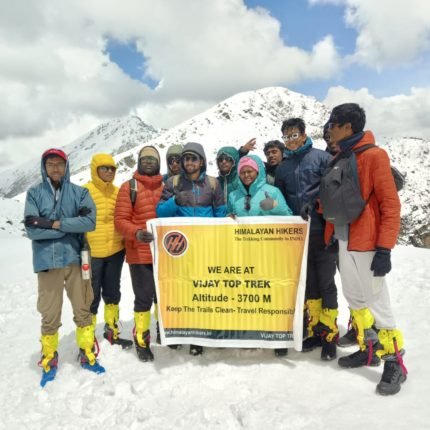
Vijay Top Trek
It’s away from hustle and bustle not known by more people
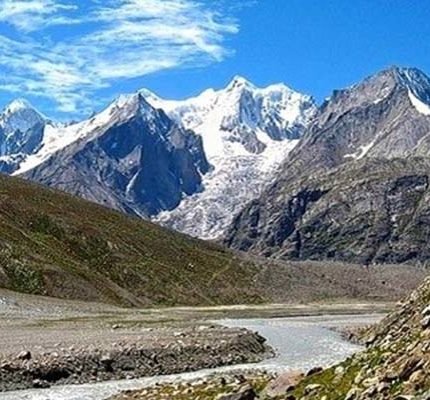
Rumtse to Tso Moriri Trek
Lake Moriri or Tso Moriri trek lies in the Jammu and Kashmir region.
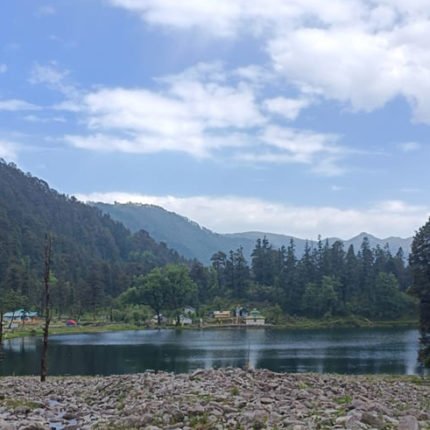
Dayara Bugyal & Dodital Trek
Dayara Bugyal and Dodital Trek follows a similar trek route in Uttarakhand.
Price: ₹ 23,000.00
Book the tour
Book your trek.
- Overview Itinerary Dates Include/Exclude
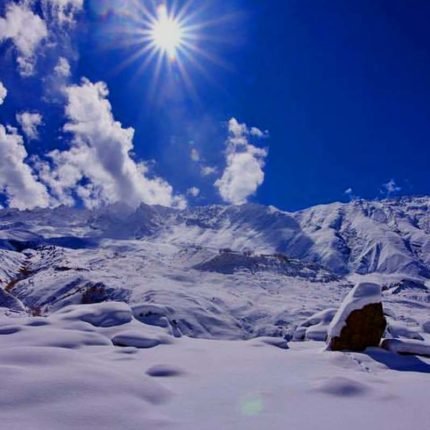

A First-Timer’s Guide to the Chadar Trek in Ladakh India

The Chadar Trek is a trekking expedition unlike any other, an odyssey into the heart of winter’s icy embrace beneath the majestic peaks of the Himalayas. It provides an unparalleled experience for those brave enough to venture through the surreal landscapes of Ladakh’s Zanskar region. However, embarking on the Chadar Trek’s frozen trail, especially for first-timers, necessitates more than just courage; it necessitates preparation, resilience, and a thorough understanding of the challenges that lie ahead.
From selecting the best time to embark on this icy adventure to packing the essentials to withstand the biting cold, from cultivating the physical endurance required to traverse icy terrains to embracing the mental fortitude required to combat the daunting elements, every aspect of the Trek adventure is meticulously planned.
Choose the Right Time
Mental preparation, physical fitness, guided trek, acclimatization, photography, safety first, follow local customs.
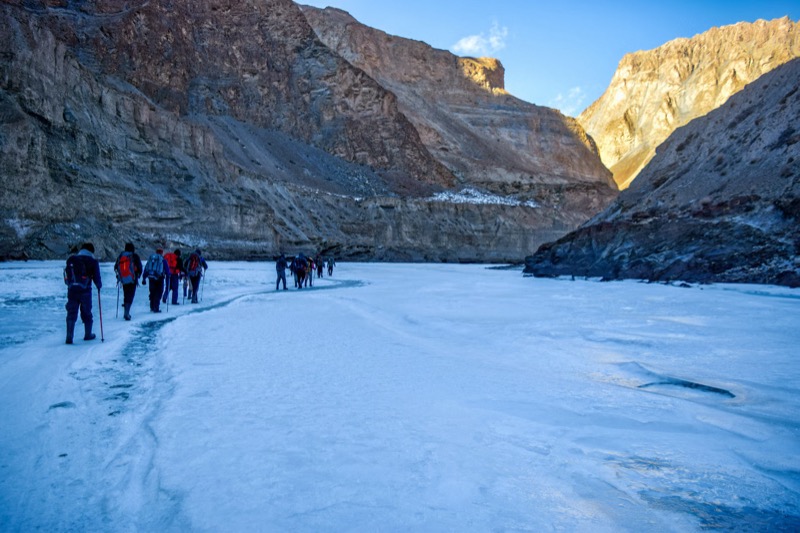
The timing of your Chadar Trek expedition requires a delicate balance of climate and bravery. Choosing to travel during the heart of winter, typically between January and February, is a calculated decision. Temperatures in Ladakh plummet to extreme lows during these months, transforming the Zanskar River into a frozen highway. During this time, the river attains a remarkable level of icy solidity, making it navigable for hikers. The pristine, snow-covered landscape and the frozen, crystalline expanse of the river create an ethereal atmosphere, transporting you to a surreal wonderland. Furthermore, the adventure of Chadar Trek during these months has an added benefit: fewer people, allowing for a more intimate communion with nature.
However, it is critical to stay informed about local climate nuances. Unpredictable weather patterns can alter trekking conditions, making it critical to consult with experienced guides who are well-versed in Ladakh’s climate. By selecting the right time, you not only ensure the safety of your expedition, but you also increase your chances of seeing the raw, untouched beauty of the Zanskar region in all its frozen glory.

Chadar Trek is a mental endurance and fortitude test and a physical challenge. Be prepared to face the vastness of the frozen wilderness and the isolation it brings as you embark on this expedition. Mental preparation is the foundation for a successful trek.
With an open mind, embrace the stark beauty of the icy landscapes. Prepare for the isolation, the biting cold, and the difficult terrain. Understand that discomfort is a necessary part of this adventure; it is in these times of difficulty that you will discover your true strength. Develop a positive attitude and let determination be your guiding star.
The ability to adapt and remain optimistic in the face of adversity will not only enrich your experience. Still, it will also help you overcome the obstacles that the trek may throw your way. Also, be open to the company of your fellow trekkers. Sharing one’s struggles and victories with others not only relieves mental strain but also fosters a sense of community and support.
Engage with the local culture, soak up the knowledge of seasoned guides, and allow the unyielding spirit of adventure to fuel your mental preparation. Remember that, as much as it is a physical journey, the Chadar Trek is a journey into your own resilience, so mental preparation is just as important as the gear you bring.
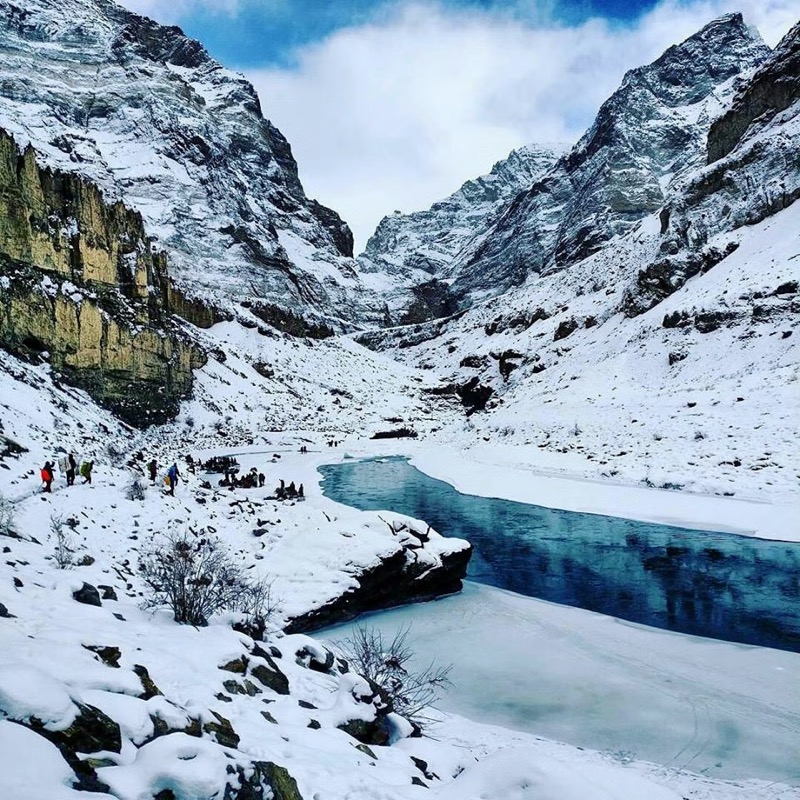
The Chadar Trek necessitates more than a passing interest in physical fitness; it necessitates a robust and well-conditioned body capable of enduring the harsh rigors of the frozen wilderness. The challenging terrain of the trek, combined with the bone-chilling cold, necessitates a high level of physical endurance.
Cardiovascular fitness is critical. To improve your stamina, engage in regular aerobic exercises such as jogging, cycling, or swimming. As you navigate the frozen river and snow-covered trails, endurance training becomes an asset. Lunges, squats, and brisk walking on uneven surfaces will help you prepare your legs for the trek’s challenges.
Flexibility is also essential. Incorporate yoga or stretching exercises to increase your body’s flexibility, which will help you navigate the uneven and occasionally slippery paths with ease. Core strength is your securing force; planks, sit-ups, and other core exercises will fortify your body against the strenuous journey.
Remember that the Chadar Trek is not a race, but rather a test of endurance. The more fit you are, the more you will enjoy the journey. Concentrate on a holistic fitness approach; nourish your body, and it will carry you through the frozen expanse with tenacity and determination. Physical preparation not only ensures your safety but also improves the overall experience, allowing you to fully immerse yourself in the wonders of this icy adventure.
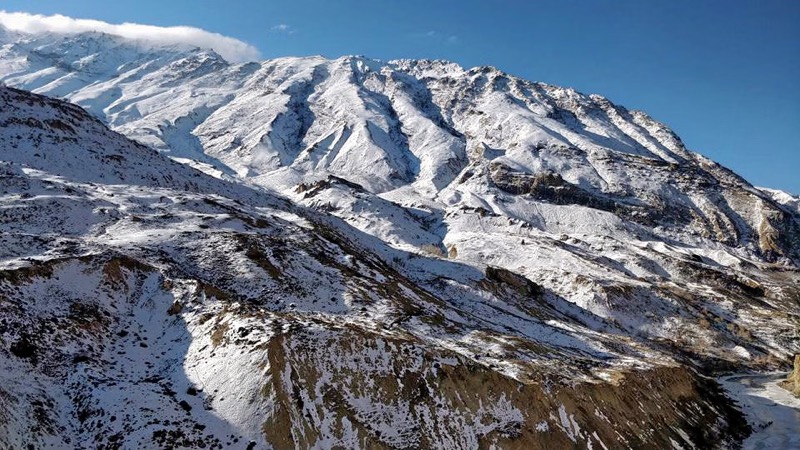
Under the guidance of seasoned experts, embarking on the Chadar Trek transforms an adventurous outing into a safe and enriching expedition. Choosing a guided trek not only ensures your safety but also enhances the overall experience, allowing you to delve deeper into the nuances of this one-of-a-kind adventure.
Expert guides bring a wealth of knowledge about the region that is invaluable. They are intimately familiar with the terrain, weather patterns, and subtle intricacies of the Zanskar River, and can provide critical insights that will enhance your trekking adventure. Their knowledge allows you to concentrate solely on the experience, removing the burden of navigation and logistics.
A guided trek also includes a dedicated support team. These unsung heroes manage the campsite setup, prepare nutritious meals, and handle emergency situations with poise. Their presence ensures that you can focus on taking in the breathtaking scenery rather than worrying about the logistics of the trek.
Guided treks also foster a sense of community among trekkers. Sharing your triumphs and challenges with like-minded people fosters a supportive community, enriching your journey with shared experiences and stories. A guided Chadar Trek is more than just a tour; it’s an opportunity to tap into the collective wisdom of experienced guides, ensuring your safety, expanding your knowledge of the region, and ultimately making your expedition an unforgettable and seamless adventure.
The high-altitude terrain of Ladakh, where the Chadar Trek unfolds its frozen wonders, necessitates a profound respect for nature. Acclimatization, or gradually adjusting to lower oxygen levels at higher altitudes, is not just a precaution but a must before embarking on this difficult trek.
Before beginning your trek, spend at least a couple of days in Leh, the region’s main town. This period is critical for acclimatization, allowing your body to adjust to the thin mountain air. It’s an opportunity to learn about the local culture, sample Ladakhi cuisine, and let your body adjust naturally. Engage in light activities during this time. Gentle walks and short hikes expose your body to subtle changes in oxygen levels, preparing you for the more difficult journey ahead.
Hydration is essential; drink plenty of water and herbal teas to stay hydrated and help your body cope with the arid mountain environment. Acclimatization is more than just a formality; it is your body’s way of preparing for the challenges ahead. Rushing through this process can result in altitude sickness, which can negatively impact your trekking experience.
Accept the slow pace of acclimatization, giving your body the time it needs to adjust. It’s more than just physical preparation; it’s a ritual that honors the mountains’ ancient rhythms, ensuring a safer and more enjoyable Chadar Trek.
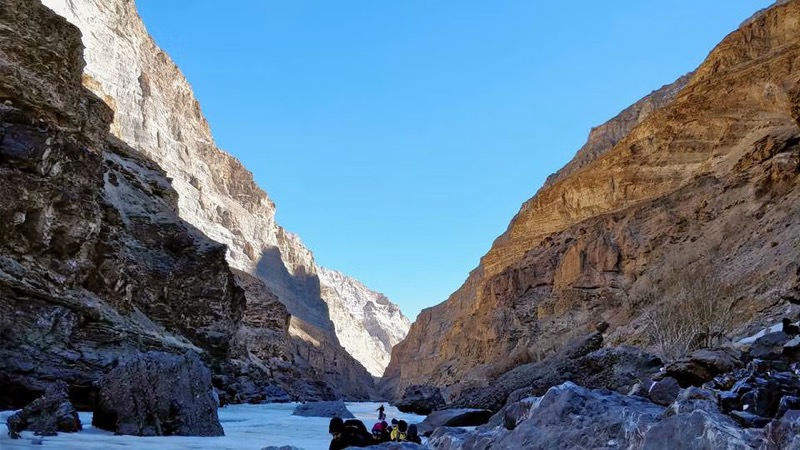
The Chadar Trek is more than just an expedition; it’s a work of visual poetry written in snow and ice, providing photographers with an unparalleled canvas. This frozen wonderland offers captivating opportunities for photographers. Consider your camera a passport to capturing the raw essence of Ladakh’s winter landscape as you embark on this adventure. Every moment is a potential masterpiece, from the early morning sun casting a golden glow on snow-capped peaks to the ethereal play of light and shadow on the frozen river and the vibrant hues of traditional Ladakhi attire against the pristine white backdrop.
Pack your camera with high-quality lenses designed for low-light conditions and extreme cold to capture the nuances of this fascinating environment.
Remember to strike a balance between capturing and living memories. While photography is a powerful tool for freezing moments in time, don’t forget to put your camera down every now and then. Allow yourself to be fully present, absorbing the Himalayas’ silent grandeur, the rhythmic crunch of your boots on the snow, and the warmth of the local hospitality.
Respect the privacy of the Ladakhi people; always seek permission before photographing them, valuing cultural exchange as much as visual beauty. Allow your camera to be your storytelling partner, weaving a narrative of your Chadar Trek experience. Capture not only the icy landscapes, but also the spirit of resilience, the warmth of human connections, and the profound sense of loss through your lens.
One principle reigns supreme in the heart of Ladakh’s frozen wilderness, where the very essence of adventure meets nature’s raw grandeur: safety above all else. With its icy expanse and unpredictable conditions, the Chadar Trek necessitates an unwavering commitment to safety protocols.
Your guides, with their intimate knowledge of the terrain and weather patterns, are your protectors in this icy realm. Pay close attention to their advice, because their knowledge will guide you through this icy maze. Their knowledge ensures your trek remains safe, from identifying stable paths on the frozen river to anticipating potential hazards.
Being aware of your own limitations is also critical. Respect your body’s signals and adapt at its own pace. Keep an eye out for signs of frostbite and hypothermia and take preventative measures. Stay hydrated and well-nourished; adequately fueling your body is not only a comfort but a safety requirement in extreme cold.
In addition, use the buddy system. Trek in pairs or groups, keeping an eye out for one another. The collective vigilance of your fellow trekkers significantly improves safety. Respect the natural environment and stay within designated trekking areas, avoiding unknown or dangerous paths.
In the unpredictable world of the Chadar Trek, safety is a shared responsibility, not a compromise. By putting your safety first and respecting your guides’ knowledge, you not only protect your own journey but also help foster the culture of safety that defines this incredible adventure. Remember that in the face of nature’s formidable challenges, your safety preparations are the most important piece of equipment you have.
The Chadar Trek takes you through the frozen landscapes of Ladakh, into a world where ancient traditions and modern adventures coexist peacefully. Respecting and embracing local customs is more than just politeness; it’s a gateway to a richer, more enriching cultural experience.
With their warm smiles and unrivaled hospitality, the Ladakhi people have preserved their unique way of life for generations. Embrace their traditions, whether it’s savoring traditional cuisine, taking part in local festivities, or learning a few Ladakhi phrases. Such acts not only bridge cultural divides but also foster genuine connections, making your journey more meaningful.
When interacting with the local communities, dress modestly and appropriately. Ladakhis value their traditional attire and customs; by reflecting their esteem, you honor their heritage.
Before photographing people or their homes, obtain permission first. The Ladakhi landscape is more than just a backdrop; it is their home, and their privacy must be respected.
Engage in conversations, learn about their culture, and express your appreciation for their hospitality. By immersing yourself in local customs, you become a participant in Ladakh’s rich cultural tapestry rather than a spectator. Remember, the Chadar Trek is more than just crossing a frozen river; it’s an opportunity to immerse yourself in the soul of Ladakh, one respectful interaction at a time.
The Chadar Trek, located in the heart of Ladakh’s frozen wilderness, is a testament to human resilience, natural beauty, and cultural richness. This extraordinary expedition is more than just a physical journey; it is a profound experience that tests your limits, broadens your horizons, and deeply connects you with nature and humanity. The icy expanse of the Zanskar River leaves an indelible mark on the soul as it echoes with the footsteps of adventurers. The lessons of preparedness, camaraderie, and environmental stewardship learned extend far beyond the frozen trails.
The Chadar Trek is a transformative odyssey that reminds us of our endurance, adaptability, and responsibility to maintain the delicate balance between human exploration and environmental preservation. Whether you’re drawn to the Chadar Trek by the breathtaking landscapes, the cultural tapestry of Ladakh, or the sheer thrill of the adventure, it’s more than just a challenging expedition; it’s a profound opportunity to discover the depths of your own strength and the beauty of the world around you.
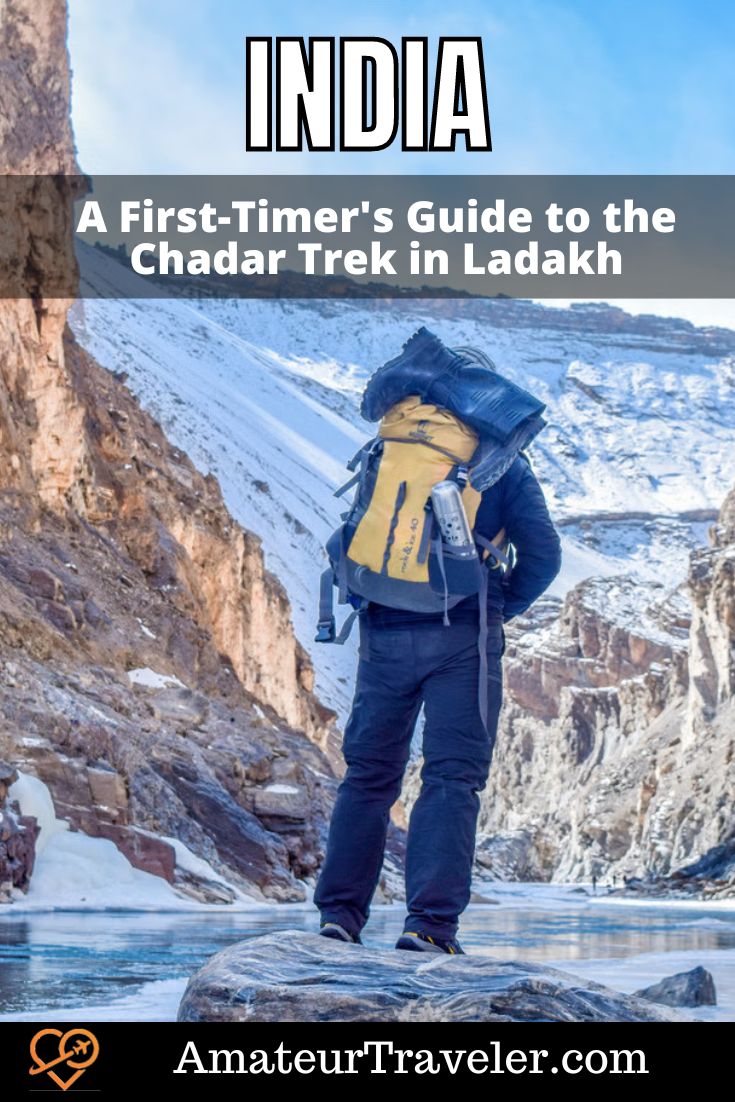
Related Posts
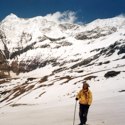
by Pratyush Sogani
Leave a reply.
Name (must be a real name) (required)
Mail (will not be published) (required)
Tags: article , india , ladakh , trekking

Guides / Resources
- Getting Started Traveling
- Guide to Round The World (RTW) Tickets
- 27 Websites for Booking Hotels and Alternate Accommodations
- First Time Cruise Tips – Planning a Cruise
- How to Start an Airbnb – Tips from an Airbnb Superhost
- Travel Resources – What I Pack
- Map of San Francisco by Neighborhood and What to See by Neighborhood
- Guide to the Monterey Peninsula
- Missions of California Map – All 21 California Missions from South to North

Sign up for our newsletter and get the eBook "How To Save Money Booking Your Travel Online"
World Regions

- BloggerBridge
- California Travel
- Episode Map
- Inside Chris's Head Blog
- My CafePress Store
- My Etsy Store
- The Bible Study Podcast
- Tourism Marketing Consulting
- Privacy Policy
- Amateur Traveler Media Kit
- Working with Amateur Traveler
- Pitch me a Podcast Episode
- Guest Post Guidelines
- Travel with Amateur Traveler group
- The Amateur Traveler Manifesto
- find me on BloggerBridge.com

Adventure Pulse
Feel the Pulse of Adventure !!
- High Altitude Treks
- One Day Treks
Everything you need to know about the Chadar Trek/Frozen River Trek
- posted on April 8, 2021 April 26, 2021

The Chadar Trek or the Frozen River Trek is the most popular winter trek in India. A 09-day trek walking on the frozen river of Zanskar and temperatures as low as -30C. Taking place in the beautiful land of Ladakh, the Chadar trek is truly an experience of a lifetime. In winter, as the temperature plummets, a layer of ice develops on the river Zanskar. This layer of ice acts as a highway connecting Leh with the Zaskar Valley and for hundreds of years, Zanskari people have used the ice to travel. The flat ice saved them time as it cuts down the trek up and down the passes. Nowadays, with a road network being constructed, the ice is used as a trek taking people from the village of Chilling to Nerak in the middle of winter.
Winter in Ladakh is truly a mesmerizing spectacle. With light snow covering the arid landscape, Ladakh transforms into a new place where the day starts when the sun is at its zenith. Leh Market becomes the main hangout spot with people relaxing on the benches taking in the sun. The few restaurants that are open act as garlic soup and Timok dispensers.
How cold is it on the Chadar Trek?
Very Simply, extremely cold. The temperature while on the Chadar can plummet as low as -30C. As the river flows at the bottom of the valley the temperature is the lowest there. A slight breeze moving downstream adds to the wind chill as well. Even though you only cover around 50 kilometres, the cold makes the Chadar Trek one of the harder treks on our roster.
While on the trek you’ll have to wear close to 5 layers of clothes and at night, hot water bottles are the only respite from the cold. As you walk during the day, your body heats up (alas just a little) and stopping even for a sip of water seems like a chore. You will be shivering most of the time and everything not near your body will freeze, even cold creams. Devices last a mere 5 minutes in the cold and the act of taking pictures will remind you of the Kodak days.
After all this, you might be wondering as to why we love the Chadar Trek? It’s because we’re crazy, but aren’t we all?

How do you expect to survive the cold?
As mentioned above, the best way to survive the cold is the technique of layering. In short, Layering is several clothing items worn in sequence for protection. While on the trek, your superhero costume is going to comprise of a base layer or thermal, a regular t-shirt, one or two fleece jackets, a down jacket and a windcheater. All this ensure that the precious heat your body produces doesn’t get lost to the air. The clothing acts as an insulator from the cold. Chemical heat/warm packs can be used to keep your extremities warm. If the sun is out, you’re in luck, the temperatures will be relatively warmer (maybe a couple of degrees warmer).
We at Adventure-Pulse provide dual sleeping bags to sleep in at night. These sleeping bags come with an inner liner that fits into a waterproof outer layer. These are similar to the ones used by the army at their High-Altitude outposts. Additionally, our Alpine tents work better at insulating and wind protection as they are made from canvas as opposed to polyester or nylon.
We encourage clients to also carry hot water bags. These rubber bags will be filled with hot water at night and can be strategically placed to keep you warm.
Nibbling on chocolates and dry fruits provided your body with much needed sugar that it instantly converts into heat. We encourage clients to carry sweets and chocolate with the most sugar as it is what will keep you warm.

What’s the itinerary like?
You can find the full itinerary here .
The trek is a total of 9 days and 8 nights in Ladakh. As mandated by the Leh Authorities, as you land in Leh, you’ll be expected to spend 3 nights in Leh before you head off for the Chadar Trek. This is so that your body has enough time to acclimatize to the altitude. The first day is spent in the hotel and maybe a hike to the Leh Market in the evening. Day two is when we’ll hike up to Shanti Stupa and Leh Palace.
On the third day, Adventure-Pulse representatives will escort you for the mandatory medical check-up and insurance purchase. Here the local doctor will check your oxygen saturation, blood pressure and pulse. Only on their approval will you be able to head to the Chadar. Most people meet the requirement as after three days, your body can adjust to the altitude.
After you’ve cleared the medical, the next day is when we’ll head off to the Chadar. You will spend 4 nights on the Chadar, slowly journeying to Nerak and back.

Where will I be staying?
The night on Chadar Trek will be spent in Alpine Canvas Tents on a double sharing basis. The Canvas tents will be lined with 3 layers of foam on which your sleeping bag will be placed. As written above, the sleeping bags will be dual-layered with a polyester fill. There are specific camping sites on the bank of the river, which the Leh District Administration has designated. These locations historically were used by Zanskari Traders as they have caves that protected them against the elements. These caves are still used by some of the porters and can be explored when you reach the campsite.
In Leh, you will spend 4 nights in a comfortable hotel near Leh market. The hotel will be fully heated and equipped with a water supply. We encourage our guests to use minimal water as Ladakh is a cold dessert.
What will I be carrying while on the trek?
For a list of items to carry on the trek, we would recommend going through this list .
While trekking, your personal bags with most of your items will be loaded on sledges in the morning. You will be able to access this bag only once we reach the next campsite. Most of the clothes and stuff that you don’t need while trekking should be packed into this main bag. A good duffel bag (80-100 litres) or a rucksack (50-70 litres) can be used as your ‘main’ bag. If you have some clothes or miscellaneous items that you do not wish to take on the trek, they can be left at the hotel and we’ll ensure you get them at the end of the trek.
On your back, you’ll have to carry a small daypack (15-20 litres) with water and your packed lunch. This will act as your ‘secondary’ bag. You will need to carry your daypack and we would recommend keeping it as light as possible.
What kind of food will be provided on the trek?
On the trek, our staff will be carrying a kitchen tent with all the ration. They will accompany you for the entire duration of the trek.
As you wake up in the morning, you will be provided with hot coffee or tea with some biscuits. It is important to stay hydrated in the mountains and the best way to consume liquids is in the form of hot beverages. Tea and Coffee will also be available for breakfast and in the evenings.
For Breakfast, you can expect parathas, bread and jam, poha, oats and noodles. We will try our best to provide an assortment of food and avoid repetition. Hot lunch will be provided at a predestined rest stop.
The Dinner Menu will include items such as fried rice, Hakka noodles, biryani, Dal-Roti-Sabji-Rice among others. We will also provide soup and dessert before each supper.
What is the strength of the support staff on the Chadar Trek?
Each group will have a lead guide and numerous assistant guides (depending on the strength of the group). The guide’s responsibility is to keep you safe. They will make sure that the group is following the right route and at the right pace. They will also be your Single Point of Contact with the staff. The guide will be from the area and will also have access to the necessary paperwork. In the case of an emergency, they will also organize the necessary evacuations. The assistant guide will assist the guide and will either walk behind the group and/or in the centre. They will make sure that no person will be trekking alone and that the group does not spread out too thin.
If you wish, we can also hire a dedicated assistant guide who will walk with you the entire time. They will make sure that you follow the right pace and will be able to check on you on a more personal basis.
Along with the guides, you will also be accompanied by a Cook, who will cook all the meals. If it’s a large group, there will also be a kitchen helper/s.

How do I get to Leh?
The easiest and only way into Ladakh in winter is to fly. There are daily flights from New Delhi and Mumbai to Leh. We would recommend booking a seat on the right of the aircraft while landing into Leh. Flying over the snow-capped mountains is the perfect way to start the trek of a lifetime.
How do I Prepare for the Chadar Trek?
Like most treks, a certain level of fitness is required. For a sample fitness plan, you can refer to our plan here . If you are a fit individual, dedicated training for 15-20 days should be more than enough. You can contact us at [email protected] and we’ll be happy to help you draft a fitness plan for your needs. A large portion of trekking is the mental fortitude and your ability to push yourself regardless of your physical fitness.
Share this:
« mountaineering courses and institutes in india: a definitive guide., everything you need to know about the markha valley trek in ladakh ».
Suchit Bawa
A keen Mountaineer and Rock Climber. Graduate from Symbiosis Centre for Management Studies, Pune and have completed both Advance and basic Mountaineering courses from HMI, Darjeeling.
Leave A Comment Cancel reply
Post Comment
Quick Links
- Registration Form
- Upcoming Events
- Our Everest Story
- Media Coverage
WANT TO SHARE YOUR TREKKING EXPERIENCE?
We at Adventure Pulse love to hear your trekking stories, especially the outrageous ones. If you have a trekking story, send it to us at [email protected] as a blog or photo blog and we’ll be happy to publish it on our website. HAPPY TREKKING!
- Weekend +91 87 6262 3333
- Himalayan +91 9886 444 809
- International +91 84968 85968
- [email protected]
- One Day Treks
- Two Day Treks
- Himalayan Treks
- International Treks
- Private Treks
- Group Adventures
Featured Tour
Chadar Frozen River Trek Guide
- Guide to Chadar Trek
Introduction to the Chadar Trek
Chadar Trek, as the name suggests, is a beautifully frozen carpet of ice in the Zanskar region of Ladakh. The Chadar trek is one of Ladakh's most popular and unique treks and attracts trekkers from all over the world. It is considered one of the most difficult treks in India as it involves walking on a frozen river. But this isn't the negative side of the trek. If everything goes well, it can be an experience of a lifetime.
This page is your comprehensive guide for the Chadar trek. Here, we have consolidated all the information you need to safely complete the Chadar trek. This guide will help you with a general overview to understand the nuances of the Everest Base Camp Trek, along with links to a lot more information like - Chadar trek difficulty, the best season for the Chadar trek, physically preparing for the Chadar trek, things to carry, how to go to the Chadar trek, and a lot more!
1. Chadar Trek – 10 Reasons why Chadar frozen river Trek is the greatest adventure of all time
Here's why you should choose to do the Chadar trek -
It is the most challenging trek in India
The route is a 1000-year-old path
Chadar trek best time to visit is only in winter trek; you get to trek on a frozen river
The Chadar trek distance is 105 km long. The path is covered with a sheet of ice.
Chadar trek temperature can go as low as -15 to -25°C
Unpredictable weather
Climbing and maneuvering on the solid white sheet of ice is challenging
You get to spot snow leopards
Frozen river expedition within a closed canyon valley offers serene and extremely picturesque locations
Spot the famous frozen gigantic Nerak waterfall
Read more here: https://www.treknomads.com/blog/10-reasons-why-chadar-trek-is-the-greatest-adventure-of-all-time/
2. Chadar frozen Zanskar river trek – Getting fit for the Chadar trek
As we know that the Chadar trek in Ladakh is the most challenging in India, we must remember that we should have an excellent fitness level to match the trek's requirements. The Chadar trek height is at the height of 11,150 ft. Firstly, no matter how good a trekker is, you must continue practicing specific exercises and follow a good workout routine to be a good fit for the Chadar trek. Secondly, training your body is not enough; you must also train your mind to face tough situations. We suggest working out at least eight weeks before your trek to adjust adequately to the high altitudes. We have one full blog on a fitness regime for the Chadar trek. Our fitness experts have planned the regime concerning the trek's requirements. Do check out the link below-
Read more: https://www.treknomads.com/blog/guide-getting-fit-chadar-trek/
3. Chadar – Things to pack for the Chadar trek
The Chadar trek to Ladakh will be extremely tough due to the temperature drop; if you don't carry your warmers and other essentials, you will have a tough time on the trek. However, you do not need to burden your shoulders with extra things. Please do not overstuff your bags. Carry lightweight clothes that can keep you warm. For example, woolens add bulk to your bags and occupy a lot of space. Hence, you can replace woolen jackets with fleece jackets. You will also need winter skincare essentials such as moisturizer, lip balm, sunscreen, etc. to protect your skin in sub-zero temperatures. Lastly, remember to carry toiletries, sanitary kits, and first aid kits in case of minor injuries.
Read more: https://www.treknomads.com/blog/things-to-pack-for-the-chadar-trek/
4. The Common FAQs about Chadar Trek Answered
TrekNomads is always keen on resolving the client's queries and doubts. The Guide to Chadar Trek might keep pinning questions to your minds. Don't worry! Our customer-focused team tries its best to answer your questions. We have collected a list of commonly asked questions by our clients and answered them in a blog. It covers all questions, from the Chadar trek cost to the food accommodations and arrangements our team makes during trekking. Visit the link below to get access to the FAQ blog.
Read more: https://www.treknomads.com/blog/common-faqs-about-chadar-trek-answered/
5. Preparing yourself mentally for the Chadar trek
The Chadar trek is undoubtedly an outstanding trek in India, but it is equally tricky. It requires lots of mental and physical preparation to face the challenges that come your way. You must get used to the extreme cold, tiring walks, and challenging trails. You can do this only if you are mentally prepared for the trek. No matter how physically fit you are, if your mind isn't trained well to face these challenges, you will end up facing a lot of issues. Trust us; we have seen a few such cases during our trekking journey. This is why we bring you all the required information related to each trek. We believe 'the well-informed you are, the well-prepared you will be.'
Read more: https://www.treknomads.com/blog/preparing-yourself-mentally-for-the-chadar-trek/
6. Chadar – Nutrition during the Chadar Trek
You will need more energy to explore the beauty of the Chadar trek route. How will you get that? No, you don't need to have any heavy meals that could make you feel bloated and sleepy. Also, we want you to avoid eating food that makes you burp. Please! We don't recommend non-vegetarian diets either. A vegetarian diet rich in carbohydrates, protein, and the required amount of fat is sufficient. We recommend carrying some instant energy bars, dry fruits, and snacks that provide more energy when you are about to get tired.
With so many variables in the equation, we understand that it can take time to finalize the list of foods to carry with you on the trek. However, TrekNomads will simplify this for you. Read the blog to learn more:
Read more: https://www.treknomads.com/blog/chadar-nutrition-during-the-chadar-trek/
- Testimonials
- Customized Private Treks
- Corporate Outings
- Cancellation Policy
Online booking system by Vacation Labs | © 2024 TrekNomads

The Chadar Trek – India’s Frozen River
Chadar Trek, known as Zanskar Gorge or The Frozen River, is the most thrilling hike in the Himalayas, and there is no other like it. Chadar means “white sheet,” hence the name.
The Chadar Trek is one of India’s most unique and challenging treks. The multiday Chadar hike across the frozen Zanskar River in Ladakh occurs from late January to late February or sometime in March, depending on the weather. Walking on the thick glass of an icy river with great mountains on either side is a once-in-a-lifetime experience.
Photo Credit: Sumita Roy Dutta Wikimedia Commons
Coming in at 11,150 feet, the Chadar Trek almost feels like an expedition to the North Pole. Temperatures drop to 30 degrees at night, all food and drink are transported on sleds, and you must find refuge in caves. By all accounts, taking on The Chadar Trek is on many people’s bucket lists – especially thrill-seekers that enjoy challenging hikes. The area’s local people are known as Zanskari, whose main occupation is cattle-rearing and farming.
This post may contain affiliate links. Please read our disclosure and privacy policy for more information.
Reasons To Take On The Chadar Trek
The Chadar Trek is one of the unique treks in the world. You are hiking the surface of a frozen river. Other hikes in India are through hills and mountains that pass through passes and caves, ancient forts, and valleys. This one meanders along the Zanskar route, where the ice is thick enough to walk on.
A Whole New World Visiting The Chadar Trek
The Chadar Trek will force you out of your comfort zone. Far from civilization, you will be cold most of the time. Try butter tea (which not everyone likes), and be at the mercy of nature, but only for a few days. You will get a new understanding of life far away from the cities and be one with nature.
You will learn a lot about Ladakhen and its challenges. It is a humbling experience, and you will develop a deeper appreciation for the comforts and privileges of your daily life.
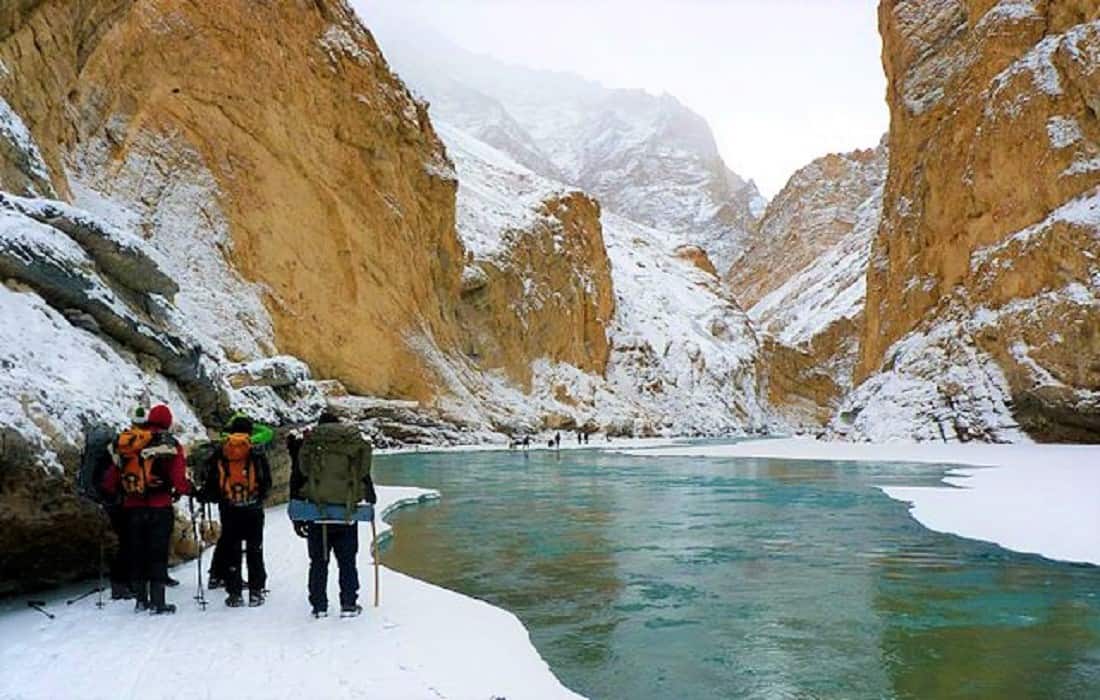
Photo Credit: Sumita Roy Dutta Wikimedia Commons
See Places You Have Never Seen Before During The Chadar Trek
Winter brings dramatic changes to the Ladakh landscape. This high-altitude desert offers the most spectacular views thanks to the Zanskar River, especially in the valley.
Experience waterfalls that have frozen over and form icicle walls that tower over your head. You will see air bubbles from the river frozen under the ice. On some trek sections, you hike on a thick layer of ice under which the river swirls. Around them, the Chadar changes daily.
If the temperature rises by just a few degrees, the ice melts, breaks, and freezes. You can see mountain goats navigating the steep slopes if you are lucky. The surrounding trees are leafless, and their branches, blackened by the weather, stand out in stark contrast to the surrounding white landscape.
There Is No Other Trek In India Like The Chadar Trek
The Chadar Trek is unique because it takes place on the surface of a frozen river. Other treks in India go through hills and mountains, passes and caves, and ancient forts and valleys. This trek meanders along the Zanskar River. Where the ice is thick enough, you will walk on it. Where the guides think the ice is too thin, you will hike on the frozen banks of the river. You will stop to camp and enjoy the calm river and the starry sky above.
You can see the bonfires of other trekking groups downstream. Enjoy singing lessons and devour hot meals that will make the chilly night less daunting.
One of the Chadar Trek highlights is Tibb Cave , an ancient cave that is becoming popular for all hikers.

The soot from decades of campfires has blackened the cave walls. Someone is constantly stirring a large container of hot and cold soup at any time of the day. Here, you will be offered more tea. The feeling of camaraderie is calming, and you will feel like a true adventurer sharing your experience with fellow hikers.
Tibb Cave Temperature
The temperature is twenty degrees below the freezing point and sometimes even colder!
Bragging Rights
The Chadar Trek hike is not challenging – assuming you are physically fit enough. There are no steep slopes, and no technical training is required. However, it should not be taken lightly. The weather and altitude make this trek challenging. The harsh conditions can put your life at risk if you don’t listen to your guide.
Remember: There is a fast, icy river swirling beneath your feet at all times. But that’s what makes it so special, not everyone daretake up the challenge of the Chadar.
When you return, you will feel stronger and more confident than ever.
Something about an adventure like this makes you feel better about yourself – more accomplished! And when the Chadar hike is over, you will join an elite community of trekkers from Tschadar who have faced everything. Be prepared for shocking looks and many questions as you become the hero of your circle.
Chadar Trek Facts
- Chadar Trek duration: Typically 9 Days and 8 Nights (but it can vary)
- Start and End Point: Guest House in Leh
- Maximum Altitude: 11,123 feet
- Chadar Trek Distance: 62 km
- Level of difficulty: Difficult Chadar Trek
- Temperature: 5 to 15 degrees (daytime) and 15-25 degrees (overnight )
- Last ATM: Leh Market and Airport.
Permits & Rules for the Chadar Trek
To ensure that trekkers are safe and abide by the rules, the Leh Government instituted regulations and permits that you will need to follow & get upon arrival in Leh.
All trekkers must:
- Acclimated in Leh for two days post-arrival & before departing for the trek
- Go through a medical check-up and get a medical certificate from a local medical board in Leh that states that you have acclimated to the altitude and are physically fit to take the trek.
- Mandatorily have trek & personal accident insurance for the trek
- Get a permit from ALTOA post submission of NOC & medical certificate
Nerak Waterfall
One of the Zanskar river hikes highlights a grand waterfall that is completely frozen over from top to bottom – The Nerak Waterfall.
The thick ice sheets forming the Zanskar River resemble a white sheet called “Chadar.” The Zanskar River is best known as the Chadar Trek. While it may seem like a challenging hike, it is not the most difficult. It is a flat hike along the Chadar with minimal inclines. You are in good hands if you can hike for a couple of hours without much stress.
Regarding trekking in India, Chadar is the most glamorous and arduous trek.
In 2019, the local administration required all Chadar Trek participants to undergo a medical examination at the SNM Hospital, Leh post, to receive a fitness certificate.
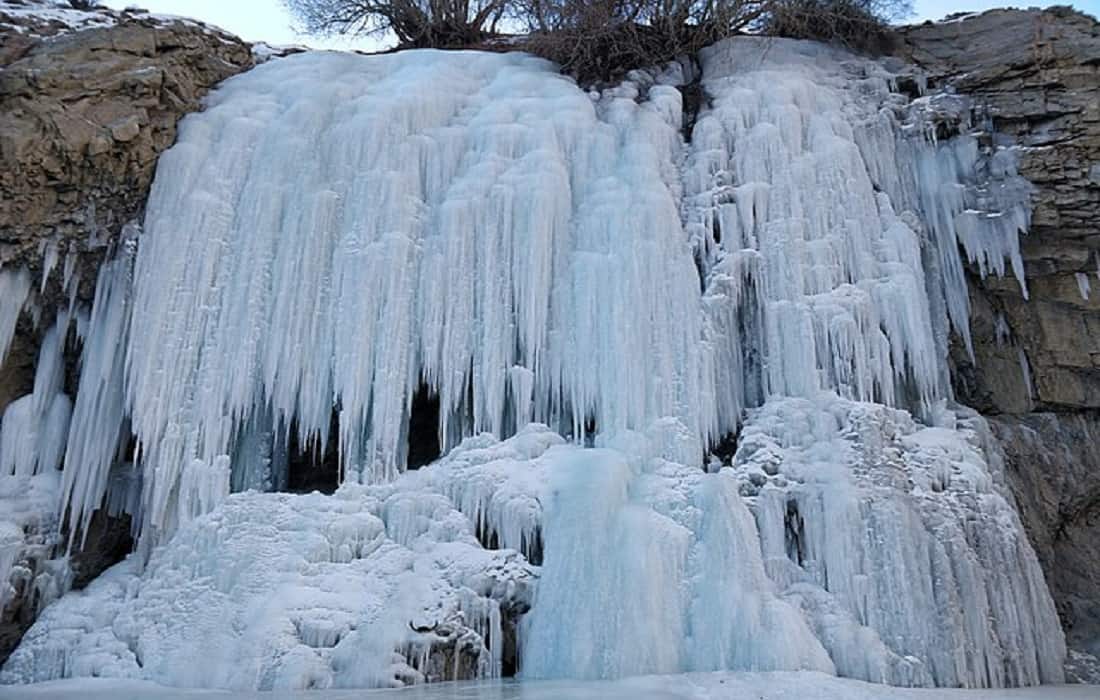
Photo Credit: SukeerthaKrishna Wikimedia Commons
How To Reach The Chadar Trek
Air : The nearest airport to Chadar Trek is Kushok Bakula Rimpochee Airport (IXL), located in Leh. This airport is connected to major international airports in India like Delhi, Mumbai, Chennai, etc.
By Train : Take the New Delhi Jammu Tawi Rajdhani Express, which leaves Delhi at 8:40 pm. and arrives in Jammu at 5:45 am. You can take a bus from Jammu to Srinagar; from Srinagar, there are regular buses to Leh. It is recommended to fly from Delhi to Leh and rent a taxi to Chilling the next day after acclimatization.
By Road : Delhi to Leh is 1,266 km via the NH1. It is 64 km from Leh to Chilling. To get to the Chadar Trek, one has to go to Leh. From Leh, the journey begins and leads to the freezing Zanskar River.
From Leh, it takes about 65 to 70 km to reach the trek base camp via Tiled.
Book Your Excursion
Things you need to do the chadar trek:.
- Woolen cap, socks, mittens & scarf
- Warm clothes
- Toilet paper & wipes
- Walking stick
- Day pack (20-30l)
- Water bottle
- Extra pair of socks
- Backpack with waterproof linings
- Fleece jackets and thermals
- Led torch (with extra batteries)
- Lightweight quilt or blanket
- Mosquito & insect repellent
- Waterproof windcheater
Best Time To Visit The Chadar Trek:
The Zanskar River freezes completely at the beginning of January and remains frozen for two months. The best time to do Chadar Trek is from mid-January to early February.
Difficulty Level Of The Chadar Trek:
The Chadar Trek is a unique experience, but the adverse conditions and an astonishing height of 11,123 meters make it a difficult journey. In such a situation, physical fitness becomes critical. A physically healthy person can complete the trek; however, many precautions must be taken.
Places To Visit Near The Chadar Trek
- Tilat Sumdo is a campsite for the Chadar trek where you can view the Himalayas.
- Shinra Koma is 10 km from Tilat sumdo, which has scenic beauty and spellbound tourists.
- Tibb- Tibb offers a beautiful waterfall and cave.
- Nerak- Nerak is the base camp for the trek and is a spot for sunset, which is fantastic.
- Gyalpo – Gyalpo is a campsite located at a bend in the Zanskar River and is imposed by peaks and walls of rock faces that look artificial.
- Diploma – Dibyokma is again a campsite that offers breathtaking views of the Himalayas.
- Lingshed – It is one of Ladakh’s oldest villages and boasts awe-inspiring natural exquisiteness. This region is famous for the Lingshed Monastery, one of Ladakh’s oldest monasteries.
FAQs About The Chadar Trek
As a newbie to trekking, you might wonder whether you can do the Chadar trek as a beginner. As long as you prepare correctly, you can do it . Formerly, the Chadar Trek was considered a challenging hike reserved only for experienced hikers.
India’s most challenging trek is this one. You will cover approximately 105 kilometers on foot during the trek. Daytime temperatures range from -15 to -20 degrees, while nighttime temperatures dip to -25 degrees. Almost all of the trek must be completed on foot.
As a result of the rising threat and fear around the new Covid -19 Omicron variant, the Ladakh administration has decided to suspend the famous Chadar Trek in 2022. Leh district authorities have also agreed to suspend snow leopard sighting expeditions and other winter tourism activities.
It is 65 miles long.
Closing Thoughts
Most people will not think of India when trekking a frozen river. Most will think of Iceland or Patagonia – maybe even Antarctica. And, as stunning and elite as these other locations are, don’t rule out what India has to offer in terms of challenging and unique treks.
Have you done the Chadar Trek? Please share your experience with us here.
Looking For More Travel Inspiration? Start Here?
- Budget Hiking Destinations In Europe – The Best 15!
- Cordelia Cruises – The Only Way To Cruise in India
- Must-Have Camping Gear You Can’t Afford to Miss This Camping Season
- The Gates Of Heaven Bali At Lempuyang Temple
- The Hello Kitty Flight – What To Expect
- Travel To India From USA – 8 Reasons Why You Should!
- Top 15 Things To Do In Bali
- Trekking in the Himalayan Mountains
We participate in the Amazon Services LLC Associates Program, an affiliate advertising program designed to provide a means for us to earn fees by linking to Amazon.com and affiliated sites.
Share with others!
Nikki Webster is a travel writer who covers how to travel while grinding a day job without breaking the bank. Nikki is always in search of off-the-beaten-track experiences and unique stays. She is particularly fond of Florida and writes extensively about the state. She flies around 60,000 miles annually and has visited 74 countries, 50 states, and six continents. You can read all about her travels at www.britonthemove.com or follow along on Facebook, Pinterest, and Instagram.
Similar Posts

Get Your Guide or Viator – Which One Is Best?
Want to schedule an excursion or tour guide? The two largest online providers of travel experiences around the world are probably Viator or Get Your Guide (GetYourGuide). Here, we explore the pros and cons of each. Viator and Get Your Guide are both online booking platforms offering tours and excursions around the globe. Tours aren’t…

The Illusive Scottish Pyramids: The Balmoral Cairns – Unveiling Scotland’s Royal Monuments
In the serene environment of Deeside, Scotland, on the Balmoral estate, visitors can discover a distinctive element of royal heritage— the Balmoral Cairns. This collection of stone cairns, numbering sixteen in total, with an additional cairn on the adjacent Birkhall estate, is a powerful tribute to members of the British royal family and significant historical…
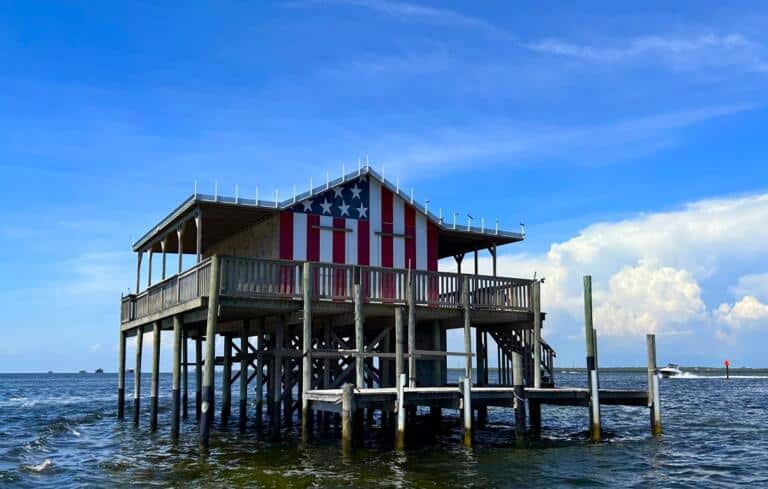
The Stilt Houses of Port Richey, Florida
The stilt houses of Port Richey have a long history in Florida, dating back to the early 1900s. In those days, stilt homes were primarily for fishing camps and other recreational purposes. Located off the coastline of Port Richey, slightly south of Hudson, the nine stilt homes are located right next to Durney Key. This…
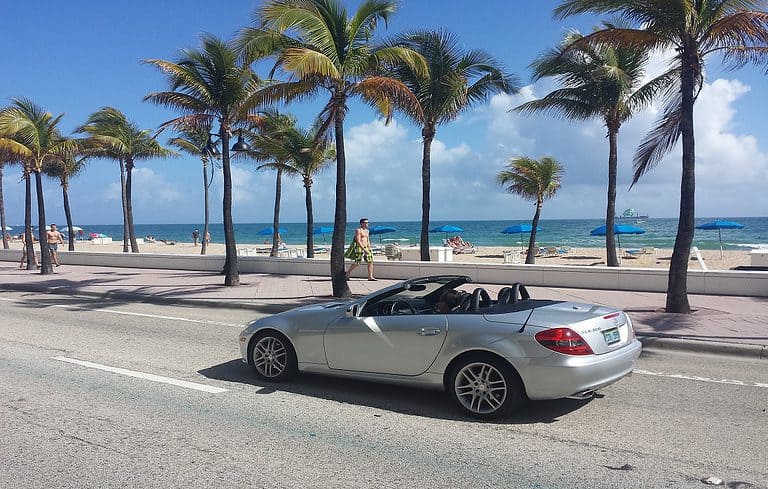
Miami to Key West – Florida’s Best Road Or Boat Trip!
A trip from Miami to Key West promises lots of adventure. Whether you’re flying, boating, or taking a good old-fashioned road trip by car, there’s much to look forward to. Here are all the things you should see and do on a journey from Miami to Key West. This post may contain affiliate links. Please…

Is Travel A Hobby? Let’s Find Out!
Is travel a hobby? A philosophical question that people do not necessarily agree upon. In this article, I’ll explain what a hobby is and what qualifies. Additionally, I will discuss the differences between hobbies, interests, and lifestyles as they relate to travel. This post may contain affiliate links. Please read our disclosure and privacy policy for more…
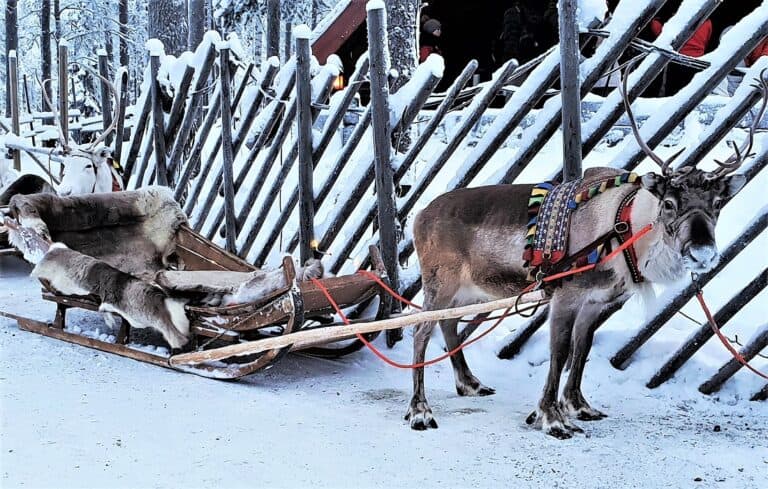
Saariselkä Finland – The Gateway To Lapland
Everyone has fantasized about visiting Lapland, and Saariselkä Finland is a resort village in northern Finland in the middle of Lapland. It is located above the arctic circle, in the Inari region, and home to Sami traditions. Saariselkä Finland attracts visitors from around the world, seeking a winter wonderland escape. Considered Europe’s final frontier, Lapland…
Exploring the Chadar Trek through your guide feels like embarking on a thrilling icy odyssey across India’s frozen river. Your vivid descriptions and practical insights create a compelling narrative, making this frozen adventure come alive for readers. Well done!
I really enjoyed your post, saw the Trek and it was breathtaking.
nice article on chadar trek The Chadar Trek or Zanskar frozen river trek is a winter trek in Zanskar Valley, Ladakh. The trek starts from Leh going through Shingra Koma, Tibb Cave, Naerak Camp concluding back in Leh. The 105 Km trek provides trekkers and hikers an amazing opportunity to trek on a frozen sheet of ice in subzero temperatures. The trek is operational during the months of January and February when the Zanskar river freezes into a solid sheet of ice.
Beneficial information about the treck
What A Great Article.There Are So Many Different Places To Trek.
Leave a Reply Cancel reply
Your email address will not be published. Required fields are marked *
Save my name, email, and website in this browser for the next time I comment.

IMAGES
COMMENTS
WHY IS IT A MUST-DO TREK? The Chadar Frozen Trek, located in the northernmost part of India in the region of Ladakh, is one of the worlds most iconic and challenging treks. The trek takes adventurers on an extraordinary journey along the frozen Zanskar River offering a unique opportunity to explore the starkly beautiful and remote landscapes of Ladakh, complete with breathtaking ice formations ...
Short Itinerary for Chadar Trek. Day 1: The Chadar trek Ladakh starts with your arrival at Leh. Rest for the day or explore the attractions of Leh. Day 2: The second day of your Chadar Lake trek will be your acclimatization day when you will be adapting to the cold weather conditions of the surroundings.
The Chadar trek forms a vital lifeline, connecting remote villages nestled deep within the Zanskar mountains with Chilling, situated along the frozen Zanskar River. This age-old route, historically employed for trade and transportation, is at its most reliable in February when the ice attains optimal stability.
Embark on a journey across the frozen Zanskar River, amidst snow-clad landscapes and majestic mountains. Welcome to Chadar Trek, the 'Frozen River Trek', a thrilling adventure deep within Ladakh's icy wonderland. This blog post offers comprehensive information about this unique trek, from travel and accommodation to gear, guides, and permits.
Something went wrong. There's an issue and the page could not be loaded. Reload page. 46K posts - Discover photos and videos that include hashtag "chadartrek".
The Chadar Trek is one of the most wild and beautiful hikes on the planet. Frequently covered by the world's top adventure channels and media outlets, the Chadar Trek takes hikers through a frozen river valley into the very heartland of India's Ladakh region. The region's harsh desert environment and towering mountains make the Chadar trek ...
We hope, this extensive guide of the wonderful winter trek- Chadar, helps you in keeping all the important things in mind. Snow Leopard Trek in Ladakh 10 Nights / 11 days Rumtse to Tsomoriri Trek 10 Nights / 11 days Chadar Trek in Zanskar 8 Nights / 9 days. Travel Tips. Petrol Pumps on Srinagar - Leh Highway: You Should Know Before Traveling!!
The chadar trek is a trek that follows the frozen river for about 105 km, from Chilling to Naerak and back. The chadar trek is also known as the frozen river trek or the Zanskar trek. The chadar trek is one of the oldest and most traditional routes in Ladakh, as it was used by the local people, especially the Zanskari people, to trade and ...
The Chadar Trek Itinerary. The Chadar Trek follows a mesmerizing route along the Zanskar River, providing trekkers with ever-changing landscapes and unique experiences every day. Day 1. The adventure begins in the town of Leh. Trekkers acclimatize and prepare for the journey ahead. Day 2. An early morning drive takes you to Chilling, the ...
The Chadar Trek is undoubtedly one of our favourite Himalayan treks. The first time we heard about Chadar Frozen River Trek in Ladakh, we were intrigued. When I came to know about the conditions in which we have to trek, I was a bit sceptical. Just imagine walking on a frozen river for almost 8 hours a day at an altitude of almost 11,000 feet.
The Chadar Trek may not have the same glitz and glamour as other hikes in the area, but it's certainly one you'll be able to brag about for years once you've returned home. Useful trail trips. ACCLIMATISATION: The Chadar Trek reaches heights of approximately 3,500m so altitude sickness is a very real possibility. In preparation for the ...
It is a 6-day trek in inhospitable conditions. It is a trek over a frozen river in Ladakh. The average mean temperature during the day is minus 10. At the night, temperatures fall to minus 20 and 25. Ice forms break and change colour on the river every few hours. In places, the Chadar (or ice) does not form over the river.
The Chadar trek officially begins from here and most trekkers end up going till a village called "Nerak ".The Chadar Trek is the only way to access this village in the winter. Amazingly there are almost a dozen families staying here, even though the harsh winter and they stock up on ration for 4-5 months to survive as there is no other way ...
The Chadar Trek, also known as the Zanskar Gorge, is a winter trek that rises 11,123 feet above sea level. Throughout the summer, people flock to the lower region of this valley for river rafting excursions. During wintertime, the Zanskar River freezes, and hikers flock to this area to appreciate the scenery. As part of the 'Chadar' (ice ...
Best Time to Visit Chadar Trek. The ideal time to visit the Frozen River Chadar Trek is between mid-January to February as during this time the upper layer of the Zanskar River freezes. The river looks like a sheet of ice; hence, it is referred to in the local language as 'Chadar' which means blanket. Read more: Hidden Hill Stations In India.
Tilat Sumdo is the campsite for the trek. It is the confluence of Zanskar and a small stream. The trek starts from here. 2. Next comes Shingra Koma, which is almost 10 km from Sumdo. 3. After Koma, on the 2nd day, comes one of the most beautiful spots of the Chadar trek — Tibb. Tibb is full of caves and waterfalls.
Maintaining a good fitness level is essential to tackle the extreme conditions of Chadar Trek. It is recommended to incorporate regular jogging or equivalent workouts for 3-4 km daily for 1-2 months before the trek to prepare your body. In addition, you should also prepare your body for the cold by avoiding hot water, wearing warm clothes, and ...
Chadar Trek In Leh - over the Zanskar River range of Ladakh-2024- Complete information, Itinerary, Costs Date. Your trek journey started with Himalayan Hikers, beautiful mountain town of Leh, all our trekker reach Leh by flight this is best option to you reach to Leh, altitude is 11400 feet above sea level, the trek beautiful Zanskar River which liws totally frozen during the December to Feb ...
The Chadar Trek is a trekking expedition unlike any other, an odyssey into the heart of winter's icy embrace beneath the majestic peaks of the Himalayas. It provides an unparalleled experience for those brave enough to venture through the surreal landscapes of Ladakh's Zanskar region. However, embarking on the Chadar Trek's frozen trail, especially for first-timers, necessitates more ...
The Chadar Trek or the Frozen River Trek is the most popular winter trek in India. A 09-day trek walking on the frozen river of Zanskar and temperatures as low as -30C. Taking place in the beautiful land of Ladakh, the Chadar trek is truly an experience of a lifetime. In winter, as the temperature plummets, a layer of ice develops on the river ...
Chadar Trek. Proceed cautiously on this 48.1-mile point--point trail near Ladakh, Jammu and Kashmir. Generally considered a highly challenging route, it should only be attempted by experienced adventurers. This is a very popular area for backpacking, camping, and hiking, so you'll likely encounter other people while exploring.
It is the most challenging trek in India. The route is a 1000-year-old path. Chadar trek best time to visit is only in winter trek; you get to trek on a frozen river. The Chadar trek distance is 105 km long. The path is covered with a sheet of ice. Chadar trek temperature can go as low as -15 to -25°C.
The Chadar Trek is one of India's most unique and challenging treks. The multiday Chadar hike across the frozen Zanskar River in Ladakh occurs from late January to late February or sometime in March, depending on the weather. Walking on the thick glass of an icy river with great mountains on either side is a once-in-a-lifetime experience.